The post Dale’s Pale Ale Now Brewed With Texas-Made Blacklands Malt appeared first on All About Beer.
]]>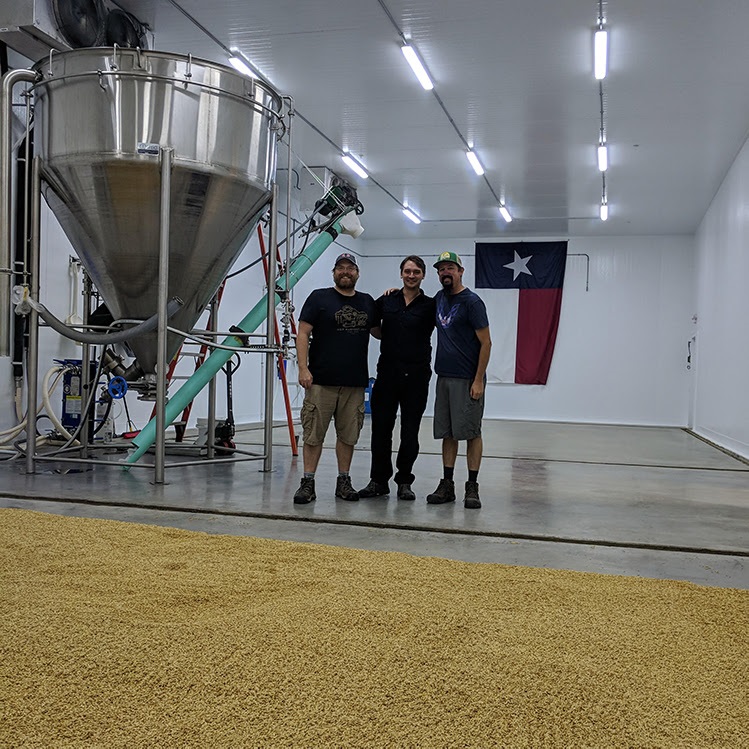
Tim Matthews, Brandon Ade and Michael Harris at Blacklands Malt in Leander, Texas. (Photo courtesy Oskar Blues Brewery)
(Press Release)
AUSTIN, Texas—Oskar Blues Brewery in Austin, Texas, is now brewing their flagship beer, Dale’s Pale Ale, using locally crafted malt developed by neighboring malthouse, Blacklands Malt. The Oskar Blues team is excited to incorporate quality, sustainable, locally-sourced ingredients, while supporting the community and calling attention to the art of craft malting. Dale’s Pale Ale brewed with Blacklands malt is now available throughout Texas and surrounding states.
Dale’s Pale Ale has historically been brewed with commercial Munich malt; but an idea started germinating when Oskar Blues’ Head of Brewing Operations, Tim Matthews, met Blacklands’ founder, Brandon Ade, in 2016. “Two malt geeks get together and before you know it, you’re talking about the future,” said Matthews. “Malt people understand the long term, the agronomic aspects, mother nature, and the pursuit of flavor.”
Ade started Blacklands Malt in 2012. Located in Leander, Texas, approximately 20 miles from the Oskar Blues Austin Brewery, Blacklands was the first malthouse in the modern history of Texas. “I started Blacklands because I wanted to sit in a bar with my buddies, have a beer and know that the malt in that beer was made in Texas,” said Ade. “I wasn’t going to wait around for someone else to figure that out. People should be able to be proud that these products were made right here.” The company uses equipment custom-designed and built in the U.S. and sources grain only from Texas and Colorado.
Ade and Michael Harris, Oskar Blues’ Head Brewer in Austin and malt enthusiast, first started working together by incorporating Blacklands malt into specialty beers; then in the fall of 2017 they started talking about a larger project. Ade said, “I approached Tim and Michael and asked, ‘how can we get this malt out there and capture something unique and authentic going on in Austin?’ The conversation evolved and we started looking at the Munich malts used in Dale’s.”
What followed were months of research and development, and collaboration between the two teams, including the Oskar Blues’ lab headed by Brian Roye. Eventually the kiln schedule and recipe were dialed in to develop Brown Field 10 Texas Munich, which meets the color and toasty flavor profile required to brew Dale’s Pale Ale.
“I don’t know of any other iconic flagships doing something like this,” said Matthews. “And we hope people will start coming into the taproom and saying, ‘I want something with Texas malt in it.’ It’s sustainable, and contributing back to a sustainable world is definitely important to us. This is a major way we can illustrate that.”
Harris has an equally compelling reason for pursuing craft malt – it’s part of supporting the community. “I’ve been interested in where ingredients come from since I started professionally brewing. It’s important to use local ingredients and to be involved in the community,” he said.
Ade added that it’s important to raise awareness around the connection between the consumer and the supply chain, and to call attention to the farmers that grow the barley that ends up in beer. Blacklands has worked with Texas A&M University since 2012 on research that aims to empower farmers to grow barley. “It’s about supporting farm families outside of hops – hops get a lot of limelight. Malting is equally important.”
Dale’s Pale Ale brewed with Blacklands Malt’s Brown Field 10 Texas Munich is now available in Texas and surrounding states. Track it down using the beerfinder.
About Blacklands Malt
Prior to our founding in 2012, no barley, wheat, or rye was grown and malted in Texas for use in beer and spirits. Since that time our founder has been the driving force behind the revitalization of Texas-grown malting barley statewide, providing brewers with access to local malt for the first time in Texas history. We are happy to see that the industry continues to grow in the trail we have blazed. Our privately funded research with Texas A&M started in 2012 and has grown into a much larger statewide effort with public access to the data. Our hope is that this data empowers farmers to pursue barley production as a viable and rewarding crop alternative, in turn creating a robust supply chain for Texas-grown barley.
To find out more about Blacklands Malt, visit http://blacklandsmalt.com/
About Oskar Blues Brewery
Founded over 20 years ago in Lyons, Colorado, Oskar Blues Brewery launched the craft beer-in-a-can apocalypse with their hand-canned flagship brew, Dale’s Pale Ale. Today, Oskar Blues operates breweries in Colorado, North Carolina and Texas while reaching 200,000 barrels per year and featuring Dale’s Pale Ale as the nation’s #4 top-selling craft can six-pack at U.S. supermarkets. Oskar Blues is available in all 50 U.S. states, Washington, D.C., and parts of 17 other countries. Along with Cigar City Brewing, Perrin Brewing Company, Squatters Craft Beers and Wasatch Brewery, Deep Ellum Brewing and Three Weavers Brewing, Oskar Blues Brewery is a member of CANarchy, a disruptive collective of like-minded craft brewers dedicated to bringing high-quality, innovative flavors to drinkers in the name of independent craft beer.
To keep up with all things Oskar Blues, visit http://www.oskarblues.com/
The post Dale’s Pale Ale Now Brewed With Texas-Made Blacklands Malt appeared first on All About Beer.
]]>The post Six to Seek: The Best Beers of the Week appeared first on All About Beer.
]]>
(Photo by Jill McNamara)
FOUNDERS TRIGO
Founders Brewing Co.
Grand Rapids, Michigan
6% | Hoppy Wheat Lager
Trigo is the sixth release Founders Brewing Co. has brewed for ArtPrize, an art competition held every other year in Grand Rapids, Michigan (other past releases for this event include beers like Green Zebra and Mosaic Promise). The nose boasts big aromatics of orange and pineapple that carry through on the palate; it’s clearly been brewed with an abundance of late-addition hops like most IPAs these days, but there’s a balance to the beer. The fruit notes linger on into the finish, along with a slight dankness and firm bitterness.
SAMUEL ADAMS DUNKELWEIZEN
The Boston Beer Co.
Boston, Massachusetts
5.1% | Dunkelweizen
An exclusive to the brewery’s Fall Can Variety Pack, Samuel Adams Dunkelweizen offers a complex nose of toasted malt and clove, with a bit of bubblegum. There’s a bit of grape on the palate, but this one’s all about the marriage of those toasted dark malt flavors with German weizen yeast. It’s a little toasty, a little tart and a little tangy, with a creamy mouthfeel. And it’s as evocative of fall as any other beer in the variety pack, including the brewery’s popular Octoberfest.
CALL TO ARMS BROSÉ
Call to Arms Brewing Co.
Denver, Colorado
4.8% | Raspberry Ale w/ Sorachi Ace Hops & Champagne Yeast
The rosé trend continues with Call to Arms Brewing Co.’s Brosé, which is brewed with organic raspberries from Oregon, Sorachi Ace hops, and fermented with a Champagne yeast. Not surprisingly the raspberries are discernable on the nose, and while they are present on the palate they never come across as overly sweet. It’s doing a disservice to a far more complex beer, but thinking of raspberry-flavored La Croix will put you in the right mind. The hops and malt bill are restrained, so that the raspberries might shine through. The fruit is fleeting though, and a dry finish invites another sip. It’s light, effervescent, and one of the most easy drinking rosé beers I’ve had to date.
MOBCRAFT PEACHY QUEEN
MobCraft Beer
Milwaukee, Wisconsin
6.1% | Gose w/ Peaches, Basil & Cardamom
Brewed in collaboration with Girls Pint Out, Peachy Queen gose is brewed with peaches, basil and cardamom. The tartness and sharp acidity that have become the calling card of kettle sours are apparent on the nose, while the peach is more subtle. It does come through on the palate, where the fruit’s natural sweetness helps balance out the beer’s tartness. The basil is really well integrated; it’s just barely there, but it works well with the sweet peach. Given that the herb works well in lemonade, it’s not surprising that basil works just as well in this tart and citrusy beverage.
FINBACK CHILLBOT
Finback Brewery
Queens, New York City
8.3% | Double-Dry-Hopped Double IPA
Fresh orange zest and pineapple waft from the glass. The first sip reveals more pineapple, mango and just a hint of dankness. Chillbot has a luscious mouthfeel and a substantial bitterness, and it strikes that big, juicy character that so many brewers are striving for these days.
WIDMER BROS. JUICY SUNRISE
Widmer Brothers Brewery
Portland, Oregon
6.8% | New England-Style IPA
Poured from a Crowler, the nose on Juicy Sunrise is sweet and tropical, with notes of mango and passion fruit. It’s properly hazy and lands on the sweeter side of most New-England-style IPAs, with a more delicate melon rind flavor that complements the beer’s juicier qualities.
The post Six to Seek: The Best Beers of the Week appeared first on All About Beer.
]]>The post The Tröegs Snack Bar Puts a Fun Spin on Fine Dining appeared first on All About Beer.
]]>Presented by Tröegs Independent Brewing
Adventurous. Forward-thinking. Experimental. Though these words describe Tröegs Independent Brewing’s beer, they have also come to define the brewery’s in-house restaurant.
“We call our restaurant the Snack Bar because it’s reminiscent of liking snack bars as a kid,” says John Trogner, who with his brother Chris founded the brewery in Hershey, Pennsylvania.

(Photo courtesy Tröegs Independent Brewing)
Don’t let the name fool you though, what’s served at the Snack Bar is anything but the hot dogs sitting under a heat lamp found at most snack bars. Think serious yet playful dishes like little neck clams topped with house bacon, heirloom tomatoes, fresh corn and pesto, or beef tongue tacos finished with tomato salsa, crème fraiche and cilantro. If snack bar food is truly what you desire, look for the foie gras corndog that occasionally graces the menu as a special.
“We develop our Snack Bar menu items much like we do beer recipes with our Scratch Series,” says Trogner. “It’s our way of constantly experimenting and moving forward.”
Each month, Tröegs releases anywhere from three to eight Scratch Beers, many of which tie in seasonal ingredients found within a hundred miles of the brewery, an area dubbed Pennsylvania’s Fruit Belt. This use of seasonal ingredients—often harvested with the help of Tröegs’ employees—allows Tröegs to add terroir to those beers. The beers that garner the best response will be developed through future Scratch releases.
A popular example of a beer that came from this process is Hop Knife IPA.
“That first smell of Hop Knife, when I crack open a bottle, takes me right to the hop fields in Yakima,” says Trogner. “When we’re out there for harvest, walking the fields and talking to the farmers, those notes of citrus, pine, and tropical fruit are everywhere. For me, Hop Knife embodies that whole experience.”
Trogner admits that Tröegs didn’t start out brewing such forward thinking beers like Troegenator, Nimble Giant and Mad Elf.
“We started brewing easy beers and that didn’t go so well. Then we thought, if we’re going down, we might as well have fun doing it,” says Trogner. “Our brewery’s success was built on taking a risk with beer.”

Foeders at Tröegs Independent Brewing. (Photo courtesy Tröegs Independent Brewing)
Each season Tröegs’ creative food team comes up with ideas for the Snack Bar menu by looking at what beers are available and what’s available at local farms. A kitchen team member then takes the ideas, creates recipes, and serves the dishes to the team. Items that make the cut are then tested as specials for customer reaction.
“We are fortunate to have a lot of people with the same mindset—that are smart, passionate, and want to experiment,” says Trogner. “That also makes us our hardest critics.”
This fall, expect a hearty menu of Pennsylvania Dutch comfort foods with a Tröegs twist, like a braised brisket sandwich on brioche with mustard slaw and house steak sauce and duck confit with creamed corn polenta, blistered tomatoes, hot pepper jam and frisee.
“Food that’s fun and interesting, yet accessible for those who may be afraid to step outside the box,” says Matt Lett, executive chef of the Snack Bar. “At the end of the day it’s just food. Our job is to make sure people are fed well and have fun.”
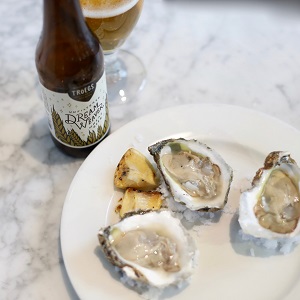
(Photo courtesy Tröegs Independent Brewing)
The brewery’s experimentation with beer and food isn’t limited to the taproom. The brewery helps fans experiment with the intersection of food and beer via their Food Notes program. Available at the taproom and on the company’s website are flyers that highlight which flavors complement, contrast (in a good way), and act adversely with their flagship beers.
“It’s how we teach customers to translate food memory as clearly as possible,” says Trogner.
Pair a complementary piece of fresh mango with Perpetual IPA and notice how the fruity esters from the hops are even more pronounced, or a contrasting piece of basil with Dreamweaver Wheat Beer for an anise nuance that’s reminiscent of an old world cookie. On the adverse side (and something you probably don’t want to try), pair a sour pickle with Troegenator Double Bock for a garlic flavor that unpleasantly lingers on the tongue.
“It shouldn’t be pretentious,” says chef Lett. “A group of friends can get together and do this.”
The Snack Bar is only the tip of the iceberg for all that Tröegs has planned for the future of the brewery’s kitchen. In the works is a house-cured charcuterie program that will be unrivaled elsewhere in the country, with menu items like coppa, saucisson sec, guanciale, wild-fennel tenderloin and duck prosciutto, all from pasture-raised animals from a farm owned by a former Tröegs’ brewer.
“Don’t be surprised if you find an aquaponics farm at the brewery using rain run-off from our building,” adds Trogner. It’s all in an effort for Tröegs to revolutionize food much like they did beer.

Hop selection in Yakima Valley. (Photo courtesy Tröegs Independent Brewing)
For now, though, be on the lookout for the very limited, once-a-year Golden Thing Double IPA release, which hits shelves and taps Oct. 1 and highlights the Lemondrop hop the brew team discovered on their last harvest visit to Yakima Valley.
Bryan M. Richards is a beer, food, and travel writer based in Charlotte. His work has appeared in All About Beer, Men’s Journal, and just about anything with the word Charlotte in it. Follow his adventures on Instagram at @brichwrites.
The post The Tröegs Snack Bar Puts a Fun Spin on Fine Dining appeared first on All About Beer.
]]>The post Dogfish Head to Release First Beer in New Wild Beer Program appeared first on All About Beer.
]]>
(Photo courtesy Dogfish Head Craft Brewery)
(Press Release)
MILTON, Del.—On an endless exploration of goodness, Dogfish Head is proud to be a craft brewery producing and celebrating sour and wild ales for over two decades and is excited to announce the launch of its brand new, funky wild beer program, “Wooden…It Be Nice!” With three wild ales primed for a 2018 Milton-only release, and more releases to come in future years, the brewers at Dogfish have already hand-bottled over two-thousand cork and caged 375ml bottles, each one hand painted with a special stripe signifying its uniquely crafted touch.
“About fifteen years ago, we first started experimenting with sours, beginning with Festina Lente – a peach wild ale that won us a bronze medal at the World Beer Cup in 2006 – then went on to produce SeaQuench Ale which is currently the top selling sour in America,” said Sam Calagione, CEO and founder of Dogfish Head Craft Brewery. “Now, we’re amplifying our wild beer program with Wooden…It Be Nice!, as it’s another step forward in our journey and evolution of goodness incorporating everything from herbs and spices, to local fruits, and of course, bringing it all together in wood.” Dogfish Head is the number one producer of the fastest growing beer in the fastest growing craft beer style in America – SeaQuench Ale, a session sour.*
So what makes a beer wild? It’s different from traditional brewing in that it’s fermented with wild yeast variations, like Brettanomyces and often times with bacteria like Lactobacillus or Pediococcus. The yeast and bacteria are carefully introduced to the wood-aged beer, which can develop a wide array of flavors, including degrees of sourness, funkiness and fruitiness. Due to the untamable nature of the yeast, the beer can sit in barrels for months or even years till brewers deem it ready for consumption. This process can sometimes delay the release of the beer, but when it’s finally ready, it’s truly remarkable. Isn’t that wild?
The “Wooden…It Be Nice!” program opens with the release of KnottyBits, a wild ale (8.2% ABV) aged on sweet and sour cherries and rhubarb, available beginning September 29 at 11 a.m. KnottyBits was wood-aged for a year with Brettanomyces and then racked onto several hundred pounds of sweet and sour cherries and locally sourced rhubarb from Fifer Orchards at a rate of more than 2 lbs. of fresh fruit per gallon. KnottyBits is bottle conditioned for an elevated carbonation resembling a ruby red colored sparkling wine of sorts. Priced at $10/375ml bottle, approximately 2000 bottles will be available for purchase at the Milton Brewery.
Look for Wet Hop American Summer in early November – a Farmhouse Ale (7.75% ABV), this beer was aged in freshly emptied Chardonnay barrels with Brettanomyces for over a year, before being racked onto freshly harvested and hand-selected whole leaf Citra hops, still wet from the fields. The resulting beer has a great citrus aroma from the hops which is a perfect complement to the funky and rustic nature of the Farmhouse Ale base. Wet Hop American Summer is priced at $10/375ml bottle, approximately 1500 bottles will be available for purchase at the Milton Brewery.
In mid-December, the brewery will release Eastern Seaboard, a wild ale (8% ABV) brewed with blackberries and beach plums. After spending almost a year and a half aging in wine barrels, the liquid was met with several hundred pounds of blackberry and Eastern Shore beach plums, handpicked and selected by the brewers. The jamminess of the blackberry and tartness of the plums perfectly pair with one another in this deceptively dry beer. Eastern Seaboard is bottle conditioned to achieve champagne-like carbonation and is violet in color. Priced at $10/375ml bottle, approximately 2000 bottles will be available for purchase at the Milton Brewery.
For more information about upcoming “Wooden It Be Nice!” bottle release dates, visit dogfish.com and Dogfish Head social accounts: Facebook: @dogfishheadbeer, Twitter: @dogfishbeer, and Instagram: dogfishhead.
* (IRI Total US Multi Outlet + Conv 28 Weeks ending 7/17/2018)
Dogfish Head:
Dogfish Head has proudly been focused on brewing beers with culinary ingredients outside the Reinheitsgebot since the day it opened as the smallest American craft brewery 23 years ago. Dogfish Head has grown into a top-20 craft brewery and has won numerous awards throughout the years including Wine Enthusiast’s 2015 Brewery of the Year and the James Beard Foundation Award for 2017 Outstanding Wine, Spirits, or Beer Professional. It is a 350+ coworker company based in Delaware with Dogfish Head Brewings & Eats, an off-centered brewpub and distillery, Chesapeake & Maine, a geographically enamored seafood restaurant, Dogfish Inn, a beer-themed inn on the harbor and Dogfish Head Craft Brewery, a production brewery and distillery featuring a tasting room and food truck. Dogfish Head supports the Independent Craft Brewing Seal, the definitive icon for American craft breweries to identify themselves to be independently-owned and carries the torch of transparency, brewing innovation and the freedom of choice originally forged by brewing community pioneers. Dogfish Head currently sells beer in 43 states and Washington D.C. and will expand into additional states in 2018. For more information, visitwww.dogfish.com, Facebook: @dogfishheadbeer, Twitter: @dogfishbeer, and Instagram: dogfishhead.
The post Dogfish Head to Release First Beer in New Wild Beer Program appeared first on All About Beer.
]]>The post Six to Seek: The Best Beers of the Week appeared first on All About Beer.
]]>
Sixpoint Brevity Wit
Sixpoint Brewery
Brooklyn, New York
6% | Witbier w/ Coriander, Orange Peel, Chamomile & Vanilla Beans
A limited release from Sixpoint Brewery, Brevity Wit is brewed with ingredients both traditional (coriander and orange peel) and untraditional (chamomile and vanilla beans). And if you look to the back of the can, you’ll also find that the beer comes in at 3.9 pH, a bit more acidic than your average Belgian wit.
The beer is indeed tart, but not overly so. There is a burst of citrus on the palate courtesy the orange peel, and the coriander lends a pleasant touch of spice. Those two more untraditional ingredients—the chamomile and vanilla beans—are more subdued, with the soft vanilla coming through in the finish. While Sixpoint has been producing some spectacular hazy IPAs these days, it was this fun blend of old and new that impressed me most this week.
East Brother Red Lager
East Brother Beer Co.
Richmond, California
4.6% | Amber Lager
East Brother’s Red Lager offers up a “biscuity malt presence” as advertised, but there’s more to it than that. There is caramel, but less than you’ll find in most “red” beers. Surprisingly, there’s a good amount of dark fruit—fig, plum, Concord grape—which is complemented by a touch of citrusy hop bitterness. It’s balanced and medium-bodied, clean and crisp—and perfect for food and fall days to come.
Sierra Nevada / Weihenstephan Oktoberfest
Sierra Nevada Brewing Co. & Bayerische Staatsbrauerei Weihenstephan
Chico, California & Mills River, North Carolina
6% | German-Style Marzen
Sierra Nevada collaborated with Weihenstephan earlier this year for Braupakt, a Hefeweissbier brewed with American hops. The two have joined forces once again for Sierra Nevada’s Oktoberfest, a collaboration through which Sierra Nevada partners with a different German brewery each year (Brauhaus Riegele in 2015, Mahrs Bräu in 2016 and Brauhaus Miltenberger in 2017).
Rest assured the world’s oldest brewery and one of craft’s most longstanding both know something of the style. This year’s Oktoberfest offers a rich malt character, with the lightest touch of caramel and toasted bread. There’s a leafy, herbal hop note that calls to mind black tea, with a twist of lemon. It’s remarkably balanced and incredibly refreshing. Enjoy it while it’s here.
Bear Republic Thru The Haze IPA
Bear Republic Brewing Co.
Cloverdale, California
6.4% | New-England-Style IPA
West Coast stalwart Bear Republic Brewing Co., long known for beers like Racer 5 IPA and Cafe Racer 15, has now released a beer inspired by the Northeast. Thru The Haze is brewed with Citra, Vic Secret and Hallertau Blanc hops, and fermented with the Barbarian yeast that so many are using to produce New England-style IPAs.
The brewery’s inaugural hazy IPA doesn’t disappoint, with a big grapefruit punch, followed by orange peel and tangerines. There’s a touch of melon rind as well, but really it’s the grapefruit that dominates this beer’s profile.
Stone Anni-Matter Double IPA
Stone Brewing Co.
Escondido, California
9.1% | Double IPA
Stone Brewing Co. wants to make one thing clear about its new 22nd anniversary double IPA: it’s “perfectly filtered.” Dubbed “the no haze double IPA,” Anni-Matter pours with the same clarity you’ve come to expect from Stone these last 22 years.
There’s not much to the nose of the beer, but then you’re caught by surprise. The first taste reveals big kiwi, grapefruit and papaya notes. Filtered or unfiltered, it comes across as quite distinctive among many of today’s IPAs. There’s a substantial bitterness and an herbal mintiness on the finish.
Avery Raspberry Truffale
Avery Brewing Co.
Boulder, Colorado
14% | Bourbon-Barrel-Aged Imperial Stout w/ Chocolate & Raspberries
The fiftieth beer in Avery’s Barrel-Aged Series, Raspberry Truffale is a bourbon-barrel-aged stout brewed with chocolate and fresh raspberries. Like Plank’d, one of our Six to Seek selections from June, Raspberry Truffale manages to be both big and balanced. The raspberry and chocolate are both discernable on the nose, and the two ingredients are equally balanced on the palate. The raspberry never veers toward artifical or cloying, but instead feels fresh and bright amid a stream of milk chocolate. The bourbon is there, too, but it’s much more subtle than other offerings from Avery. A trace of nuttiness on the finish calls to mind a PB and (raspberry) J.
The post Six to Seek: The Best Beers of the Week appeared first on All About Beer.
]]>The post New Realm Brewing Co. Opens in Virginia Beach appeared first on All About Beer.
]]>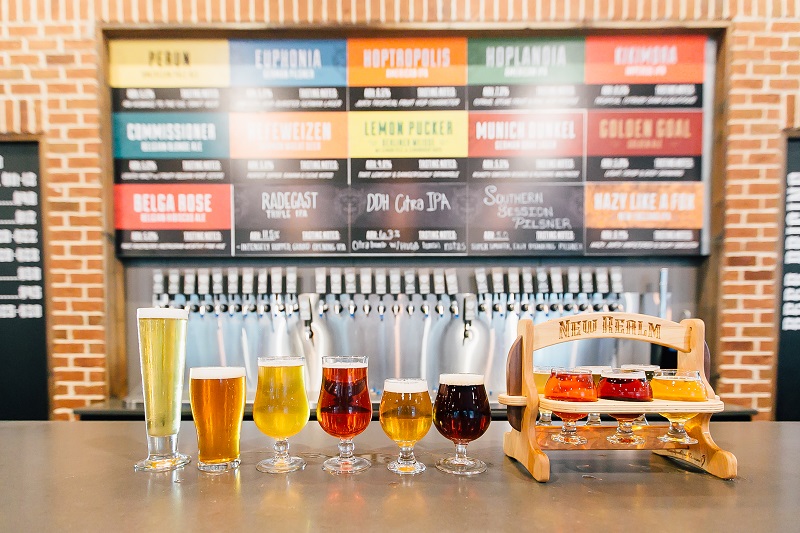
(Photo courtesy New Realm Brewing Co.)
(Press Release)
VIRGINIA BEACH, Virg.–With its flagship location in Atlanta, Ga., New Realm Brewing Company is branching out to Virginia Beach. Co-founded by Carey Falcone, Bob Powers and Mitch Steele, the brewery features a tasting room offering more than 15 different types of beers on tap, a 44,000 square feet outdoor beer garden with fire pits, adult game areas and newly added patio bar, and a large private event space.
With a 50-barrel brewhouse spearheaded by brewmaster Mitch Steele and head brewer Evan Chamberlain, the opening tap list includes the popular Hoplandia and Hoptropolis American IPA brands, Euphonia Pilsner and Kikimora Imperial IPA. Patrons will also enjoy select brews from limited release, small-batch specialty beers seasonally. The facility can brew up to 40,000 barrels annually and is built to scale to even larger capacities in the future.
Local food trucks will be on site daily and bands are scheduled every Friday through Sunday. A full-service restaurant is slated to open in early 2019.
“We’re thrilled to open our doors in Virginia Beach,” said Carey Falcone, co-founder and CEO of New Realm Brewing Company. “The Hampton Roads region is known for a fun, active lifestyle, making it a great place to feature our exciting beers, one-of-a-kind restaurant and inviting event venue.”
With a distribution agreement recently inked with Hoffman Beverage, craft beer fans can now knock back pints at local craft-focused bars, restaurants and retailers in Southside Hampton Roads. Packaged beer will be introduced early in 2019.
“Everyone we worked with at the City of Virginia Beach has been extremely helpful to make this a successful venture for New Realm Brewing Company,” said Falcone. “We are investing heavily in our new Virginia Beach brewery and community by enhancing the quality lab, installing additional Krones Unitanks from Germany, as well as building an outdoor bar, a full kitchen and seating for more than 400 people. We anticipate hiring 105 people at current full capacity.”
The tasting room and beer garden are open Monday through Thursday from 4 to 11 p.m.; Friday and Saturday from 11 a.m. to midnight; and Sunday from 11 a.m. to 9 p.m.
Opening Weekend Events Include:
Thursday, September 6: Music by The Deloreans and cuisine by La Cucina Di Sophia and Hangry’s; Doors open at 7:30 p.m.
Friday, September 7: Music by Brian Schultz beginning at 6 p.m. and cuisine by Pelican Pete’s Pizza and Redwood Smoke Shack.
Saturday, September 8: Music by Michael Clark Band beginning at 6 p.m. and cuisine by Sofrito and Vicki Vails.
Sunday, September 9: Music by Roebuck Band beginning at 3 p.m. and cuisine by Pittsburgh’s Best and 4 Spices Mediterranean.
New Realm Brewing is located at 1209 Craft Lane, Virginia Beach, Va. 23454. For a complete list of hours, information on private events and more, visit www.newrealmbrewing.com.
About New Realm Brewing Company
New Realm Brewing Company is an American craft brewery started in 2016 by co-founders Carey Falcone, Bob Powers and Mitch Steele in Atlanta,Ga. On a mission to rethink tradition and bend the rules, the team planted their first production facility in a 20,000-square-foot space on Atlanta’s east side Beltline trail, featuring a 25hl brewhouse, 3,000-square-foot restaurant, rooftop patio and beer garden. In August 2018, the second location opened its doors in Virginia Beach, Va. Renaissance man and brewing legend, Mitch Steele received the Russell Scherer Award for Innovation in Brewing in 2014 and co-authored the book IPA: Brewing Techniques, Recipes and the Evolution of India Pale Ale in 2012. New Realm Brewing’s core principles are quality, creativity, authenticity, and striving for perfection, all with a customer-centric commitment and approach. For more information, please visit www.newrealmbrewing.com.
The post New Realm Brewing Co. Opens in Virginia Beach appeared first on All About Beer.
]]>The post Six to Seek: The Best Beers of the Week appeared first on All About Beer.
]]>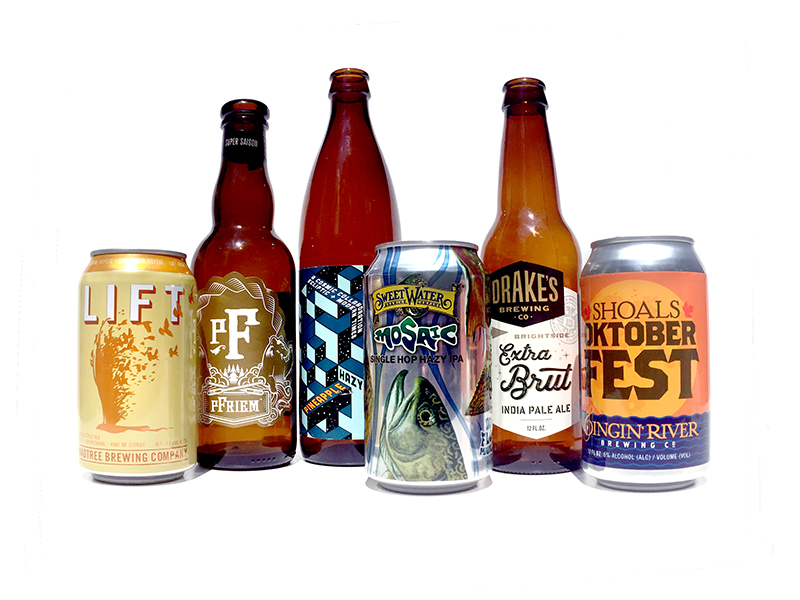
MADTREE LIFT
MadTree Brewing Co.
Cincinnati, Ohio
4.7% | Kölsch-Style Ale
With a light, bready sweetness and crisp finish, MadTree’s Lift nails the refreshing character you want in a Kölsch. There’s soft lemon not out of keeping with the style, but also an orange peel note that suggests American hops are also used. A visit to the brewery’s website reveals that the beer is indeed hopped not just with the more traditional Hallertau Mittelfruh, but also Cascade and Pacifica. They are used sparingly, however, providing enough citrus to keep things interesting without overhopping an otherwise delicate beer. Lift is ideal for these last days of summer.
SINGIN’ RIVER SHOALS OKTOBERFEST
Singin’ River Brewing Co.
Florence, Alabama
6% | German-Style Marzen
When I had Singin’ River’s Citracabra earlier this summer, I was surprised at how restrained the brewery’s kettle sour was–especially considering that beer’s label. No one-trick pony, it turns out Singin’ River is as adept at brewing a Marzen as it is a dry-hopped sour. Shoals Oktoberfest pours amber, with rich Munich malt on the nose. The lightest caramel complements the beer’s toasted maltiness, and a spicy, noble hop profile helps to balance the beer. The result is a beer that’s true to style, exceptionally drinkable and a great choice with or without food.
PFRIEM SUPER SAISON
pFriem Family Brewers
Hood River, Oregon
9.5% | Farmhouse Ale
Often one of the more satisfying aspects of a saison is that big, pillowy head, and pFriem’s Super Saison doesn’t disappoint in that department. This highly carbonated farmhouse ale pours an impressive head that sticks around, giving off sourdough and light lemon on the nose. In addition to the Belgian yeast and a bit of clove, the beer has a gentle floral quality and tart fruit notes (specifically kiwi, with a little pear as well). It’s a Super Saison, indeed–it takes everything you want in that classic farmhouse profile, and then amplifies it.
DRAKE’S BRIGHTSIDE EXTRA BRUT IPA
Drake’s Brewing Co.
San Leandro, California
7% | Brut IPA
After brewing several test batches of Brut IPA, Drake’s Brewing Co. is rolling out kegs and six-packs of its take on the emerging style throughout California. Like many brewers, Drake’s uses amylase enzymes to ferment additional sugars, leaving the beer with an extra dry finish. Brightside is hopped with Centennial, Simcoe, Hallertau Blanc and Hallertau Mandarina, and it’s those latter two that contribute white grape and lemon notes that are well suited to the style’s characteristic dryness. One of the most fun things about Brut IPAs is the way the overall hop profile of the beer changes when the beer is stripped of virtually all sweetness. Doing so doesn’t amplify the tropical, juicy notes, as has been the M.O. over the last few years, but instead changes the nature of the beer entirely.
SWEETWATER MOSAIC
SweetWater Brewing Co.
Atlanta, Georgia
6.2% | Single-Hop Hazy IPA
The latest in SweetWater’s Catch and Release series of seasonal beers, this one is double-dry-hopped with a single hop variety–in this case, of course, it’s Mosaic. One of the most popular hops of the last few years, here it contributes zesty orange and sweet pineapple, though there is surprisingly a little dankness on the nose. There is a touch of wheatiness behind the hop character, and the beer has a refreshing quality thanks to a clean, quick finish that leaves you wanting more.
ECLIPTIC / MODERN TIMES PINEAPPLE HAZY IPA
Ecliptic Brewing Co. & Modern Times Beer
Portland, Oregon
8.5% | Double IPA w/ Pineapple
For its latest “Cosmic Collaboration,” Ecliptic Brewing Co. joined forces with Modern Times Beer, which recently opened a tasting room in Portland. The resulting Pineapple Hazy IPA is also the brewery’s first foray into 500-mL bottles, as “beer drinkers prefer bottles that are a true pint and easier to finish in one pour,” according to Alaric Lawrence, packaging manager at Ecliptic Brewing Co.
The new hazy IPA is brewed not just with fresh pineapple, but also with the Denali hop, which gives off a pineapple flavor of its own. Citra and Mosaic are also used, contributing bright, vibrant notes of nectarine and lemon zest. With a creamy body and an abundance of fruity notes from both the pineapple and the hops, this collaboration is one to seek out.
The post Six to Seek: The Best Beers of the Week appeared first on All About Beer.
]]>The post Six to Seek: The Best Beers of the Week appeared first on All About Beer.
]]>
(Photo by Jill McNamara)
BADGER STATE WI BIEN
Badger State Brewing Co.
Green Bay, Wisconsin
4.7% | Mexican-Style Lager w/ Limes
Badger State Brewing Co.’s Wi Bien is the second lime-infused Mexican-style lager to make our Six to Seek (the first being Hangar 24’s Aventura). Both beers, as so many others in the market right now, show that brewing this broad style isn’t so much about hewing to tradition, but rather using ingredients that put you in mind of the style. “Perhaps as often as anything else,” writes Ken Weaver, “it’s about capturing that vibe of drinking a Mexican lager.”
Lime is an easy way to do that, so it’s no surprise that many are brewing with an ingredient that others are content to garnish any number of Mexican beers. In the case of Wi Bien, which is brewed with both lime zest and lime juice, that tart lime is the most noticeable aroma coming out of the glass. Behind that lime is a sweet pilsner breadiness that helps balance the tartness; and even the limes, too, seem to add their own sweetness. If you’re the kind to occasionally slip a wedge of lime down the neck of a bottle, you’ll find that this does indeed capture that vibe.
HI-WIRE ZIRKUSFEST
Hi-Wire Brewing
Asheville, NC
6% | German-Style Marzen
While some bemoan “seasonal creep” and others wait until at least September to enjoy an Oktoberfest, I’m happy to enjoy the style no matter the weather. It doesn’t hurt that the last couple of days here in North Carolina have been much cooler than usual, a sign that fall is indeed right around the corner.
In my home state, that means thousands will soon journey to Asheville, a mecca for fans of beer and fall foliage alike. Hi-Wire’s Zirkusfest is one of the city’s best Oktoberfest beers, having won a gold medal at the Great American Beer Festival in 2016. With notes of rich Munich malt, a touch of caramel sweetness, a firm noble hop character and a dry finish, this limited release could indeed be enjoyed year-round–but there’s no doubt that it’s best enjoyed during (or on the cusp of) autumn.
ODELL CLOUD CATCHER
Odell Brewing Co.
Fort Collins, Colorado
6.8% | Milkshake IPA
A new “milkshake IPA,” Cloud Catcher has graduated from Odell’s pilot system to all 18 states in the brewery’s distribution. It’s brewed with lactose and double-dry-hopped with Azacca, Cashmere, Citra and Galaxy, which all lead to big notes of pineapple, apricot, tangerine and grapefruit, on the nose and on the palate. It’s no doubt juicy, but there’s a just-right bitterness and a little West Coast character as well. As the brewery notes in its press release for this beer, it can be difficult to scale up hazy IPAs such as this for full distribution–but the brewery has managed to do it.
HOP BUTCHER / ASLIN STEALING SIGNS
Hop Butcher For The World & Aslin Beer Co.
Darien, Illinois
7.5% | Hazy Double IPA
This collaboration from Hop Butcher For The World & Aslin Beer Co. is hopped with Galaxy, Simcoe and the seldom-seen Moutere. It’s that last one, bred from Southern Cross and a New Zealand hop, that seems to give this double IPA an interesting bit of spiciness. Not pepper spiciness, of course, but something more like a sprig of rosemary. It comes across as a little jarring at first, but only because that note isn’t often found in hazy IPAs. It takes just a couple of sips for it to click, with that spiciness complemented by the more expected notes of tangy grapefruit, orange zest and a trace of dankness. With a creamy mouthfeel and a distinctive take on a style everyone’s brewing these days, this one’s worth seeking out.
FORBIDDEN ROOT SPARKLING ROSÉ ALE
Forbidden Root Restaurant & Brewery
Chicago, Illinois
10% | Ale Brewed w/ Niagara Grapes & Hibiscus
The brut and rosé trends show no signs of slowing down, with this latest example coming from Chicago’s Forbidden Root. This one is brewed with Niagara grapes and, like others, gets its pinkish hue from hibiscus. Were you to sip this blind, you genuinely might think you were drinking wine. Not only is it remarkably winelike in aroma and flavor–with notes of lemon, white grape and a dry finish–but it’s about as strong as a wine at 10% ABV. There’s a glimmer of hop character and bitterness, but not so much to bring you back to beer world. And yet, of course, we know it to be an ale- and a cleverly disguised one at that.
FOUNDERS CURMUDGEON’S BETTER HALF
Founders Brewing Co.
Grand Rapids, Michigan
12.7% | Maple-Syrup-Bourbon-Barrel-Aged Old Ale w/ Molasses
The fifth beer in Founders’ Barrel-Aged Series, Curmudgeon’s Better Half is back and released in the brewery’s taprooms today (it should also hit shelves later this month). The brewery made many fans happy when it brought CBS out of retirement, and now they’ve done the same with Curmudgeon’s Better Half, which was last released in 2012.
Like that earlier release, this year’s version is the brewery’s old ale aged in barrels that held bourbon before going on to age maple syrup. The bourbon is most distinguishable on the nose alone, but the first sip reveals a depth of flavor: not only the bourbon and maple syrup, but sweet caramel, rich malt, fig and vanilla. It’s boozy bread pudding in a glass.
Earlier I wrote of how I could enjoy an Oktoberfest all year long, and I can certainly do the same with Curmudgeon’s Better Half. But if you pick up a four-pack or an extra 750-mL bottle, do yourself a favor and stash one away for winter. You won’t regret it.
The post Six to Seek: The Best Beers of the Week appeared first on All About Beer.
]]>The post Six to Seek: The Best Beers of the Week appeared first on All About Beer.
]]>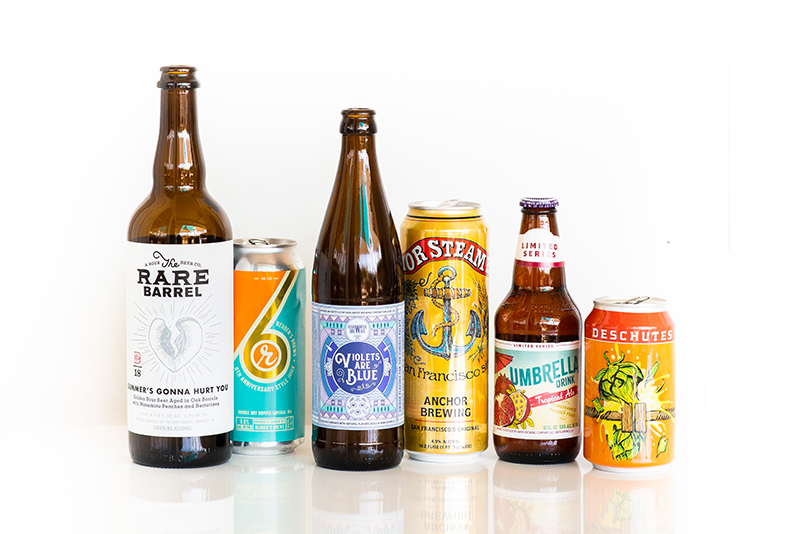
(Photo by Jill McNamara)
ANCHOR STEAM
Anchor Brewing Co.
San Francisco, California
4.9% | California Common
Did you know we’re on the tail end of Drink Steam Week? While there are plenty of events in San Francisco and beyond, you don’t need to be in the city by the bay to celebrate. This is the fourth year that the city of San Francisco has recognized the week, however it marks the first time that you can enjoy the revolutionary Anchor Steam beer in cans–big, 19.2-ounce cans, in fact. If it’s been a while since you’ve had one, you’ll be happy to know that the beer in those cans tastes just as you’re accustomed to finding it from the brewery’s distinctive bottles: with a smooth, lightly toasted malt character, woodsy hops and a flourish of crisp apple on the finish.
ABITA UMBRELLA DRINK
Abita Brewing Co.
Covington, Louisiana
5.8% | Tropical Ale
Given the name and the pomegranate and passion fruit on the label, you might expect Abita’s new “tropical ale” to be little more than a sweet, simplistic fruit beer, something aimed at cocktail drinkers. The fruit used is indeed very present: pomegranate comes through on the nose, a perfume of peach following it. And it’s fruit-forward on the palate, not just with pomegranate and passion fruit but with a bit of melon rind as well.
All of that fruit and sweetness, though, is well balanced the hops; Ekuanot and Centennial add bitterness as well as fruit notes of their own, with big citrus and pine and a medium body thanks to the oats. The beer should no doubt appeal to fruit beer lovers, but fans of IPAs will find much to appreciate as well. The beer captures that tropical feeling, landing somewhere in between the fruity wheat beers of the past and the fruited IPAs of today.
HIGH WATER VIOLETS ARE BLUE
High Water Brewing
Lodi, California
6% | American Wild Ale w/ Boysenberries, Violet Flowers & Orris Root
Part of High Water’s CAlambic (California lambic) series, Violets Are Blue is brewed with violet flowers, boysenberries and orris root (the root of an iris flower) and spent a full year maturing in oak barrels. The beer pours a beautiful plum-colored pour, with a big sour tartness and boysenberries noticeable on the nose. The sourness is assertive but not harsh, balanced by a floral quality from the violet and orris root (I have to confess this is the first time I’ve had a beer brewed with that ingredient). The floral sweetness keeps things from being too acidic, and toasted oak comes through on the finish. The sourness lingers, beckoning another sip.
THE RARE BARREL SUMMER’S GONNA HURT YOU
The Rare Barrel
Berkeley, California
6.3% | Barrel-Aged Golden Sour w/ Masumoto Peaches & Nectarines
A blend of barrel-aged golden sours aged with nectarines and Masumoto peaches, The Rare Barrel will release bottles of Summer’s Gonna Hurt You at its taproom tomorrow (Saturday, Aug. 18). The beer pours bright and light gold, with a highly active yet fleeting head. The aroma offers up a sharp, lactic tartness, with a glimmer of peach. That sharpness on the nose belies what is actually a really refined, moderate sourness, mellowed by fruit and time. In addition to the peaches and nectarines, there are notes of unripe strawberry and even a light cream on the finish.
DESCHUTES FRESH HAZE
Deschutes Brewery
Bend, Oregon
6.5% | Hazy IPA
A new offering in the “Fresh Family” of beers inspired by the brewery’s Fresh Squeezed IPA, Fresh Haze is, as you might expect, billed as a hazy IPA. In truth, the beer pours with more of a caramel color than most New-England-style IPAs. There’s grapefruit and pine on the nose, but the palate is papaya and candied peach. Despite the amber-ish pour, the sweetness comes across as hop driven, and not from caramel malts. The beer doesn’t scream hazy IPA, but it is indeed a fresh, fruit-forward IPA worth trying.
REUBEN’S BREWS 6TH ANNIVERSARY STYLE JUICE
Reuben’s Brews
Seattle, Washington
8% | Double-Dry-Hopped Double Hazy IPA
Released earlier this month to celebrate the sixth anniversary of Reuben’s Brews, this IPA was dry-hopped with Citra, Mosaic, Galaxy and Vic Secret to create a beer that the brewery described as its “juiciest IPA yet.” The nose, indeed, is super juicy; the kind of IPA that fills the room the second you crack the can. There is fresh orange and grapefruit, but also something like bubble gum in the nose–not the archetypal, classic bubble gum you might expect in a hefeweizen, but something more along the lines of Juicy Fruit. There’s an abundance of pineapple on the palate. Despite the beer’s big, juicy character, there is also a decent bitterness and a relatively dry finish.
The post Six to Seek: The Best Beers of the Week appeared first on All About Beer.
]]>The post On Location: Ma Che Siete Venuti A Fà in Rome appeared first on All About Beer.
]]>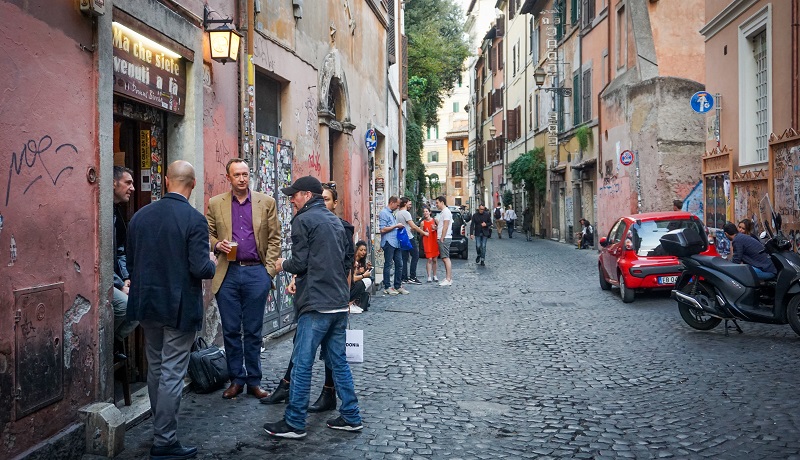
(Photo by Dan Rabin)
Rome’s Trastevere neighborhood, which dates from medieval times, is a web of ancient cobbled streets teeming with trattorias, pizzerias and bars. A lively street scene and animated nightlife draw both locals and tourists to the west bank of the Tiber River for an evening of entertainment. In the heart of Trastevere, you’ll find Ma Che Siete Venuti A Fà, the city’s most famous beer bar and the first to feature independent breweries exclusively.
Despite its understated exterior, the pub isn’t hard to locate. Make your way to the street named Via Benedetta. When you encounter a cluster of people drinking beer and socializing in front of a graffiti-strewn building with a decaying facade, you’ve arrived.
The entry is flanked by a collection of stickers from breweries around the world and is topped by a simple sign displaying the name Ma Che Siete Venuti A Fà. The name translates loosely to “What did you come here for?” and is a soccer chant sung by the fanatic fans of Rome’s Lazio soccer team to taunt their opponents, especially during lopsided matches. In addition to being a first-rate beer bar, the pub is also a local’s soccer bar, and has been throughout its 16-year existence. Macchè, as it’s called locally, can take credit for introducing many a Lazio fan, and numerous other residents of Rome, to the joys of great beer.

(Photo by Dan Rabin)
There’s nothing fancy about the place. You enter into a tiny taproom with counter seating on one side and a small bar on the other. Together, the room seats 10 patrons. Behind the bar sits a row of a dozen copper-colored beer towers, each sporting a hand-written card with information about the beer being dispensed. A modest selection of bottled beers is on display in a refrigerated case mounted on the wall. During my visits, most of the bottles featured wild ales from Belgium and the United States. The ever-changing draft list is posted on a chalkboard on the opposite wall.
Beyond the bar area is a second compact space with table seating that might accommodate 30 people, assuming they’re not averse to close encounters of the beer kind. Televisions in each room broadcast soccer matches without sound while rock music plays in the background. The diminutive size of the two rooms is conducive to befriending fellow beer-lovers from around the world. The locals seem to prefer drinking on the street in front of the pub, which is quite acceptable in Rome.
There’s a downstairs room with a different vibe. Upholstered chairs and cubby-like spaces evoke a more lounge-like feel, suitable for quiet conversation. While the room was seldom used during my visits, it’s here that Lazio fans gather on game days to cheer on their beloved team, according to Macchè’s founder, Manuele Colonna, a Lazio supporter and passionate beer fan who opened the pub in 2001.
Colonna is a well-known figure within Italy’s tight-knit community of independent beer-makers. In addition to showcasing many small Italian breweries at Macchè, Colonna travels throughout Europe in search of beers to serve at the pub. When I ask Colonna how he selects beers, he barely mentions styles. Rather, he stresses the importance of a brewery’s philosophy and of a brewer’s heart and soul. “I like to recognize the brewer’s personality in the beer that I drink,” he explains.
The draft menu lists 15 beers and a cider. Italian breweries are well-represented. Beers from small German and Belgian breweries appear frequently. Styles cover a broad spectrum of German, Belgian, British and American ales and lagers. It’s likely that most patrons, even seasoned beer travelers, will be unfamiliar with many of the featured breweries. One exception is the well-known Cantillon Brewery, whose beers are often available on draft. Colonna has a close relationship with the owners of the revered Belgian Lambic producer.
Servers at Macchè are friendly to a fault and knowledgeable about the beers they serve.
“We like to tell our customers a story behind the beer they are drinking,” Colonna tells me over a glass of kellerbier procured from an obscure Franconian brewery. “That’s really important for us.”
The post On Location: Ma Che Siete Venuti A Fà in Rome appeared first on All About Beer.
]]>The post Six to Seek: The Best Beers of the Week appeared first on All About Beer.
]]>
(Photo by Jill McNamara)
BIG BEND NATIONAL PARK HEFEWEIZEN
Big Bend Brewing Co.
Alpine, Texas
5.5% | Hefeweizen
Big Bend’s National Park Hefeweizen has earned the brewery a number of awards, most recently a gold medal at the World Beer Cup this past May. With bubble gum, banana, clove and wheat bread on the nose, this has the aroma of a true-to-style German hefeweizen. Those notes carry through on the palate, yet the beer feels a little thinner and drinks more cleanly than some examples of the style. That’s not a fault; it’s simply to say that Big Bend’s Hefeweizen comes across more as a hybrid between a German hefeweizen and an American wheat. With a high carb and a light body, it’s easy to see why this super refreshing beer has garnered so many awards.
CARTON JER 1
Carton Brewing Co.
Atlantic Highlands, New Jersey
5% | Pale Ale w/ Oats & Lactose
Jer 1 is part of Carton’s new Brewers Board series, through which the brewers get a chance to flex their creativity by exploring new styles, processes and ingredients. Dubbed a “lact-oat pale ale,” Jer 1 is brewed with a range of different malts (pils, wheat, carafoam, acidulated and oats) and hops (Citra, Galaxy, Falconer’s Flight, Amarillo and Cascade). It is fermented with a London III yeast that is traditionally used for British styles, but which has also found favor among brewers of hazy IPAs as of late.
The nose offers up pineapple and grapefruit, as well as green onion and melon rind. Orange peel, dankness and a light wheatiness come through on the palate, and the beer finishes with a firm bitterness. The oats provide the beer with body, leaving you wanting more after each sip.
ELYSIAN DEF LEPPARD PALE
Elysian Brewing Co.
Seattle, Washington
6% | Pale Ale
This beer, says Elysian, “was brewed to fuse the infamous malt bodies of British ales with the mysteria of Pacific Northwest hops.” Though we’re not sure what British malts did to deserve such notoriety, this beer does not come across as a hybrid of English and American styles, nor does it seem all that pale ale-ish.
But think of this as a hoppy amber ale, and I don’t think you’d be disappointed. A caramel-heavy malt bill is complemented by old-school hops (Cascade, Simcoe, Chinook and Magnum), which contribute sticky, resinous notes of pine and orange peel. It’s a well balanced, refreshing and no doubt food-friendly beer.
BURIAL / OTHER HALF PRISMATIC VISIONS
Burial Beer Co. & Other Half Brewing Co.
Asheville, North Carolina
8.5% | Double IPA
The tenth collaboration between Asheville’s Burial Beer Co. and Brooklyn’s Other Half Brewing Co., Prismatic Visions is double-dry-hopped with Citra, Motueka and Centennial (that last one seems to be making more of a comeback lately). Those hops come through vibrantly, with pineapple and papaya leading the way, melon and juicy orange just behind. Despite the blast of hop flavors and a substantial bitterness, the beer is well balanced. Lactose adds the lightest touch of sweetness on the finish.
AVERY THE KAISER
Avery Brewing Co.
Boulder, Colorado
8% | Imperial Oktoberfest Lager
A couple years ago, Avery Brewing Co. retired seven of its beers–including The Kaiser, the brewery’s imperial Oktoberfest. The fans apparently voiced their displeasure upon not being able to get their perennial fall favorite last year, however, because the brewery brought the ousted dictator back from the dead. And for the first time, The Kaiser is available in cans.
Avery is known for its bigger beers, and at 8% its version of an Oktoberfest is indeed bigger than most. The heftier malt bill amplifies the traditional Oktoberfest notes of caramel and toasted bread, and also brings in some darker fruit. Yet despite the higher ABV, the beer finishes dry and goes down quickly. Though it is still most reminiscent of an Oktoberfest, it somehow manages to also call to mind two other German styles: the richer doppelbock, and the more refreshing festbier. Let’s hope The Kaiser is here to stay.
WILEY ROOTS VANILLA PSEUDONYM
Wiley Roots Brewing Co.
Greeley, Colorado
12% | Rye-Whiskey-Barrel-Aged Imperial Stout w/ Vanilla
This imperial stout from Wiley Roots Brewing Co. spent 16 months in rye whiskey barrels from Denver’s A.D. Laws Whiskey House, after which it received an addition of Papua New Guinea vanilla beans at a rate of a pound per barrel.
Vanilla goes a long way in beer, so you can rightly expect a huge sweetness from this addition. The nose is dominated by it, however there is a subtle tartness present as well that, combined with the vanilla, calls to mind cherry cobbler. It’s a thick and luscious stout, with assertive notes of vanilla, milk chocolate and rye whiskey. Behind those, you’ll find more subtle notes: spice from the wood and whiskey, pecans, and the aforementioned cherry cobbler from the nose manifesting itself more as a cherry almond liqueur on the palate. Sixteen months well spent.
Six to Seek celebrates the best beers we’ve tasted this week. Check out our best beers of weeks past here.
The post Six to Seek: The Best Beers of the Week appeared first on All About Beer.
]]>The post Beer-Brined Scallops Over Asparagus With Stout Romesco appeared first on All About Beer.
]]>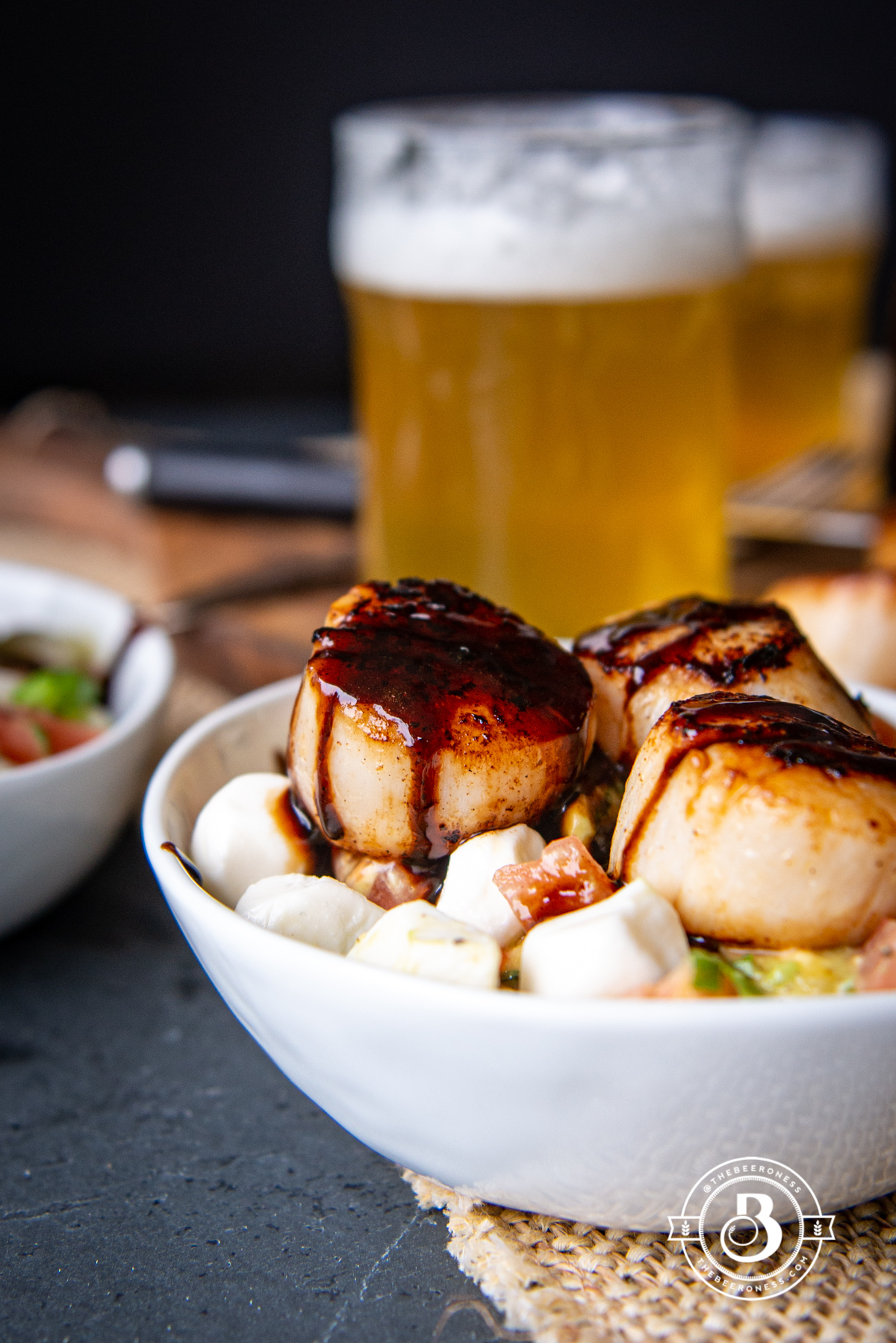
(Photo by Jackie Dodd)
The secret to getting a restaurant-quality sear on your scallops starts long before you heat the frying pan, and it’s an important step that will give your dish a professional level taste. The issue most home cooks have with getting that lovely crust on their scallops has nothing to do with their abilities: it’s the scallops themselves. Most scallops are soaked in a phosphate solution that allows them to stay fresher longer. This same solution prevents the little sea creatures from searing properly and instead lends a slightly “soapy” taste once cooked.
The answer: either buy freshly harvested scallops that never see the need for this freshness extending liquid (hard to do in the vast majority of the world), or give them a good soak in a nice brine. A brine will help “wash” the solution out of the scallops, letting you avoid the soapy taste, and giving you a nice crust. It’s the easiest way to impress your dinner guests with the best home-cooked scallops they’ve ever had. Yield: 4 servings.
For The Scallops
12 ounces pale ale (pilsner, wheat beer or pale lager will also work)
2 tablespoons salt
1 cup water
1/4 cup lemon juice
12-16 large or jumbo scallops
2 tablespoons butter
For The Asparagus And Romesco
2/3 cup sliced almonds
1 large bell pepper, roasted (from a jar is fine)
1 cloves garlic, smashed
1 can (6 ounces) tomato puree
2 tablespoons chopped Italian parsley
3 tablespoons stout beer
1 teaspoon red pepper flakes
1/2 teaspoon smoked paprika
1/2 teaspoon salt
1/2 teaspoon black pepper
1/4 cup olive oil
1 pound asparagus, trimmed
3 tablespoons butter
Salt and pepper
Preparation
1. In a large bowl stir together the pale ale, salt, water and lemon juice.
2. Add the scallops, cover and refrigerate for an hour.
3. rain the scallops and place on top of a stack of paper towels. Add another layer of paper towels and allow to drain and dry for 15 minutes.
4. Make the romesco. Add the almonds to a pan over medium high heat. Pull the pan back and forth across the burner to toss the almonds until they have lightly toasted, about three minutes (keep a close eye, they burn quickly).
5. Add the almonds, red bell pepper, garlic, tomato puree, parsley, beer, red pepper flakes, smoked paprika, salt and pepper to a food processor.
6. Process for about one minute, then slowly add the olive oil until well combined (romesco can be made several days in advance, store in an air-tight container in the fridge until ready to use).
7. Melt two tablespoons butter in a skillet over medium high heat until very hot. Add the scallops, flat side down, and allow to cook until a dark golden brown crust forms on the bottom, about two minutes. Flip and cook until seared on the opposite side. Remove from pan when a slight hint of translucent pink still remains at the center—don’t overcook.
8. Melt three tablespoons butter in a large skillet over high heat (you want the asparagus to form a nice char but to still retain a good bite and not get soggy, if the heat is too low the asparagus will overcook before getting the desired char). Add the asparagus, tossing until most of the asparagus has charred slightly on one or both sides, remove from pan.
9. Plate the asparagus, top with romesco sauce and scallops, serve immediately.
The Chef’s Pairings: Yuzu Beers
Brewers continue to experiment with specialty ingredients, pushing the boundaries of flavor. Since a good beer deserves a good meal, All About Beer Magazine asked Jackie Dodd, founder of TheBeeroness.com, to taste a few beers brewed with yuzu fruit and offer tasting notes and pairing suggestions. Get more pairing ideas and recipes at allaboutbeer.net/food.
The post Beer-Brined Scallops Over Asparagus With Stout Romesco appeared first on All About Beer.
]]>The post Guinness Brewery Debuts in Maryland appeared first on All About Beer.
]]>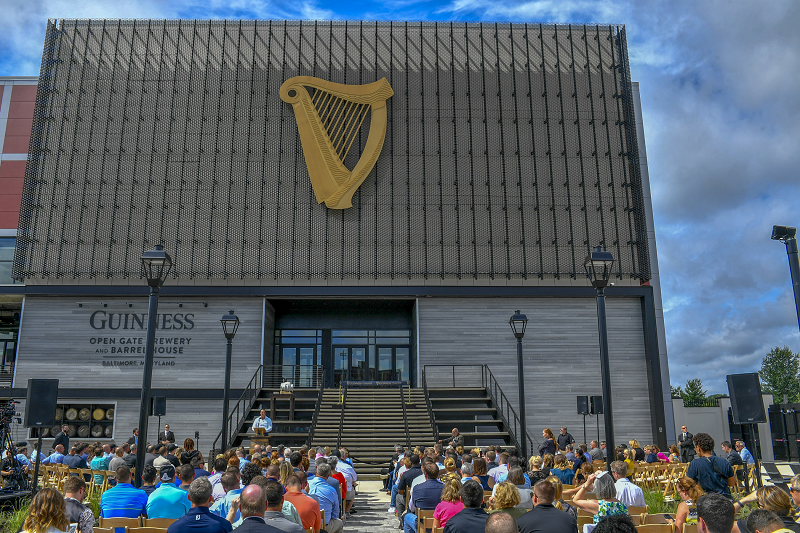
Guinness Open Gate Brewery & Barrel House, the first Guinness brewery in the U.S. in more than 60 years, held a ribbon cutting on August 2, 2018 in Halethorpe, Maryland. Opening to the public August 3, 2018 at 3pm EST. (Photo courtesy Guinness Brewery)
(Press Release)
BALTIMORE, Md.—This afternoon Guinness brewers, executives and guests from the local community gathered for a ceremonial ribbon-cutting at the new home of Guinness in America – the Open Gate Brewery & Barrel House in Maryland. Doors will officially open to the public tomorrow at 3 p.m. ET.
“This brewery has long been a dream for Guinness, and an incredible amount of hard work has gone into getting these doors open,” said Diageo Beer Company USA Chairman and Diageo Global Chief Sales Officer Tom Day. “I can’t wait to see people enjoying the fantastic beer our brewers have made in this historic and beautiful building. I’m proud that we have created something special and quintessentially Guinness here in Maryland.”
Located just 10 miles from downtown Baltimore and 30 miles northeast of Washington, D.C., the Open Gate Brewery & Barrel House is conveniently located and part of an exciting and growing brewing scene in Maryland. It will be the home of Guinness Blonde, along with new Guinness beers created for the U.S. market. The creation of a world-class brewery, barrel house and visitor center, and development of packaging and warehousing operations has generated more than 200 jobs and represents an investment by Diageo of approximately $90 million in the Maryland project.
The first part of the brewery’s name takes inspiration from the Guinness Open Gate Brewery in Dublin – where the company has experimented in beer for more than a century. The second part of the name, “Barrel House,” is a nod to the long history of Guinness brewers maturing beer in wood barrels, a tradition this new brewery intends to continue. In addition, the space was once home to a historic whiskey distillery, so the site already boasts a venerable heritage of barrel-aging.
“Our administration is proud of Maryland’s robust and growing brewing industry and we are excited to welcome a legendary brewer like Guinness to our great state,” said Maryland Governor Larry Hogan. “In addition to more than 200 new jobs, this new facility’s full-time brewing and hospitality operations will bring a new source of tourism to Baltimore County and to Maryland. We remain committed to supporting companies that invest in our communities and our citizens, and Guinness opening its doors today is yet another example that Maryland is open for business.”
Leveraging a pre-existing structure for the project, as opposed to starting from scratch with a green field development, was a priority for Guinness to maintain parent company Diageo’s commitment to environmental sustainability. Guinness has also implemented measures to reduce the overall electric consumption and water usage at the site, while utilizing recycled elements for the build, along with low volatile organic compound (VOC) materials and paints, to accent the building.
“A lot more than hops goes into building a brewery,” said Baltimore County Executive, Don Mohler. “We partnered with Diageo from permits to passing legislation, all to be sure these historic buildings would become a world class destination for Baltimore County and the region.”
The Open Gate Brewery & Barrel House is the first Guinness brewing operation on U.S. soil in more than 60 years and is home to two custom-built brewhouses: a 10-barrel brewhouse and a 100-hectoliter brewhouse, both of which are set up to brew and ferment different styles. The 10-barrel system is the small-batch experimental brewery, while the 100-hectoliter system will initially brew Guinness Blonde for national distribution.
Led by Brewmaster Peter Wiens and Head Brewer Hollie Stephenson, the Maryland brewing team has already begun producing beers for the on-site taproom. While the majority of beers will be available exclusively in the taproom, a few brews will make their way to the greater DC, Maryland and Virginia areas, with some even rolling out nationally.
Beginning tomorrow, visitors can tour the 10-barrel brewery and try the beers made on site. The initial line-up will include: “Guinness IPA,” a hit in the Test Taproom; and “Crosslands Pale Ale,” a beer made entirely with Maryland-grown malted barley and hops.
While many Guinness classic stouts, including Guinness Draught, Extra Stout, and Foreign Extra Stout, will continue to be brewed at St. James’s Gate in Dublin, guests can enjoy them responsibly alongside the new American innovation beers in the brewery’s taproom. The exact number of beers on tap will vary, but there will typically be more than 15 beers available at one time.
All beer sales and sampling will be limited to guests 21 years of age and over, but the destination will offer fun for people of all ages. The brewery’s restaurant, led by Executive Chef Sam Anderson, is slated to open later this summer, and the menu will take inspiration from popular local dishes and Guinness’ unmistakable Irish heritage. Leading up to the restaurant’s debut – and even after it opens – guests can order casual bar fare in the taproom, or enjoy some of Maryland’s finest food trucks, which will often be stationed on the brewery grounds. The Open Gate Brewery & Barrel House also includes a performance area for future concerts and local community events.
Starting opening weekend, Guinness partner Lyft will set up a permanent pickup lane at the brewery to facilitate convenient and responsible rides home as a part of Diageo’s commitment to responsible drinking and Lyft’s Ride Smart initiative.
Upon opening to the public, the brewery will offer free self-guided tours, and later this summer will also begin to feature guided tours with beer tastings for $10. Taproom entry and access to the restaurant and outdoor grounds will be free of charge. Once guided tours begin, tickets will be available for purchase on site, but Guinness recommends buying them ahead of time at www.GuinnessBreweryBaltimore.com. At the outset, Open Gate Brewery & Barrel House operating hours will be Monday-Friday, 3-9 p.m. ET, and Saturday-Sunday, 12-9 p.m. ET.
To keep up to date with the latest news from the Open Gate Brewery & Barrel House, make sure to follow @GuinnessBreweryUS on Facebook and Instagram. Whether enjoying a pint at the Open Gate Brewery & Barrel House in Maryland, at the Guinness Storehouse in Ireland or anywhere in between, please do so responsibly.
About Guinness
The Guinness brand was established in 1759, when Arthur Guinness signed a 9,000 year lease on St. James’s Gate Brewery in Dublin. Brewed using four main ingredients, water, barley (malted & roasted), hops and yeast, Guinness is the world’s most popular stout brand. The iconic beer is brewed in 49 countries worldwide and sold in over 150 with almost 9 million glasses of Guinness beers enjoyed every day around the world. The most GUINNESS is sold in Great Britain, Ireland, USA, Nigeria and Cameroon. More information can be found at www.guinness.com.
About Diageo Beer Company
Diageo Beer Company USA (formerly Diageo-Guinness USA) is the U.S. beer and flavored malt beverage business of Diageo. Brands within Diageo Beer Company include the iconic Guinness, Harp, Smithwick’s and Smirnoff ICE.
About Diageo
Diageo is a global leader in beverage alcohol with an outstanding collection of brands including Johnnie Walker, Crown Royal, Bulleit and Buchanan’s whiskies, Smirnoff, Cîroc and Ketel One vodkas, Captain Morgan, Baileys, Don Julio, Tanqueray and Guinness.
Diageo is listed on both the New York Stock Exchange (DEO) and the London Stock Exchange (DGE) and our products are sold in more than 180 countries around the world. For more information about Diageo, our people, our brands, and performance, visit us at www.diageo.com. Visit Diageo’s global responsible drinking resource, www.DRINKiQ.com, for information, initiatives, and ways to share best practice.
Follow us on Twitter for news and information about Diageo North America: @Diageo_NA.
The post Guinness Brewery Debuts in Maryland appeared first on All About Beer.
]]>The post Six to Seek: The Best IPAs of the Week appeared first on All About Beer.
]]>
Since today is IPA Day, we’re showcasing not just the best beers we’ve had this week, but the best IPAs.
And truth be told, it wasn’t hard to find six really impressive examples of a single (though admittedly broad) style. Of the many beers sent to us on a weekly basis, probably 80 percent are some style of IPA. And of those, the overwhelming majority fall under the hazy/juicy/milkshake/New-England-style umbrella.
This week’s Six to Seek, then, reads like the state of IPA today, dominated by hazy beers with one example of the emerging Brut IPA style.
But know this: we still love West Coast IPAs. Remember those? Those clear, piney, unapologetically bitter beers we once cherished? The kind of beer that was en vogue at the time of the inaugural IPA Day in 2011?
Next week, we’ll get back to our regularly scheduled programming, with a more diverse selection of styles. But for now, read on for the six best IPAs we tasted this week.
MIDDLE BROW ART BRUT
Middle Brow Beer Co.
Chicago, Illinois
5.5% | Brut IPA
Middle Brow’s Art Brut almost looks like champagne, pouring a light, glimmering gold. The blended yeast brings pear, green apple and even, surprisingly, a little caraway spice, with that dry quality that champagne has. It’s at first an odd sensation to be drinking an IPA with as many flavors coming from the yeast as from the hops, but it’s a fun experience. The hops used (Falconer’s Flight and Azacca) do impart some notes of pine and papaya, and the high carbonation and dry finish makes this one a refreshing and fun choice.
GREAT DIVIDE HAZY IPA
Great Divide Brewing Co.
Denver, Colorado
6.2% | New-England-Style IPA
Great Divide’s Hazy IPA was recently released in limited quantities throughout Denver. Hopped with what seem to have become the holy trinity these days–Citra, Mosaic and El Dorado–the beer offers up not just the requisite fruity notes you’d expect of the style, but has a distinct herbal quality to the nose. There is a slight mintiness on the palate, followed by grapefruit and fresh-squeezed orange juice. Given the style’s short shelf life Great Divide hasn’t rolled this one out to larger distribution, but if you can find it fresh don’t pass it up.
SIXPOINT / SLOOP SPRITZER BOMB: WHITE
Sixpoint Brewery & Sloop Brewing Co.
Brooklyn, New York
7.7% | New-England-Style IPA w/ White Grape Juice
A mashup of Sixpoint’s Spritzer series with Sloop’s Juice Bomb IPA, Spritzer Bomb: White is hopped with Citra, Enigma and Vic Secret. Those juicy hopes are complemented also by grape juice, specifically a blend of muscat, sauvignon blanc and gewürztraminer. The hops and grape juice combine to provide notes of lemon, lime and tart apples, with grapefruit and pineapple reminding you that this is still undeniably an IPA. The citric finish and white wine notes, however, might also put you in the mind of a mimosa.
OUTER RANGE / CASEY CROSS FLOW
Outer Range Brewing Co. & Casey Brewing & Blending
Frisco, Colorado
7% | New-England-Style IPA
This collaboration between two of Colorado’s most popular breweries is double dry-hopped with Citra, Galaxy and Nelson Sauvin hops. It pours a flat, pale yellow–not unlike the inside of a banana. What it lacks in looks, though, it makes up for in hop flavor and aroma. The nose is pungent, with grapefruit, pineapple and nectarines wafting from the glass. The palate’s more of the same, with a huge, citrusy punch. Though it’s perhaps a little one-note, it strikes that one note exceptionally well.
EL SEGUNDO CERVEZA FRESCA GUAVA-GUAYABA
El Segundo Brewing Co.
El Segundo, California
7.3% | Juicy IPA
This was a very different sort of “juicy IPA” from El Segundo. Instead of a heavy emphasis on bold citrus flavors, it has more of a gentle and round quality to it. That’s not to say that it lacks juiciness or that the fruit notes aren’t there; there’s peach, pineapple and of course guava, but also a floral quality and very little bitterness, with a bit of hop spice on the finish that almost comes through like a noble hop. It’s a very refreshing beer, with the hops and guava working together in perfect harmony.
PURE PROJECT / FIELDWORK MURKELEY
Pure Project Brewing & Fieldwork Brewing Co.
San Diego, California
8.5% | Double India Pale Ale
Pure Project and Fieldwork collaborated on Murkeley, a nod to Fieldwork’s home in Berkeley and to both breweries’ affection for hazy, murky IPAs. The nose has a sweetness to it reminiscent of peach cobbler, while the palate offers up more peach, grapefruit, melon and a dankness–and welcome bitterness–on the finish.
Six to Seek celebrates the best beers we’ve tasted this week. Check out our best beers of weeks past here.
The post Six to Seek: The Best IPAs of the Week appeared first on All About Beer.
]]>The post Brewers Association Reports Mid-Year Growth Pace appeared first on All About Beer.
]]>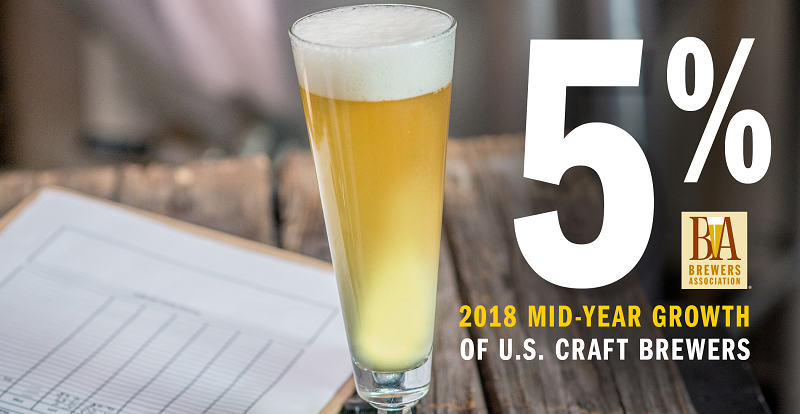
(Image courtesy the Brewers Association)
(Press Release)
BOULDER, Colo.—Growth for small and independent craft brewers remained stable for the first half of 2018, according to new mid-year metrics released by the Brewers Association (BA)—the not-for-profit trade association dedicated to small and independent American brewers.Production volume for the craft segment increased five percent during the first half of 2018.
“While more mature, the market continues to show demand for small and independent craft brewers,” said Bart Watson, chief economist, Brewers Association. “There are certainly industry headwinds, but this stabilized growth rate is reflective of the market realities that exist for brewers today.”
As of June 30, there were 6,655 active breweries, up from 5,562 during a comparable timeframe last year. An estimated 2,500 to 3,000 breweries are in planning, based on active Alcohol and Tobacco Tax and Trade Bureau (TTB) licenses.
“The data demonstrate that 2018 is on pace to have the highest number of brewery openings and closings to date. However, even as breweries close, openings continue to far outpace the number that shutter,” added Watson. “New players looking to enter the space should be aware of the constructs of the current landscape, work to differentiate themselves and will need to make quality beer to succeed.”
Craft brewer definition: An American craft brewer is small, independent and traditional. Small: Annual production of 6 million barrels of beer or less (approximately three percent of U.S. annual sales). Beer production is attributed to the rules of alternating proprietorships. Independent: Less than 25 percent of the craft brewery is owned or controlled (or equivalent economic interest) by an alcoholic beverage industry member that is not itself a craft brewer. Traditional: A brewer that has a majority of its total beverage alcohol volume in beers whose flavor derives from traditional or innovative brewing ingredients and their fermentation. Flavored malt beverages (FMBs) are not considered beers.
About the Brewers Association
The Brewers Association (BA) is the not-for-profit trade association dedicated to small and independent American brewers, their beers and the community of brewing enthusiasts. The BA represents 4,800-plus U.S. breweries. The BA’s independent craft brewer seal is a widely adopted symbol that differentiates beers by small and independent craft brewers. The BA organizes events including the World Beer Cup®, Great American Beer Festival®, Craft Brewers Conference® & BrewExpo America®, SAVORTM: An American Craft Beer & Food Experience, Homebrew ConTM, National Homebrew Competition and American Craft Beer Week®. The BA publishes The New Brewer®magazine, and Brewers PublicationsTM is the leading publisher of brewing literature in the U.S. Beer lovers are invited to learn more about the dynamic world of craft beer at CraftBeer.com® and about homebrewing via the BA’s American Homebrewers Association® and the free Brew Guru® mobile app. Follow us on Facebook, Twitter andInstagram.
The Brewers Association is an equal opportunity employer and does not discriminate on the basis of race, color, national origin, gender, religion, age, disability, political beliefs, sexual orientation, or marital/familial status. The BA complies with provisions of Executive Order 11246 and the rules, regulations, and relevant orders of the Secretary of Labor.
The post Brewers Association Reports Mid-Year Growth Pace appeared first on All About Beer.
]]>The post Six to Seek: The Best Beers of the Week appeared first on All About Beer.
]]>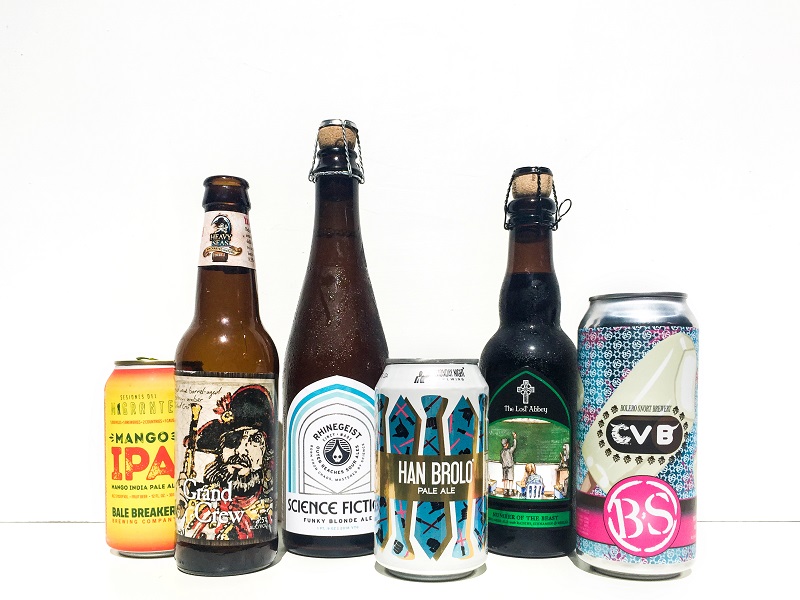
MONDAY NIGHT HAN BROLO
Monday Night Brewing
Atlanta, Georgia
4.7% | Pale Ale
A year-round beer for Atlanta’s Monday Night Brewing, Han Brolo is brewed with Simcoe, Mosaic and Mandarina Bavaria hops, as well as lactose sugar. That trio of hops contributes a range of flavors, from fresh-cut grass and chives to orange peel and tangerine. It’s juicy without going overboard, with a little dankness to keep things interesting. Han Brolo’s finest feature, however, is its mouthfeel. Despite the beer’s 4.7% ABV, it boasts the body and creaminess of a bigger beer–quite likely due in part to the lactose. A thin, watery body is the Achilles’ heel of many a session IPA, but not this one. It feels sessionable, yet substantial.
BALE BREAKER SESIONES DEL MIGRANTE MANGO IPA
Bale Breaker Brewing Co.
Yakima, Washington
5.9% | IPA w/ Mango
Mango IPA is the fourth beer in the Sesiones del Migrante series, a collaboration between Bale Breaker, Cervecería de Colima (Colima, Mexico), Cerveza Loba (Guadalajara, Mexico), Ronin Fermentation Project (Truckee, California), SouthNorte (San Diego, California) and YCH Hops. This partnership, now in its second year, celebrates migrant workers who travel from Mexico to harvest hops in Yakima every season.
YCH Hops contributed Citra, Ekuanot and HBC 630 hops, and the IPA was fermented with mango puree. Twenty pounds per barrel, in fact. Despite this, the mango comes through rather subtly, helping to round out hop-driven notes of grapefruit, pineapple and green-onion dankness. So often fruited beers–even IPAs, backed by copious amounts of hops–come across as overly sweet. Here it’s an underlying sweetness, allowing the hops to shine.
A portion of the proceeds from the new Mango IPA will benefit La Casa Hogar, a nonprofit that “connects and educates Latina families, to transform lives and our Yakima Valley.”
BOLERO SNORT CVB
Bolero Snort Brewery
Ridgefield Park, New Jersey
6.3% | IPA w/ Coconut, Vanilla & Milk Sugar
The latest variant in Bolero Snort’s “vanilla bullsicle” series of IPAs gets the coconut treatment. Coconut Vanilla Bullsicle, or CVB for short, boasts a huge coconut aroma that calls to mind an Almond Joy, sans chocolate. Vanilla is there too, but it’s far more subtle. Despite that blast of coconut on the nose, the beer isn’t overly sweet–the hops (Wakatu and Denali) contribute restrained bitterness and provide enough pineapple and citrus to balance those dessert flavors. After drinking it, we’re left thinking this beer just shouldn’t work this well–yet it does.
RHINEGEIST SCIENCE FICTION
Rhinegeist Brewery
Cincinnati, Ohio
6.9% | Funky Blonde Ale
The late Fred Eckhardt, dean of American beer writing, once compelled his readers to “Listen to your beer! Now!” His point was that beer can and should be appreciated through all five senses, and indeed the first sensory sensation that Rhinegeist’s Science Fiction provides is an audible fizzing inside the bottle as soon as the cork is pulled, like soft static on an old radio. The fourth in the brewery’s Outer Reaches series of sours, Science Fiction is indeed highly carbonated, yielding a crackling head that is not long for this world. Perhaps in this case, we taste first not with our eyes, but our ears.
Once that head subsides, the nose offers a pleasant aroma of Brettanomyces funk and dill. The beer’s sourness is not only assertive, but complex: in addition to sharp, lactic notes, there’s a red wine vinegar quality as well. It’s a bright beer both in color and character, with green apple and lemon rising above that sourness and a glimmer of oak.
HEAVY SEAS GRAND CREW
Heavy Seas Beer
Baltimore, Maryland
8.5% | Red-Wine-Barrel-Aged Belgian-Style Amber Ale
Aged eight months in Pinot Noir barrels, Grand Crew is the latest in Heavy Seas Beer’s Uncharted Waters series. Clove and toasted bread come through most prominently on the nose, while the barrel character–in the form of tart cherry jam–comes through more on the palate. Six different Belgian malts add a distinct earthy and nutty quality, while the Belgian yeast adds a dash of peppercorn and the aforementioned clove. A fine sipper on its own, but would also shine alongside savory dishes (try barbecue, red chili or oven-roasted vegetables).
THE LOST ABBEY NUMBER OF THE BEAST
The Lost Abbey Brewing Co.
San Marcos, California
14% | Bourbon-Barrel-Aged Quad w/ Raisins, Cinnamon and Chile Peppers
Brewed with raisins, cinnamon and dried chile peppers, The Lost Abbey describes Number of the Beast as “reminiscent of an oatmeal raisin cookie.” The first impression, though, is of the overwhelming scent of bourbon. The raisins and an impression of fig follow, with a little soy in the nose. More sweetness on the first sip, with caramel and subtle vanilla–the cinnamon is tougher to pick up on. The beer has a fair share of heat from the alcohol, but at 14% that’s pretty much expected. This one would be an interesting candidate to set aside for a year or more to see how all of these flavors develop. Despite its heft and heat, the beer drinks easily. Moderate carbonation keeps the beer lively and allows it to dance across the palate.
Six to Seek celebrates the best beers we’ve tasted this week. Check out our best beers of weeks past here.
The post Six to Seek: The Best Beers of the Week appeared first on All About Beer.
]]>The post Old Rasputin: North Coast’s Imperial Interpretation appeared first on All About Beer.
]]>
(Photo by Jill McNamara)
By the time Catherine the Great, Empress of All Russia, started commissioning porter from London breweries in the 1780s, the ale had been a favorite import for decades. The fame of these strong, barrel-aged beers was already circling the globe, and versions of it were being made in Scotland, Ireland, and the newly-independent United States.
Those original London porters were made with a rough, smoky grain known as brown malt, and the beer, as it came out of the kettle, apparently wasn’t much fun to drink. Once brewers learned to let their porters sit in wooden vats for up to two years, though, a magical transformation happened; native microorganisms transformed an acrid beer into something refined and sherry-like.
Yet the word “imperial” that became associated with the porter bound for the Tsarina’s court—purportedly the strongest of the London porters—had a double meaning. That porter was made for imperial purposes, but porter itself had become beer’s monarch.
Eventually, of course, the great vat-aged porters gave way to other, lesser ales. The strongest versions—the “stout” porters—withered and grew tame. They were further diminished by the world wars, and by the 1950s, not a single brewery in England made a porter. Except for the success of its distant ancestor, Irish stout, the era of this style seemed over.
Three decades later, Mark Ruedrich and two cohorts were putting together the plans for a brewery in Fort Bragg, California. Ruedrich had been a homebrewer and had lived in England for two years, and long before starting North Coast Brewing, he’d become enchanted by stouts.
“I had also made my own special study of Guinness while living in England,” he says—and indeed Old No. 38, an Irish stout, was one of the beers North Coast offered when it debuted in 1988. But it was a different stout that would make North Coast famous, one he’d discovered as a homebrewer years before: Bert Grant’s Imperial Stout.
“It was a revelation for me,” he recalls. It was an evocation of those ancient Baltic-bound porters. “I thought that was a beer I’d very much like to brew one day.”
It took six more years before he began formulating Old Rasputin, and though it was inspired by Grant’s, he wanted it to be entirely original. Grant’s had been sweeter, maltier, and was only 6% ABV. “I thought, ‘I think we need to plant a stake in the ground.’ It was logical to give this beer a very American twist. Instead of doing a malty beer, doing something that was much more hop-forward.”
What emerged was nothing like the old vat-aged brown porters sent to Russia, and yet in its booming strength and intense flavors, Old Rasputin did capture their spirit. Ruedrich wanted it to express the character of American hopping, so he infused it with 75 international bitterness units of Centennial, Northern Brewer and Cluster hops. The Clusters are a nice touch—an old American hop, they were widely used in British brewing as a bittering hop in the 19th century. The hops give it a resinous, almost oily layer that augments the powerhouse roasted malts.
“One of the early lessons we learned in making Old 38 was that roasted barley is critical, and not using too much black malt is also critical,” says Ruedrich.
He created a foundation of caramel malts to add some balancing sweetness, and what he called “intermediate” malts for flavor. What’s an intermediate malt? Brown malt, for one—another wink to St. Petersburg.
As we were discussing the beer, Ruedrich called it “creamy but quite dry,” and that has always been my impression, too—right down to the words I’d used in tasting notes. Shortly after North Coast launched Old Rasputin, Goose Island began making a bourbon barrel-aged imperial stout, which now seems the default for American brewers. It has led the lineage of American stouts in a much sweeter direction than Ruedrich envisioned. The latest trend in “pastry stouts”—very sweet, confectionary ales—extends that tradition further. As a consequence, recent reviews have tended to ding Old Rasputin. “A bit light on body,” Craft Beer and Brewing observed. “Slightly astringent,” said Draft Magazine. “Too astringent, somewhat coarse,” one reviewer at Beer Connoisseur decided.
But these seem to take modern, gloopy, sweet imperials as the benchmarks, when Ruedrich was shooting for something entirely different.
“We use a low mash temperature to make an extremely fermentable wort to make sure this beer finishes as bone-dry as a [huge] beer can,” he says. And this is where Old Rasputin sings. The relative dryness reveals the layers of hopping and roast, so the palate shimmers with different flavors as it passes over the tongue—dark chocolate and cocoa, yeast esters that evoke cherry or red wine, that piney resin, a touch of char, and delicately sweet toffee, all wrapped up in that unusual creaminess. Most of the modern, sweeter imperials are built to be drunk in volumes of a few ounces. Old Rasputin, despite its intensity, sustains and nourishes the soul over the course of a full pint.
Porters and stouts have been many things over the past 300 years. At their most robust, they were beers that warmed the coldest Russian winter nights and inspired a world to start making them. Of all the modern interpretations, few match Old Rasputin’s ambition, daring, and accomplishment. It has earned the right to be called “imperial.”
Jeff Alworth is the author of The Secrets of Master Brewers and The Beer Bible.
The post Old Rasputin: North Coast’s Imperial Interpretation appeared first on All About Beer.
]]>The post Six to Seek: The Best Beers of the Week appeared first on All About Beer.
]]>
WICKED WEED UNCLE RICK’S PILSNER
Wicked Weed Brewing
Asheville, North Carolina
5.1% | Pilsner
While Wicked Weed Brewing made its name off of wild and sour ales, visitors to the brewpub in Asheville will have no doubt encountered a variety of “clean” beers there as well. Uncle Rick’s Pilsner, now year-round and in cans, is one such beer. It’s crisp and clean, with barely-toasted bread giving way to a light bitterness and lemony character from the Noble hops. The brewery deserves the credit it gets for its sour ales, but beers like this require just as much skill to make.
EXHIBIT ‘A’ DEMO TAPE EIGHTEEN
Exhibit ‘A’ Brewing Co.
Framingham, Massachusetts
4.5% | Farmhouse Ale
Exhibit ‘A’ Brewing Co. wasn’t kidding when they dubbed this one a “multigrain farmhouse ale.” Beneath the red barn on the label is the following list of specialty grains: “chitted wheat, kvass, oats, warthog wheat, buckwheat, honey malt, spelt, triticale, and sunflower seeds all malted at Valley Malt in Hadley, MA.” Though the number of grains used is high, the ABV is low at 4.5%.
So what is the sum of all of these grains? The nose is all honey and toasted white bread, but more of that traditional wheat flavor comes through on the palate. Further sips reveal cracker and bread crust. As the beer warms, clove and the lightest touch of vanilla comes through. It’s difficult to pull out every single grain when tasting, and yet they all combine to form one truly distinctive, refreshing farmhouse ale that has qualities of saison, grisette and witbier.
CRUX IN THE POCKET
Crux Fermentation Project
Bend, Oregon
9.9% | Blended, Red-Wine-Barrel-Aged Saison w/ Brettanomyces
One of Crux Fermentation Project’s [BANISHED] Series of barrel-aged beers, In The Pocket is a blend of young and old saisons—both fermented with Brettanomyces—with the aged saison having spent nearly a year in red wine barrels. This beer made DRAFT Magazine’s Top 25 Beers of the Year in 2017, and we’re happy to report that this year’s is just as impressive.
The nose offers up an appealing blend of clove, strawberry and red wine, with the slightest touch of vinegar. The red wine comes through prominently on the palate with tart cherry and subtle citrus, but the imperial saison base is big enough that the barrel character doesn’t overpower it. The Brettanomyces adds additional fruit notes in the form of sweet pineapple and green apple, and there’s a little vanilla from the oak. It’s lightly acidic and tart, with warmth from the alcohol but no harshness. While it’s all too easy to drink by oneself, this one would be best served with food and friends.
BARREL + BEAM GOLDEN PARTAGER
Barrel + Beam
Marquette, Michigan
7.5% | Oak-Aged Wild Ale
Barrel + Beam opened earlier this year in a building that was once home to the Northwoods Supper Club, a restaurant with a storied history spanning from 1934 to 2007. After breathing new life into the cabin through a $2-million renovation, founders Marina Dupler and Nick VanCourt opened their brewery this past January with a focus on farmhouse styles and barrel-aged beers.
Golden Partager pours with the effervescence you would want and expect out of a bottle-conditioned beer. Fermented with Brettanomyces bruxellensis, the wild yeast contributes a pleasant funkiness in the aroma. On the palate there’s bright lemon, subtle candied orange, sweet tropical fruit and a light tartness, with a bit of dill on the finish. That profile, along with the high carbonation and a dry finish, give this new offering something of a classic character.
SOUTHERN PROHIBITION DEVIL’S HARVEST BREAKFAST IPA
Southern Prohibition Brewing
Hattiesburg, Mississippi
4.9% | New-England-Style IPA
The name had us wondering if this beer was brewed with coffee, but when it poured a cloudy gold we realized it’s more akin to juice. At 4.9% ABV, it’s probably as good a choice as any if you’re looking to get the day started with a sessionable IPA. Big notes of pineapple waft from the glass, but there’s an herbal component that calls to mind oregano. On the palate, Citra and Mosaic hops bring more pineapple, plus grapefruit and tangerine. There’s a decent bitterness, too, though it fades quickly. Despite the use of oats, the beer maintains a light body and is quite refreshing.
SWEETWATER 420 STRAIN: G13 IPA
SweetWater Brewing Co.
Atlanta, Georgia
6% | IPA w/ Terpenes & Hemp Flavor
Cannabis-inspired beers are trending right now, especially in states that have legalized the sale of marijuana. Though Georgia isn’t one of them, that hasn’t stopped SweetWater—long a proponent of pot puns—from introducing its own take on the burgeoning style. After months in the lab, they’ve unveiled 420 Strain: G13 IPA. It’s a draft-only beer for now, with packaged product coming this fall (and for the record, it shares nothing in common with the brewery’s similarly-named 420 Extra Pale Ale).
The IPA is brewed with Columbus and Simcoe hops and a couple of dry-hop additions, but then the brewery amplified the dankness by “blending in strain specific terpenes and a proprietary hemp flavor blend to mimic the aroma of a cannabis strain.” And they nailed it. The hazy pour, not unlike New Belgium’s The Hemperor, smells overwhelmingly of weed. The beer strikes a nice balance between herbal and citrus notes, with rosemary, grapefruit and orange.
SweetWater plans to introduce additional beers through the new 420 Strain line. There will eventually be a robust portfolio of cannabis-inspired beers across the industry, using many different varietals and methods to incorporate hemp or cannabis flavors, and we’ll be doing a disservice to simply remark that these beers taste like weed.
But for now? This is an IPA that tastes like weed, but one that pulls it off exceptionally well.
The post Six to Seek: The Best Beers of the Week appeared first on All About Beer.
]]>The post Upland Brewing Co. to Open Brewery and Taproom in Indianapolis appeared first on All About Beer.
]]>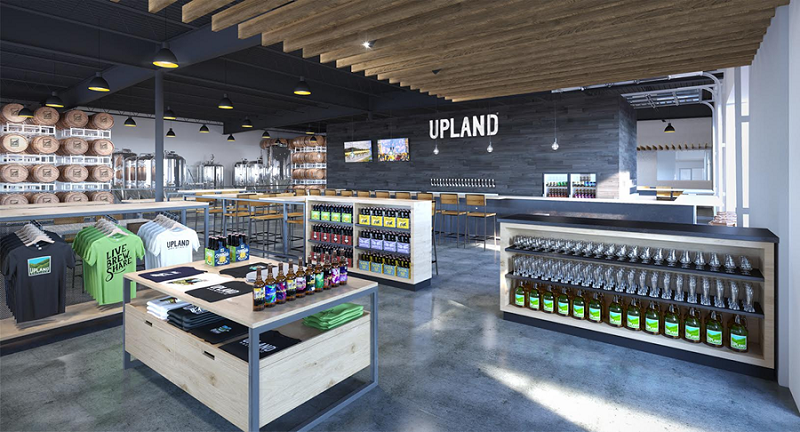
(Photo courtesy Upland Brewing Co.)
(Press Release)
INDIANAPOLIS–Upland Brewing Company is thrilled to announce a new brewery and restaurant concept in the beloved Fountain Square neighborhood of Indianapolis. An area rich with hoosier history, a vibrant music & art scene and an ever-growing community of small businesses, Fountain Square is a perfect fit for Upland’s culture & values. “The space felt like home the moment we found it — surrounded by art, music, history, and quick access to the cultural trail for cycling around the city.” said David Bower, Upland Chief Growth Office.
The new Upland Brewing Co FSQ location will feature on-site brewing & barrel-aging, a full-service restaurant, and a unique partnership with Gray Goat Bicycle Company. “We are really excited to embark on this next adventure. We wanted to put down roots in a community where we could draw inspiration and give back in equal measure, and what better place than this creative hub of Indianapolis.” said Pete Batule, Upland President & COO
Innovation and Sustainability are fundamental values for Upland Brewing Co.
Upland’s new 13,000 square foot brewery will feature an immersive interior beer hall experience, a huge outdoor beer garden, an open kitchen, and an on-site brewery focused on innovation and barrel aging. “Expanding our brewing operations to Indy will be a perfect complement to our Bloomington-based Wood Shop Sour Ale & West Side Production Breweries. This new site will allow us to further experiment and challenge ourselves creatively.” Batule explained, “With a total of 26 lines and at least 10 barrel-aged & small batch beers on tap, we will provide our guests with front row access to our creative process.”
The innovation and creativity don’t stop at the brew house. Building relationships with area artists mirrors Upland’s devotion to all things local. Whether it’s an Indiana hop farmer, a Marion County woodworker, or an Indianapolis muralist, Upland believes supporting the local ownership of culture creation is a fundamental ingredient to the mission. “We’re committed to making our beer and community better through creative partnerships that nourish communities.” said Matthew Batty, Upland Creative Director
Bringing even more fun to the table, Upland FSQ will feature an on-site Bicycle Shop thanks to a partnership with Gray Goat Bicycle Company. The Gray Goat Bike Hub will offer a full-service repair shop, parts & accessories, and new & used bicycle sales. “Bikes & beer are a match made in heaven, and the easy access to the cultural trail makes this a perfect fit.” said Brian Gootee, Owner of Gray Goat Bicycle Co.
The kitchen will feature a rotating menu of fresh, local ingredients placing Indiana’s agricultural heritage on center stage. Upland Culinary Director Paddy Cullen explained, “In addition to hearty smoked meats, healthy vegetarian options will be plentiful. I’m especially excited to collaborate with the brewers on our pickling & preserve program.” A large, 225-seat beer hall will comfortably accommodate groups both large and small. Ample bar & patio seating and a full array of Upland draft beer options will keep the party going long past sunset.
Property for the new Upland site is being leased from Milhaus. Greg Martin, principal and vice president of asset management, says, “This is a great win not only for Upland, but also for Milhaus. We’re excited about the opportunity to revitalize this space and add additional value to an already stellar neighborhood. Upland Brewing Company and the partnership with Gray Goat will provide the community with a unique space for entertainment and socialization.”
Design and build partners include Kort Construction & DKGR Architects. Targeted opening date is spring of 2019. That being said, construction timelines can be a fickle beast, so be sure to follow Upland Brewing Co social media channels for regular updates on our progress. Cheers!
Located in Bloomington, Indiana, Upland Brewing Co. has an intriguing brewing story that dates back to 1998. Our mission is to brew remarkable beers in remarkable ways, staying true to the artisan, progressive spirit found in our part of the Midwest. Upland is currently the third largest brewery in Indiana and brews more than 50 different styles of beer annually.
The post Upland Brewing Co. to Open Brewery and Taproom in Indianapolis appeared first on All About Beer.
]]>The post Three Weavers Brewing Co. Joins CANarchy Craft Brewery Collective appeared first on All About Beer.
]]>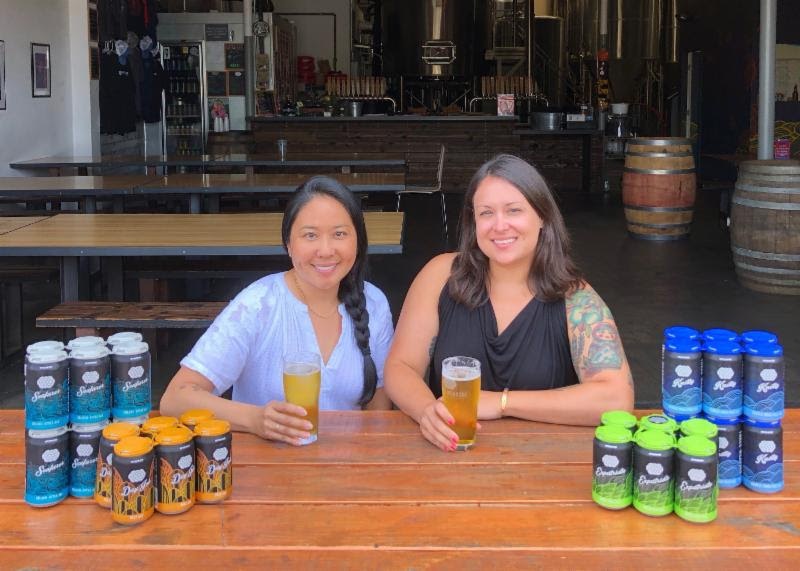
Founder and CEO of Three Weavers Brewing Company, Lynne Weaver, shares a pint with Brewmaster Alexandra Nowell at the Three Weavers taproom in Inglewood. (Photo courtesy CANarchy Craft Brewery Collective)
(Press Release)
INGLEWOOD, Cali.—Three Weavers Brewing Company, one of the largest independent craft breweries in Los Angeles County, today announces a strategic partnership with the disruptive craft brewery collective, CANarchy.
Under the leadership of Founder Lynne Weaver and Brewmaster Alexandra Nowell, Three Weavers has built a strong local following through its passion for the craft beer industry, award-winning craft beers, and mission to promote a positive sense of community.
“Our decision to join the CANarchy collective spans far beyond us as a single craft brewery. It’s about supporting our independence and continuing to champion the fight for all craft breweries with a similar goal. It’s also about living our mission – it’s more than beer, it’s community – and supporting the current craft crusade,” said Lynne Weaver, Three Weavers Founder and CEO. “Now more than ever, it is vitally important for craft breweries to band together to preserve our collective livelihoods and legacies and grow the overall industry. By joining the CANarchy collective, Three Weavers will continue to support our community – the craft beer industry, fellow craft breweries, independent beer, and of course, local craft beer drinkers. We are truly excited to partner with the entire CANarchy Craft Brewery Collective and look forward to what we will accomplish together in the coming years.”
CANarchy was recently ranked #9 on the Brewers Association’s list of the 2017 Top 50 U.S. Craft Brewers as ranked by sales volume. The CANarchy craft beer portfolio includes Oskar Blues Brewery, Perrin Brewing Company, Cigar City Brewing, Squatters Craft Beer and Wasatch Brewery, and Deep Ellum Brewing. The collective is the #1 provider of American craft beer in a can and has driven Cigar City Brewing’s Jai Alai IPA and Oskar Blues’ Dale’s Pale Ale to the #1 and #2 sold craft can six packs in U.S. Grocery. CANarchy delivers a diverse mix of innovative breweries and world class beers to distributors and retailers while providing modern beer drinkers the variety they demand.
“We founded CANarchy with the goal of bringing together like-minded breweries, supporting their growth and respective missions, and building a hyper-local presence in the largest markets in the U.S.,” said Matt Fraser, CANarchy President. “With their focus on quality craft beer and commitment to both independence and community, we believe Three Weavers Brewing Company is a perfect addition to the CANarchy collective and I am excited to partner with Three Weavers Founder, Lynne Weaver, in the coming years.”
2018 is shaping up as a momentous year for CANarchy. “With Three Weavers, we have added another world-class brewery to our portfolio – making CANarchy more valuable to both our wholesale and retail partners,” noted Keith Klopcic, former West Side Distributor [President] and current CANarchy Board Member. Earlier this year, Deep Ellum Brewing (Dallas, Texas) joined the collective. “As a brewery founder, it was vitally important to partner with a group of people that share my vision and have the expertise to help me get there,” said John Reardon, Deep Ellum Brewing Founder. “The entire CANarchy team is excited to welcome Three Weavers to our family and we look forward to partnering with Lynne and Alex.”
With the addition of Three Weavers, the CANarchy portfolio expands its reach across the U.S., from the East Coast to the West Coast, with leading regional breweries in California, Colorado, Florida, Michigan, North Carolina, Texas, and Utah. The aggressively growing collective provides a platform from which rapidly growing craft breweries seeking high level resources can expand and compete in the increasingly competitive craft beer segment, while maintaining their independence. Driven by individual brewery culture, CANarchy enables brewers to maintain control of their businesses and brands while providing the resources and support to scale their respective operations.
Terms of the partnership are not disclosed.
About Three Weavers Brewing Company
About CANarchy Craft Brewery Collective
The post Three Weavers Brewing Co. Joins CANarchy Craft Brewery Collective appeared first on All About Beer.
]]>The post Brewery Ommegang to Release Mother of Dragons appeared first on All About Beer.
]]>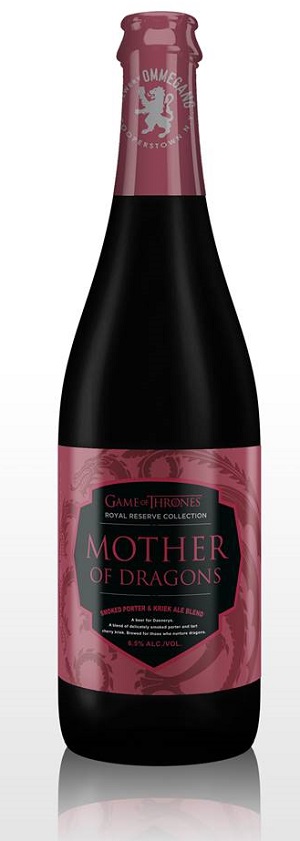
(Photo courtesy Brewery Ommegang)
(Press Release)
COOPERSTOWN, N.Y.—Brewery Ommegang and HBO Licensing & Retail have announced the newest beer in their collaborative series inspired by the award-winning drama Game of Thrones! Mother of Dragons, a beer brewed for Daenerys Targaryen, is the third beer in this year’s Royal Reserve Collection, a series of four limited release beers, each designed and brewed as an homage to one of four epic figures engaged in the battle for the Seven Kingdoms.
Brewed and blended for a leader who takes what is hers with fire and blood, Mother of Dragons is a blend of a smoked porter and a Belgian kriek, representing the smoke and fire that Daenerys has unleashed on her opponents. The beer will be available throughout Ommegang’s distribution network on September 28 both on draft and in 750ml bottles and the suggested retail price for a bottle is $12.99.
“Mother of Dragons represents in beer one of our favorite characters from Game of Thrones. Daenerys’s ascent from obscurity has been one of the most inspiring storylines of the show, and we’re thrilled to release a blend that embodies the character traits that have underpinned that rise,” said Doug Campbell, Brewery Ommegang president.
Mother of Dragons pours a deep ruby-tinted mahogany with a creamy tan head. Aromas of chocolate covered cherries intertwine with subtle smoke and roasted malt. The flavor is rich with tart cherry up front leading to a center palate of semi-sweet chocolate then resolving to subtle smoke and mild sweetness. The mouthfeel is luxuriously creamy and full, and the finish is semi-dry with lingering notes of smoke and cherry sweetness. Mother of Dragons is 6.5% ABV and pairs well with smoked gouda and charcuterie, braised meats, and rich desserts like flourless chocolate cake and cherry cheese cake.
The Royal Reserve Collection features four brand new beers in the brewery’s Game of Thrones-inspired series with HBO. All of the beers will be available on draft and in 750ml bottles. The series began in April with Hand of the Queen, a barleywine, and was followed in June by Queen of the Seven Kingdoms, a sour blonde blend. Following the release of Mother of Dragons, the final beer will be announced later this year.
About Brewery Ommegang
Founded in 1997 on the site of an old hop farm near Cooperstown, NY, Brewery Ommegang brews imaginative beers in a wide variety of styles, with particular emphasis on Belgian brewing traditions. For more information, visit ommegang.com, or follow us on Facebook at facebook.com/Ommegang, on Twitter at @BreweryOmmegang, and on Instagram at @BreweryOmmegang.
About HBO Licensing & Retail
HBO Licensing & Retail, a division of Home Box Office, Inc., partners with best-in-class licensees around the world to give HBO’s global audience new and exciting ways to engage with their favorite shows. The division leverages iconic, award-winning HBO programs such as Game of Thrones, VEEP, Sex and the City, Silicon Valley, Insecure, The Sopranos, Big Little Lies, True Blood and more to create officially licensed consumer products, innovative merchandise programs, retail activations and live immersive experiences. HBO Licensing & Retail works across a broad range of product categories, including collectibles, apparel, publishing, live branded experiences, digital gaming, fashion and beauty collaborations, luxury accessories, and beyond. Officially licensed HBO merchandise can be purchased in retail stores around the world, online in the US at http://store.hbo.com and in Europe at www.hboshopeu.com, and at the groundbreaking HBO retail hub, the HBO Shop®, located at 42nd and 6th Avenue in New York City.
The post Brewery Ommegang to Release Mother of Dragons appeared first on All About Beer.
]]>The post There Are Reasons for Concern, but the Sky Isn’t Falling appeared first on All About Beer.
]]>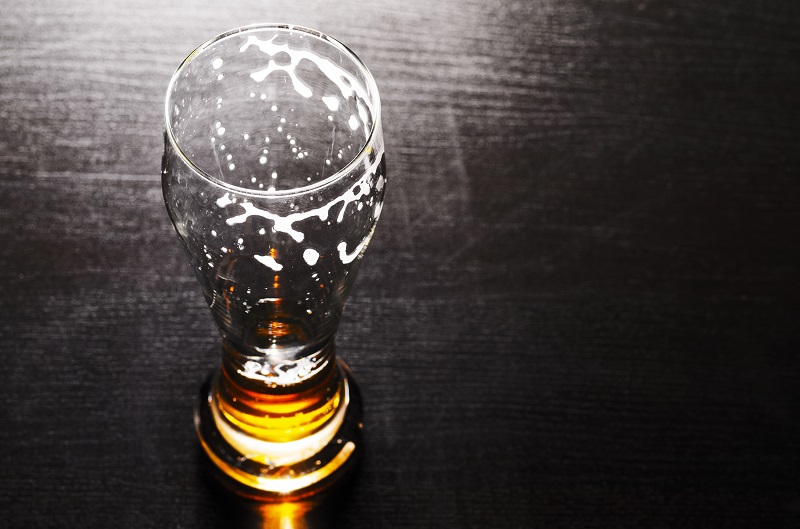
(Photo via Shutterstock)
Smuttynose sold at auction. Saratoga Brewing closed. Sales at Boston Beer and Sierra Nevada are down. The sky is falling!
Lagunitas sold, and its sales are up. Ballast Point sold, and its sales are up. Goose Island sold, and not only is its beer everywhere, but beer geeks are still buying Bourbon County Brand Stout as if there was nothing traitorous and evil about that (yeah, that’s sarcasm). The world is turned upside down!
Millennials aren’t drinking as much beer. Generation Z is drinking even less. They’re both drinking more spirits, and wine, but they’re drinking less overall. The Big Growth is over and will never return. Beer is threatened!
Everything is an IPA. IPAs are crowding out other beer styles. Kettle sours are dragging down the sophistication of sour beer. Hazy IPAs have no shelf life and drive people away from packaged beer. Beer stores may not survive!
Beer prices keep going up. “Craft” brewers keep selling out, or merging, or taking on private equity. The taproom model is killing larger brewers. Limited can releases are eating up disposable beer income. Aluminum tariffs will make canned beer even more expensive. Lower federal beer taxes are bad optics in the current political climate. The sky is falling!
Breathe, brothers and sisters. Grab a can, fill a glass, take a seat at the bar … and breathe, while Old Mister Lew tells a story.
Way back in 1996, beer was, wow, crazy. Growth had been around 40 percent! It was slowing down, but you know, can’t stay that hot forever. Still, bunches of new breweries were opening, almost a thousand, and established brewers were buying bigger kettles and tanks. New beers, new ideas, crazy names and labels. You could find a wide variety of beers, in more places all the time. Beer was fun, cool, and not just in a frat boy, pyramid-of-empties way. It was great.
But there were problems. Success attracted greed, and money gushed into the niche without much thought. The speed of expansion meant breweries were poorly planned, brewers were poorly trained, and quality control corners were cut, especially in packaging. All those new beers overwhelmed a system that was used to six to ten suppliers that might add a new bottle size every other year.
The result: old and/or bad beer on shelves and taps, poor practices in the marketplace. Eventually this led to breweries closing and sales of “microbrew” flatlining. Now, that’s not easy to substantiate, because our definitions of what was in the niche and not in the niche had started to change. We had more and more conversations and arguments and even legal battles about who was and who wasn’t a microbrewer, a craft brewer.
Stop me when all this sounds strangely familiar. I mean, we have much more wholesaler consolidation now, the average price of a pint or six-pack has gone up (like everything else), the big brewers have finally woken up (it took the decline of light beer to do it), and everything’s moving much, much faster—but it looks a lot like 1996 around here.
What does that mean? I’m not completely sure; if I were, I’d be selling this for a lot more money. But at a guess? The year 2018 looks like just another bump in the road, but not an end to beer as we know it. No, this is at most a correction, as is almost every aspect of disaster I checked above.
The main core of it all, the small brewery phenomenon, is not going away. There are half again as many breweries in America than at the previous height 130-odd years ago, and the population is six times as large. Hell, there were only 38 states back then! It even looks like it did back then; a lot of small breweries, largely serving their local areas, with some larger exceptions, and some even larger that ship across the country, even the globe.
Barring another crazy experiment with Prohibition, that’s not collapsing completely anytime soon. Too many of us have tried it and liked it. It reminds me of the cigar boom in the early ‘90s that peaked, “collapsed,” and resulted in a steady market almost three times the size of where it was in the 1980s.
The IPA fascination? Sure, but no one’s putting “IPA” on the blond ales led by the success of Firestone Walker’s 805, and no one’s suggesting that the surge of interest in pilsners would be increased if we called them “intense pilsner ales.” It’s here now, it will likely stay, but it’s not everything.
Relax. The sky is not falling. Breweries will close. Some iconic breweries may close. More will merge or be sold. It happens. It happens in other industries: distilleries change hands often, and they just keep making whiskey, and we keep drinking it.
So if the millennials drink stuff other than beer? Why not join them? I just started drinking aquavit, and it’s awesome stuff. A bit of competition won’t hurt. Might even make beer better overall, and that’s what this is all about.
Breathe.
Lew Bryson has been writing about beer for more than 25 years and is the author of Tasting Whiskey. On Twitter @LewBryson.
The post There Are Reasons for Concern, but the Sky Isn’t Falling appeared first on All About Beer.
]]>The post Taking the Ale Train appeared first on All About Beer.
]]>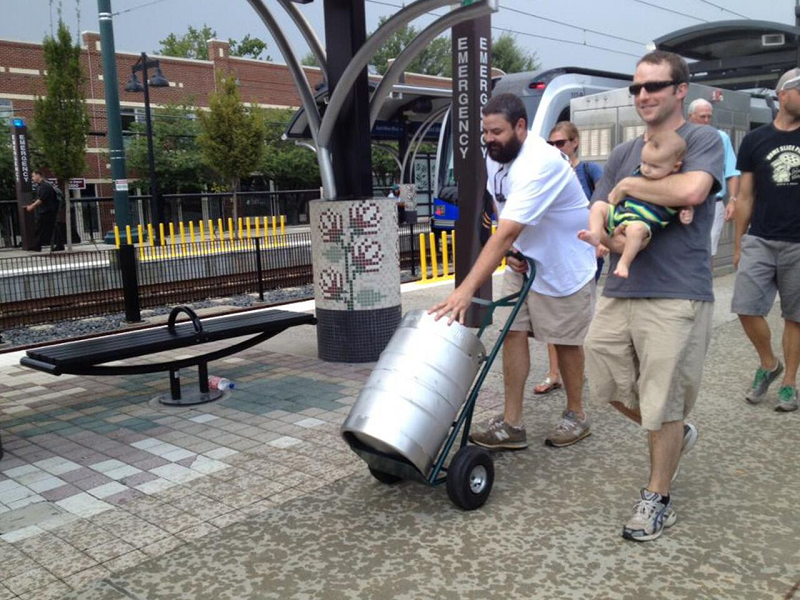
Chris Harker, founder of Triple C Brewing Co., wheels a keg of Light Rail Pale Ale along Charlotte’s LYNX light rail. (Photo by Justin Engel)
In August 2011, Chris Harker, co-founder of Triple C Brewing Co. in Charlotte, North Carolina, walked down a platform along the city’s light rail system, a half-barrel keg of his brewery’s Light Rail Pale Ale on a green dolly as cameras clicked and well-wishers, including relatives, walked along with him.
Harker was delivering the beer to Triple C’s first commercial account—The Liberty gastropub, which also happened to be one stop away along the same light rail. He did not actually take the train the one stop to The Liberty—“the city got wind of it,” he says, and dissuaded him from taking alcohol aboard—but Harker says the brewery wanted to highlight the role the light rail had played in Triple C’s young life.
It was a small, but illustrative moment in the relationship between American small-batch brewing and public transit, in particular the nation’s warrens of subway, trolley and light-rail routes. In some places, the two have grown up around each other—Charlotte’s so-called LYNX system dates from only 2007, a few years before the city’s new wave of breweries would take off.
In all cases, the two have powered a symbiotic relationship: Get back and forth from sampling the latest brews, liberally or not, at a transit cost well under that of even an Uber. In fact, ride-hailing apps such as Uber and Lyft might be the biggest threat to this symbiosis.
In the meantime, anecdotal evidence abounds of the happy relationship between breweries and their proximity to a public transit stop. The hard numbers, too, suggest there’s something about hops and hopping a train.
Putting Beer Cities on the Map
In the summer of 2006, Gail Ann Williams and Steve Shapiro, a married couple living in San Francisco, were planning to attend an IPA festival at The Bistro, a groundbreaking bar in Hayward several miles to the south (the pub had hosted some of the nation’s first festivals dedicated to India pale ales and double IPA).
“You know, you should take BART there; it’s three blocks away,” someone suggested, given the strength of the beers that The Bistro would be serving.
The suggestion planted a seed in the minds of Williams and Shapiro that sprouted the following year into a website called Beer by BART—which is literally what its name implies: a curated guide to breweries, brewpubs, bars and bottle shops near Bay Area Rapid Transit stops.
Beer by BART has grown during the past 10 years from 34 recommendations within one mile of BART stops to at least 112 not only within one mile of a stop—the distance that Williams and Shapiro thought most Americans would be willing to walk before giving up—but near other trains and buses that connect with BART. (The recommendations reflect that some selections have closed or have been taken off the site.)
So great proved the appeal—inexpensive and safe transport to the region’s best beers—that the couple soon had prospective brewers assuring them that they were looking for locations near the San Francisco Bay Area’s trolley and subway system. Brewers wanted in, basically, on the publicity that Beer by BART could provide.
What’s more, Williams and Shapiro became mini-celebrities not just in their own city, but also the world over.
“It’s amazing how many people we meet traveling, including Europe, who say they use this as part of their vacation planning, including for where they should book a hotel,” Williams says.
Similar updated and one-off guides have sprung up in Beer by BART’s wake. And some cities and regions interweave brewery visits with their transit systems. In Phoenix, for instance, a downtown booster group sponsors an annual “Urban Ale Trail,” a “walkable beer tasting tour [that] runs along the light rail corridor from Downtown Phoenix to uptown.” In Charlotte, there’s the 4.5-mile “Light Rail Trail” that not uncoincidentally runs by several breweries and brewpubs (including the aforementioned Triple C).
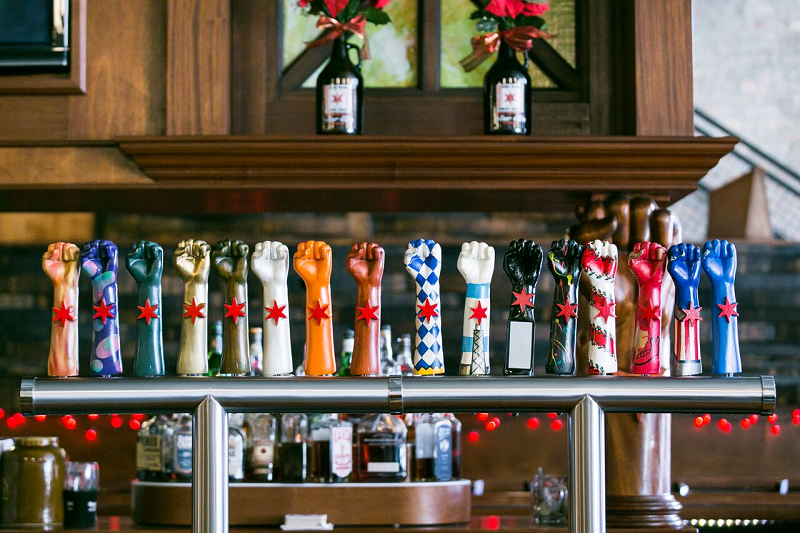
Revolution Brewing has two locations along Chicago’s Blue Line. (Photo courtesy Revolution Brewing)
In Chicago, the Blue Line of the city’s vaunted L system happens to run right from O’Hare Airport into downtown—and past roughly 10 breweries and brewpubs. That includes Revolution Brewing, which opened near the Blue Line’s California stop in 2010 (the company opened a second location near the line’s Belmont stop two years later).
“Nelson Algren called the L Chicago’s ‘rusty iron heart’ because it forms the arteries that connect the city’s people and neighborhoods,” says Josh Deth, Revolution’s founder, referring to the 20th-century novelist. “I got an urban planning degree with a focus on transportation, so forgive me if I get a bit romantic here.”
The Benefits of Building Near Public Transit
Romance or not, that utilitarianism benefits breweries and even draws them close to public transit in the first place.
“We definitely searched out a space and weighed its proximity to public transit in choosing the location,” says Laura Dierks, co-founder of Brooklyn’s Interboro Spirits & Ales, which is less than one-third of a mile from New York City’s L train connecting Manhattan and Brooklyn. “It was part of our decision-making in locating the business from the beginning.”

(Photo by Miguel Rivas)
Fellow Brooklyn operation Other Half Brewing saw things the same way in its 2014 opening near the F and G lines. “We felt lucky that we found a space—really, a garage—that suited our needs and also happened to be on the edge of a great neighborhood, near a subway stop,” says Andrew Burman, co-founder of Other Half. “The reality is, in New York, location is key. Easy access to public transportation can mean a lot for a new business.”
The biggest reason is obvious, given the intoxicating core product of breweries and brewpubs.
“Especially when people are enjoying some fine craft brews, it’s great to have public transit around the corner so they don’t have to drive home,” says Revolution’s Deth.
The proximity can also have fringe benefits, brewery principals say, including lower-cost transportation for brewery staff and advertising opportunities onboard the transit itself (though some systems, including the nation’s largest in New York, forbid alcohol ads).
Perhaps the biggest benefit besides a safe, cheap way home after drinking is what public transportation can bring to a neighborhood. Triple C’s Harker noticed it in his South End surroundings in Charlotte.
Too-quiet streets and empty buildings, including the 20,000-square-foot, high-ceilinged building that Triple C eventually opened in, pocked its future neighborhood. The 4-year-old New Bern light-rail stop offered promise, though, Harker says. And now the brewery-plus-taproom is part of a more vibrant enclave with fresh condos and apartments. Hyde Brewing recently opened across the street from the brewery, and Triple C opened its own new event space next door as well.
“So we get a lot of walk-ins and repeat taproom business from people just because it’s easy for them to come see us,” says Harker.
Public transit stops not only facilitate such activity, but also sustain it once it’s there—sometimes for decades, in the case of the nation’s older systems. The L line in New York City, for instance, dates from the early 1920s, Chicago’s Blue Line from the early 1950s. They were in place long before the current brewing renaissance kicked off in the late 1970s, ready and waiting to help spirit it along.
And they might yet outlive their usefulness to it.
The Rise of Ride-Hailing Apps
Public transportation ridership nationwide spiked to 10.8 billion rides in 2014, the highest ridership in 58 years, according to the American Public Transportation Association, an advocacy nonprofit. In 2015, systems in Chicago and Boston recorded their highest ridership figures ever (the Chicago milestone was for trains alone). The same year, 1.76 billion people rode New York’s system—including a single-day record of 6.2 million straphangers on Oct. 29, 2015.
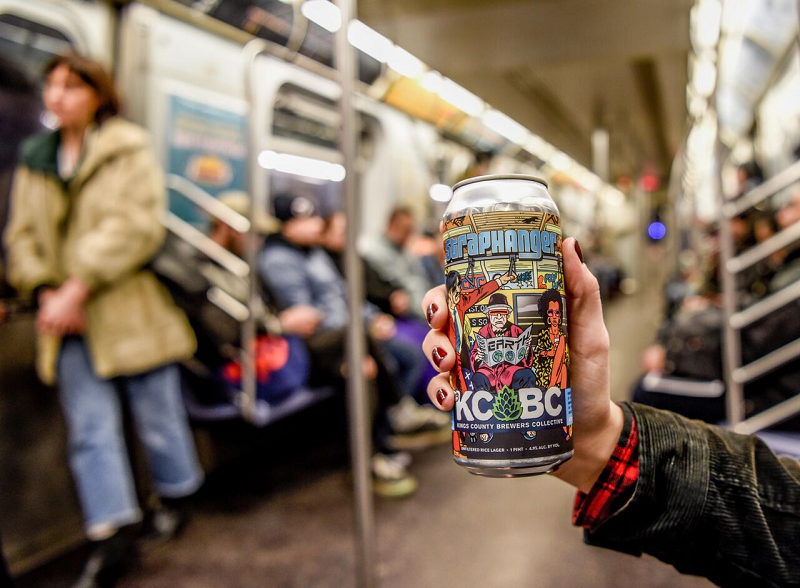
(Photo by Miguel Rivas)
These mid-decade figures, however, might have represented a high-water mark for public transit. Figures from 2016 and 2017 show steep declines in some cases. In Charlotte, bus ridership was down 15 percent for the three years that ended in mid-2017. In Los Angeles, overall ridership was down about 19 percent over a similar period.
Part of the drop is due to aging or inadequate infrastructure. The tracks, tunnels, vehicles, fare machines and other systems simply aren’t up to the task of moving so many millions daily, and that fact manifests itself in delays, re-routings, and even accidents. New York officials, for instance, plan to close the tunnel that carries the L between Manhattan and Brooklyn for 18 months beginning in 2019. It needed repairs before Hurricane Sandy damaged it in October 2012, and now the need is particularly urgent.
Then there’s Uber and its ilk. The rapid rise of ride-hailing apps—Uber launched in 2009, and archrival Lyft in 2012, both initially in San Francisco—has upended the taxi industry. It has also, to a lesser extent, started to eat into public transit with sometimes-competitive fares and typical door-to-door service.
A survey of app users in seven major U.S. metro areas that University of California-Davis researchers administered showed that Uber et al have led to a 6 percent decline in bus use and a 3 percent decline in light rail use among those who have used the apps. The survey’s results, released in 2017, also showed that avoiding driving drunk was the second-most-cited reason for using the apps, right behind avoiding parking headaches.
For now, though, the symbiosis continues. The number of breweries in the U.S. continues to climb, with many opening in cities with already widespread transit systems, or ones that are on the fast train there. New York City has 30 breweries and brewpubs, according to the Brewers Association, and Chicago has 47.
Breweries continue to open near the LYNX light rail in Charlotte’s South End neighborhood, and a new extension will see it head north through the city’s North Davidson and University areas.
Existing breweries in its path stand to benefit, and new ones may spring up as a result. For Harker, there’s little doubt the light rail played a part in his brewery’s success over the years.
“Had it not been for the light rail,” says Harker, “it would’ve been a pretty sketchy proposition to do something here.”
Tom Acitelli is the author of The Audacity of Hops: The History of America’s Craft Beer Revolution. He lives just off the Boston area’s Harvard Square Red Line stop.
The post Taking the Ale Train appeared first on All About Beer.
]]>The post Six to Seek: The Best Beers of the Week appeared first on All About Beer.
]]>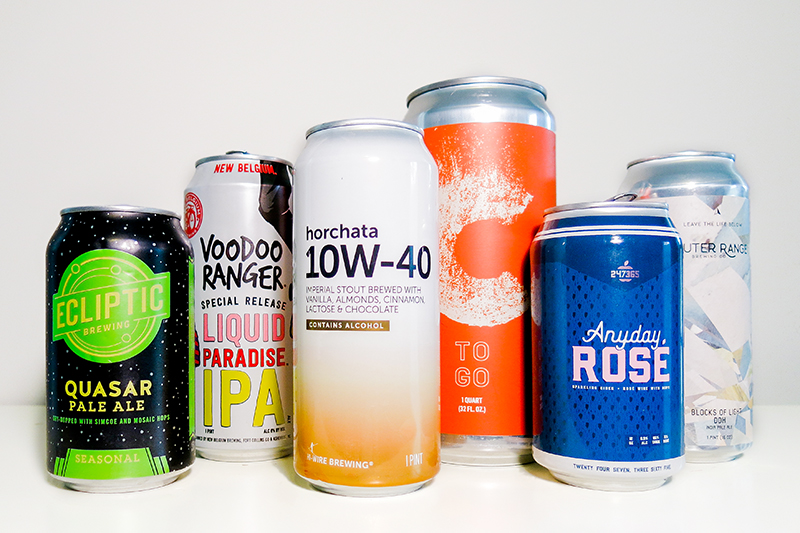
CINDERLANDS FALLING PETAL
Cinderlands Beer Co.
Pittsburgh, Pennsylvania
5.4% | Japanese-Style Rosé Saison
A collaboration with Cinderlands’ neighbors at Umami, Falling Petal is inspired by the Japanese restaurant’s shot of cold sake served with a rose-hibiscus syrup. The word “rosé” on the Crowler was a tip off that we could expect a colorful pour, and indeed Falling Petal is a pretty, pulpy pink. We’ve written recently about the rosé trend and thought we had a clue of what would come next, but Falling Petal defies categorization. The nose on the beer was intriguing and unlike any beer we’ve sampled recently: full of jasmine and lavender notes, a bit of pine, grapefruit and pomegranate. The beer comes across as heavily fruited and yet not sweet; it drinks like a grapefruit mimosa, with some gin botanicals thrown in for good measure.
After tasting, a trip to the brewery’s website would reveal the exotic ingredients responsible for such a unique beer, which included toasted rice, Sorachi Ace hops, Norwegian kveik yeast (plus lactobacillus), and hibiscus, pomegranate, yuzu and Kaffir lime leaf. It’s draft only, but if you find yourself at Cinderlands or Umami in Pittsburgh, it’s a must try.
ANYDAY ROSÉ
Anyday Rosé
Paso Robles, California
6.9% | Blend of Cider & Rosé, Hopped w/ Cascade & Citra
Have we mentioned there’s a rosé trend sweeping through the wine, beer, cider and spirits industries right now? As a blend of cider and rosé hopped with Cascade and Citra, Anyday Rosé hits three of those segments at once. A semi-dry rosé leads off, with the sweeter cider keeping things balanced. On the finish, hop-driven notes of grapefruit, lemon and orange come through. Anyday Rosé is light and spritzy, with a refreshing quality that should appeal to drinkers of wine, cider and beer alike.
ECLIPTIC QUASAR PALE ALE
Ecliptic Brewing Co.
Portland, Oregon
6% | Pale Ale
Ecliptic’s Quasar Pale Ale, hopped with Simcoe and Mosaic, returns for the summer. Bright and vibrant notes of lemon, orange peel and grapefruit, with a little pine. The hop character is big, and the bitterness is super low. While that’s the recipe for most of today’s juicy IPAs, this is a very different animal. It’s a heavily dry-hopped pale ale that drinks easily and cleans up remarkably quickly. The fruity notes come through more pithy than sweet, and with a light body this pale ale is indeed well suited to hot summer days.
OUTER RANGE BLOCKS OF LIGHT DDH
Outer Range Brewing Co.
Frisco, Colorado
6.2% | India Pale Ale
Outer Range last month released a double-dry-hopped version of Blocks of Light, featuring Galaxy and Mosaic hops. Sweet peach and juicy pineapple leap forth from the glass, and on the palate there’s more orange citrus. There’s a decent bitterness, and clearly expressed fruit notes without going overboard into a tangy, fruity mess. While this one’s likely long gone at the brewery, it’s hard to go wrong with any of the brewery’s hoppy offerings.
NEW BELGIUM VOODOO RANGER LIQUID PARADISE IPA
New Belgium Brewing Co.
Fort Collins, Colorado and Asheville, North Carolina
8% | Double IPA
New Belgium’s Transatlantique Kriek made last week’s Six to Seek, but we’d be remiss if we didn’t follow up with the newest IPA in the Voodoo Ranger line. It pours bright gold and only the slightest bit hazy–clearly this isn’t meant to be a full-on New England-style IPA. Mosaic Incognito and Nugget hops contribute tropical notes of papaya and guava, with a decent bitterness. Behind the more tropical flavors and floral notes, and a bit of toasted cracker on the finish.
HI-WIRE HORCHATA 10W-40
Hi-Wire Brewing Co.
Asheville, North Carolina
8% | Imperial Stout w/ Vanilla, Almonds, Cinnamon, Lactose & Chocolate
Stouts inspired by Mexican hot chocolate probably aren’t going anywhere, but now more seem to be drawing inspiration from horchata, the spiced, milky beverage popular in Latin American countries. Small brewers across the country are creating these versions, which favor of a subtle sweetness instead of the spicy punch found in many popular Mexican-style stouts. Goose Island Beer Co. even recently got label approval for a Bourbon County Brand Horchata Stout, though the brewery hasn’t officially named it as one of this year’s variants.
Asheville’s Hi-Wire Brewing has put the horchata treatment on 10W-40, adding vanilla, almonds, cinnamon, lactose and chocolate to its imperial stout. It’s that last ingredient that comes through most prominently, with a nose brimming with unsweetened baker’s chocolate. The rest of the horchata-inspired ingredients are there–subtle cinnamon and perhaps a hint of the almond–but they are balanced by the rich chocolate and roasted barley. The lactose adds a little sweetness of its own, making for a creamy and decadent stout.
The post Six to Seek: The Best Beers of the Week appeared first on All About Beer.
]]>The post Pairing: Beer and Buffalo Wings appeared first on All About Beer.
]]>
(Image via Shutterstock)
No matter how you take them, there’s a beer style that pairs perfectly with your favorite wing sauces and seasonings. Just don’t forget the napkins.
Traditional Buffalo and Helles Lager: The spicy vinegar kick of this classic wing sauce can be tempered by the subtle sweetness and balance of a Helles lager.
Honey Mustard and Berliner Weisse: The light tartness and refreshing quality of a Berliner weisse makes it an appropriate pairing for nearly any wing, but it’s an especially good partner for the tanginess of honey mustard.
Coconut Curry and Belgian Tripel: This Thai-inspired sauce finds a friend in one of Belgium’s most well-known styles. The spicy notes imparted by Belgian yeast—think pepper, clove and lemon—complement the coconut and curry.
Barbecue and Schwarzbier: Light in body yet dark in color, a Schwarzbier’s mild notes of chocolate and coffee are the perfect complement for a sweet and smoky barbecue sauce.
Caribbean Jerk and Scotch Ales: With a sweet blend of caramel and dark fruit notes, scotch ales can cool the scotch bonnet heat of a traditional jerk sauce.
Teriyaki and Belgian Dubbel: Dark malts find their match in the sweeter side of teriyaki sauce, while a Belgian dubbel’s yeast-driven notes of apple and pear play well with teriyaki spices like ginger and soy.
The post Pairing: Beer and Buffalo Wings appeared first on All About Beer.
]]>The post Six to Seek: The Best Beers of the Week appeared first on All About Beer.
]]>
(Photo by Jill McNamara)
NEW BELGIUM TRANSATLANTIQUE KRIEK
New Belgium Brewing Co.
Fort Collins, Colorado and Asheville, North Carolina
6.2% | Oak-Aged Sour Ale w/ Cherries
For the fifteenth year in a row, New Belgium and Belgium’s Oud Beersel have collaborated on Transatlantique Kriek. The beer, this year released in 375-mL, cork-and-caged bottles, is a 50/50 blend of New Belgium’s foeder-aged, sour golden ale and Oud Beersel’s cherry lambic (kriek). From the crimson pour to the nose and palate, cherry dominates. There’s tart cherry and acidity on the nose, and more of the same in the first sip. Move past that initial tartness, though, and you will find more of a syrupy sweetness from the fruit — almost like cherries cooked in a pie. The fruit tempers the pleasant, just-right acidity, and paves the way for a refreshing finish.
BELCHING BEAVER DIGITAL BATH
Belching Beaver Brewery
Vista, California
6.5% | New-England-Style IPA
Digital Bath is the fourth collaboration between Belching Beaver and the Deftones, and the first in the New England style. For this IPA, Belching Beaver used Citra, Galaxy, Mosaic, Nelson and Simcoe Cryo hops to create “something loaded with citrus notes for summer.” The brewery and band have achieved that, with big grapefruit notes and bitter orange. Far from one-note, however, the beer also offers up green onion and an herbal note that almost comes across as thyme. Digital Bath is complex and juicy, with a dry finish that compels another sip.
DOGFISH HEAD LIQUID TRUTH SERUM
Dogfish Head Craft Brewery
Milton, Delaware
7% | India Pale Ale
An attempt at disproving the myth that international bitterness units (IBU) can only be achieved in the boil, Dogfish Head’s Liquid Truth Serum employs a variety of post-boil additions of hops in pellet, powder, leaf and liquid form. On the nose, all of those additions create a sweet orange profile. On the palate there’s more orange as well as grapefruit, but with a surprising amount of lemon and a leafy, fresh-hop character. And, as Dogfish Head hypothesized, there is indeed a decent amount of bitterness courtesy all of those post-boil additions.
LAGUNITAS SUPER CLUSTER
Lagunitas Brewing Co.
Petaluma, California and Chicago, Illinois
8% | Double IPA
Lagunitas Brewing Co. calls its newest beer a “citra-hopped mega ale of intergalactic proportions,” but we’ll call it a double IPA. There are big, juicy notes of grapefruit, pineapple and tangerines, as well as a little bit of an herbal, peppery quality from the hops. As the beer warms, notes of sweet orange and bready malt peek through past the dankness. Be it a double IPA or “citra-hopped mega ale,” Lagunitas has another worthy hoppy offering on its hands.
EDMUND’S OAST VIRIDI REX
Edmund’s Oast Brewing Co.
Charleston, South Carolina
9.5% | Double IPA
From a semi-hazy pour comes an assertive, complex aroma of honey, fresh-cut grass and candied peaches. The first sip yields citrus, namely tangerine and orange peel, as well as a slight “catty” note. There’s just a touch of alcohol on the finish, though given the ABV it’s not unexpected or the least bit off-putting. The beer’s sweet, juicier notes are well balanced with its bitterness, and Viridi Rex finishes semi-dry.
OLDE HICKORY APPALACHIAN WALKER
Olde Hickory Brewery
Hickory, North Carolina
10% | Brandy-Barrel-Aged Barleywine
An annual release for Olde Hickory Brewery, Appalachian Walker is the brewery’s Irish Walker barleywine aged for more than a year in barrels that once held brandy. That base beer has taken home several awards of its own, but the time spent in the brandy barrels is transformative. There are layers of dark fruit flavors, raisin and fig covered in caramel and, of course, brandy. It is a full-bodied beer, with a touch of alcohol heat. If you’re like me you won’t mind the warmth, as this is a smooth sipper. That said, I wouldn’t begrudge you for stashing a bottle away for a cold winter’s night to see how it develops with a bit of age.
The post Six to Seek: The Best Beers of the Week appeared first on All About Beer.
]]>The post Authentic and Independent: A Taste of Hershey, Pennsylvania appeared first on All About Beer.
]]>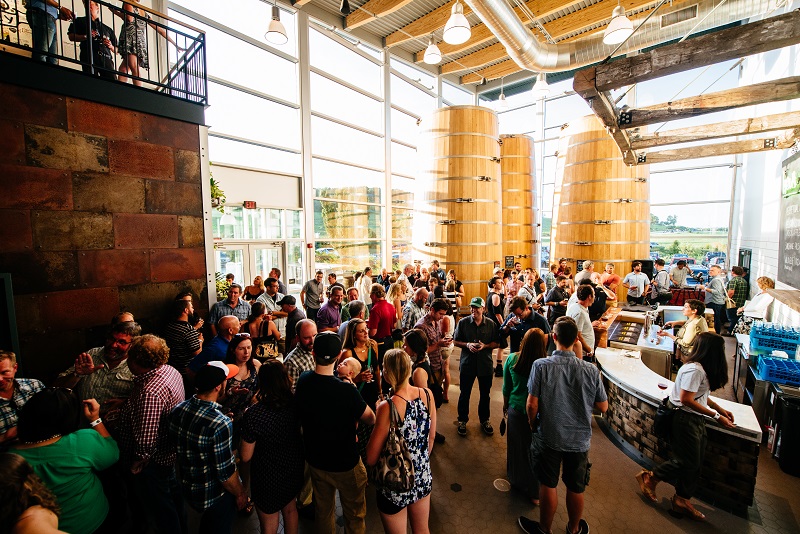
(Photo courtesy Tröegs Independent Brewing)
An invitation from Tröegs Independent Brewing
As I stood atop Peters Mountain along the Appalachian Trail taking in views of the Susquehanna River, I felt more alive than I had in a long time. I may say that I work for my beer and have grand visions of weekends spent exploring the great outdoors with a stop at a local brewery after to hoist pints and compare stories of adventure. But, if I’m being honest, most weekends are spent tossing bags with one hand and downing a well-loved IPA or three from my neighborhood brewery with the other.
Which was what led me to spend the morning hiking a section of the Appalachian Trail: to experience something new, adventurous, and, most importantly, authentic, with the journey eventually culminating at Tröegs Independent Brewing–a brewery I’ve long admired for the rebellious nature with which they brew cult classics like Mad Elf, Troegenator, and Nimble Giant. If beers this audacious are readily available throughout their distribution footprint, I couldn’t wait to try offerings held closer to home like the sour and wood-aged beers from the brewery’s Splinter Series.
But Tröegs would have to wait. First, there was plenty to explore in Hershey.
A Taste of Downtown Harrisburg
I worked up quite an appetite from my hike, so I headed to the Broad Street Market in nearby downtown Harrisburg. The sheer volume of vendors hawking everything from fresh produce and grass-fed beef to prepared foods is unlike any market I’ve experienced in much larger cities, but I have to remind myself that Hershey and Harrisburg are unlike any place I’ve been before. Locals pride themselves in the entrepreneurial spirit that has lived for generations on family farms and within Mennonite and Amish communities. This same spirit influenced John and Chris Trogner to open Tröegs in 1997.
I ordered an ice cream cone–717 Cherry made with antibiotic free dairy from a local farm and churned in small batches–from Urban Churn and began to peruse the food stalls for lunch. The variety spanned everything from Puerto Rican to Korean and Pennsylvania Dutch. I couldn’t decide, so I ordered an international buffet for one–West African okra soup from Tasty Dishes, bacon-fried cabbage pierogies from Pikowski’s Pierogi Place, and Jamaican oxtail from Porter House–and watched as families enjoyed lunch together and business men popped in for a boxed lunch to bring back to their desks.
A few blocks down the road from the Broad Street Market is the Pennsylvania State Capitol. I’m not typically one to tour state capitol buildings, but enough locals urged me to give it a shot. “It’s the most beautiful in the country,” said the passenger next to me on the plane. She was right. From the rotunda inspired by Michelangelo’s St. Peter’s Basilica to the ornately decorated Senate, Congress, and Supreme Court chambers, the building is truly the palace of art that architect Joseph Huston intended, with lifesize murals depicting Pennsylvania history and messages of just governance flanking the walls.

Pennsylvania State Capitol (Photo courtesy Bryan Richards)
I next turned my direction from the area’s past to its future at Millworks, located adjacent to the Broad Street Market. Among the rafters and creaky floors of the old mill’s second floor are a patchwork of working artist studios, where artists like weaver Jenna Carls, potter Erin Dean, and filmmaker/photographer Caleb Smith make their living.
Back downstairs in Millworks’ restaurant, I feasted on a dinner of creative ways to infuse local ingredients into modern dishes–a starter of macaroni and cheese made with local cheeses from the Lykens Valley Creamery and a main of wood-grilled trout with seasonal vegetables and a chimichurri vinaigrette–all washed down with local brews. My night is almost complete. Almost. I wrapped up the evening across the river at Grotto Pub, a hearty Midwestern dive bar where I’m greeted by friendly locals and my first taste of Tröegs on draft.
A Day at the Museum
My plan to kayak Swatara Creek was thwarted by thunderstorms. A warm cup of coffee in front of the fireplace at Cocoa Beanery and a conversation with the barista sent me museum hopping instead, starting with the National Civil War Museum.
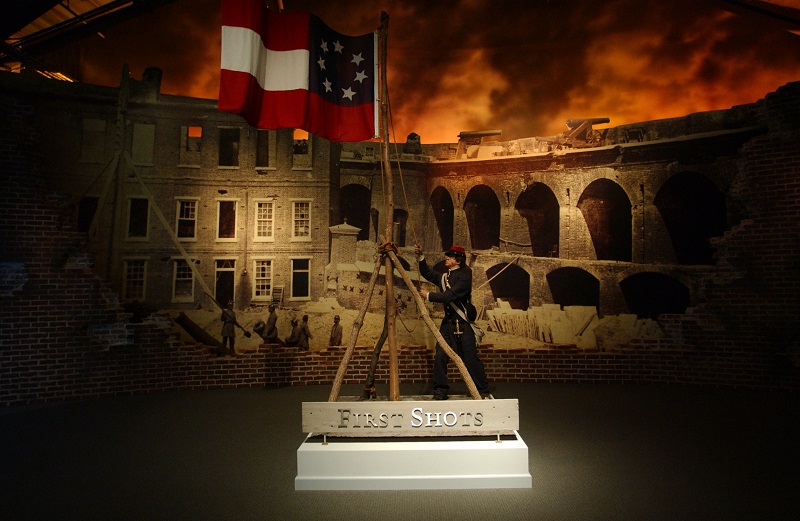
(Photo courtesy the National Civil War Museum)
I spent a few hours contemplating the battlefields and stories of our country’s darkest days. The experience is narrated by 10 voices. Each tells a unique story from the war–a freed slave, a southern farmer, three brothers torn by the conflict, etc. I’m still chilled by the voice of the eldest brother, a soldier for the Union army, narrating a letter to his wife about how disappointed his father would be to know one of his sons cowardly fled to the West and the other was fighting in the rebellion against the federal union. The displays covered more than the strategies and battles that decided our country’s fate and the why’s from both the Confederate and Union sides; they were about people, tragedy, rebuilding, and healing.
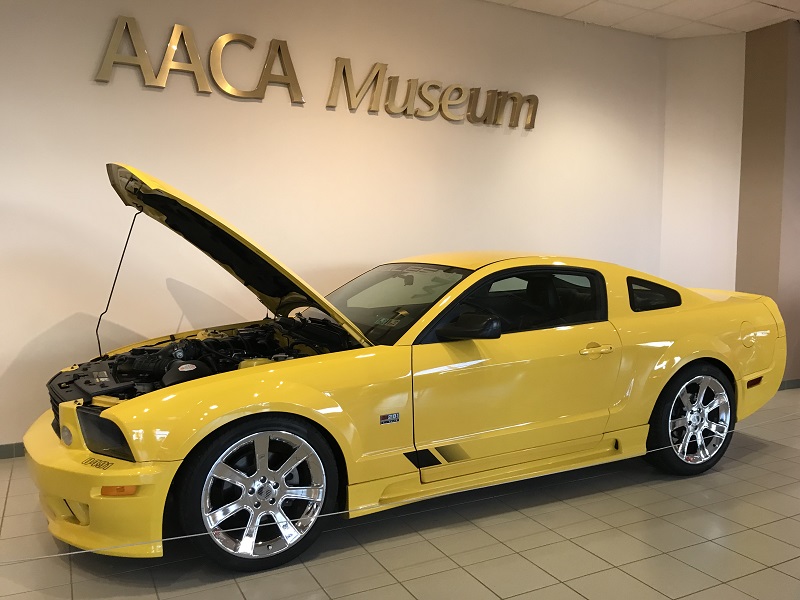
(Photo courtesy the AACA Museum)
As awe-inspiring as the National Civil War Museum was, I needed something to lift my spirits back up and headed over to the AACA Museum in Hershey for a walk down another history lane. This one is filled with big-block engines, mag wheels, and the bus from the movie Speed. Yes, the kid in me came to life as I stared upon a 1966 Shelby GT350, like the one my dad used to own. I began to relive my own fast and furious days of souped-up Mustangs and a need for speed–you know, the days before minivans and soccer practice.
Jacked up on adolescent adrenaline, I pointed my rented Kia Soul toward Tröegs–the reason for my trip to Hershey.
The Tröegs Experience
I was greeted at Tröegs Independent Brewing with a break in the clouds. The patio and beer garden were filling up with craft beer faithful looking to soak up some rays. Already, I was thinking of joining them with a citrusy and piney Perpetual Imperial Pale Ale (the ultimate pairing for the now steamy weather), but my attention was diverted towards three towering foeders highlighted by floor to ceiling windows in the front corner of the building. I wanted to not only know what’s aging away, but to also try what they’re producing.
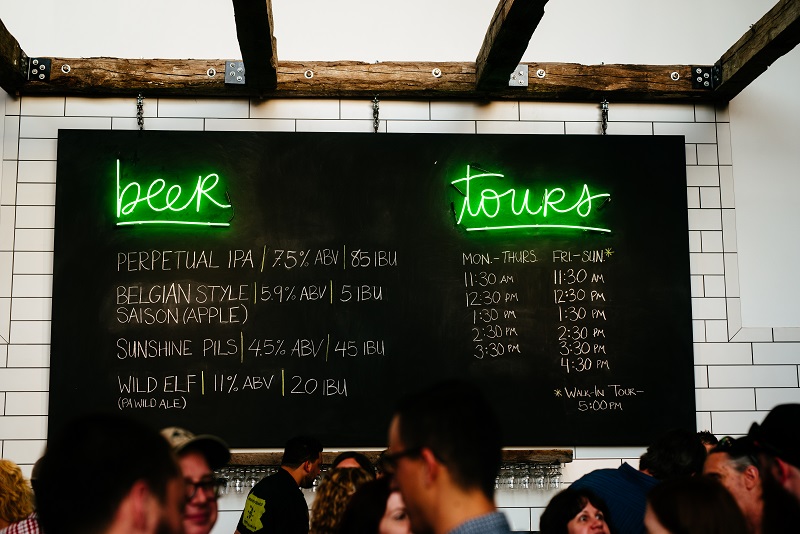
(Photo courtesy Tröegs Independent Brewing)
As I stared up at the signs identifying what each foeder housed–a Wild Elf brewed in September 2016, another from July 2017, and a soured Belgian dubbel called Splinter Bronze–I felt a little tingle down my spine thinking about what’s happening inside those 21-foot-tall oak monoliths. My daydream was interrupted by one of the tour guides, Christie, who offered a tour. While I’m not one to go on brewery tours–once you’ve seen one, you get the premise–Christie reminded me that Tröegs’ brewery tour is one of the most highly rated in the country. Plus, it starts with a welcome beer. On this particular day, that beer was a pour of the aforementioned Wild Elf, a wild cherry ale aged to perfection on oak. Sold.
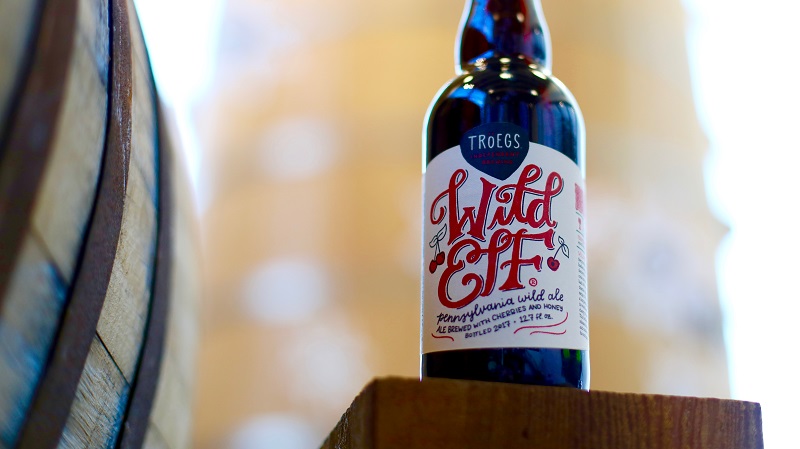
(Photo courtesy Tröegs Independent Brewing)
Beer in hand, we headed up to the Art of Tröegs Gallery, where Christie gave a summary of the brewery’s history. We were given a few moments to peruse the gallery, where fan favorites and winners from the brewery’s annual Art of Tröegs contest are displayed. An eclectic mix of art dot the walls, like a whimsical “Renaissance” style portrait of co-founders Chris and John Trogner, a pair of Nike Dunks with a tailored upper made out of Tröegs’ beer labels, and a 3-liter bottle that’s cut to look like it’s being zipped open.
The tour continued into the brewhouse with a bit more on the brewing process than most include. Just when the talk was about to get, well, boring, Christie delivered a humorous aside about the first time the Trogners brewed Mad Elf. John arrived at the brewery on a Saturday morning to lead a tour, only to find the entire place soaked in cherry juice. The beer was rather innovative for its time, and the brothers failed to account for how rapidly the juice would ferment. Stories like this raise my respect for Tröegs. They don’t brew normal beers, but instead push the boundaries and are rewarded for their efforts with a rabid fan base.
Another highlight of the tour was the green beer sample. I beer geeked out over a pour of the First Cut Mango IPA. The hops were grassier and more abrasive than the final packaged product where the Comet and Simcoe hops complement the exotic mango notes with a bitter citrus pop.

(Photo courtesy Tröegs Independent Brewing)
After the tour, I perused the beer menu above the bar in the taproom. I wanted to order what I came here to try–Troegenator from the source. But, I also felt compelled to try something different, something I haven’t tried before. I chose a beer from Tröegs’ Scratch Beer Series–where the brew team experiments with new ideas, recipes and brewing processes. I opted for the Perpetual Darkness–a dirty blond barleywine meets double IPA–and paired the refined toffee and sticky citrus notes with a starter of poutine fries with bone gravy and cheese curds and a main of duck confit with fried gnocchi.
As I sopped up the remaining bone gravy with my last fry, I contemplated another round. I wanted to see how else Tröegs pushes the brewing envelope and ordered a bottle of Dear Peter from the brewery’s Splinter Series. The tantalizing sour is brewed with nectarines from a nearby farm bruised during a hailstorm and aged on oak. As Tröegs proves, what’s too ugly for a roadside farmstand still works perfect for beer.
The beer itself was deceiving. The aroma delivered a bouquet of ripe, juicy nectarines with hints of oaky vanilla and a slight funk. On the tongue, the beer presented a nuanced battle of funk and ripe fruit that seemed to sum up my trip to Hershey and Tröegs.
Tröegs isn’t your typical brewery experience. Like so many other establishments in Hershey, it’s authentic and shaped by makers who truly care for their craft.
Bryan M. Richards is a beer, food, and travel writer based in Charlotte. His work has appeared in All About Beer, Men’s Journal, and just about anything with the word Charlotte in it. Follow his adventures on Instagram at @brichwrites.
The post Authentic and Independent: A Taste of Hershey, Pennsylvania appeared first on All About Beer.
]]>The post Decoding the English Pub appeared first on All About Beer.
]]>
(Stock image courtesy Shutterstock)
The English pub is much romanticised, even mythologised, which must leave some visitors disappointed when they encounter the real thing. Having been brought up in and around pubs our whole lives, reading them and negotiating them is a matter of instinct for us, but here we have tried to put the subconscious knowledge into words.
First, let’s look at two extremes: the tourist trap, and the death trap. The former looks like a pub, calls itself a pub, and might even occupy a building that was once a pub (or inn, or tavern) for centuries. Inside, however, you will find something not much better than the Rose & Crown Dining Room at Disney World. The décor will be tasteless bordering on kitsch, there won’t be many locals drinking there and the beer is unlikely to be anything special. You will end up paying over the odds for substandard food and drink consumed in a joyless, plastic setting.
The latter are more usually referred to as “rough pubs,” but not to their face of course. These days, you’re unlikely to find one of these unless you’re a very adventurous traveller because many have been demolished or converted, while the more substantial buildings have been given corporate makeovers—not tacky or exploitative, merely inoffensive. But if you wander into side streets, the outer suburbs, or into the shade of concrete tower blocks, you might still come across the kind of pub where it is possible for an innocent abroad to get into trouble. There aren’t many exterior clues other than a general state of disrepair, although with experience you develop a kind of sixth sense based on the state of the curtains or some subtle hint implied in the signage.
The good news is that if you make the wrong call and find yourself in a pub where you oughtn’t be, it will usually be made clear to you, as long as you are reasonably fluent in the language of passive-aggression. It might, for example, take a long time to get served, if the person behind the bar acknowledges you at all. You might get asked point blank if you are a police officer, which happens to us not infrequently—something about our flat feet, perhaps. Or the regulars might start a loud, pointed conversation about strangers, or foreigners, or people wearing whatever colour hat you happen to be wearing. We once walked into a pub only to be greeted by five men in soccer shirts, one of whom simply pointed and said: “No, no—turn round and walk out. Now.” We did so. Sometimes, though, the tests are more subtle: change from five pounds when you paid with a ten-pound note, for example, or an ostensibly jovial comment to which there is definitely an impossible-to-guess wrong answer.
The problem is that many of the very best pubs, and the most charming, don’t look or feel superficially much different to rough pubs. Unpretentious is perhaps the best word. The pub’s seating will be well-worn, possibly even ripped or stained here and there. If there are carpets, they will have a subtle scent of stale beer, but there are more likely to be well-trodden floorboards. Don’t expect elaborate bathroom facilities, either—just be relieved if there is a lock on the door and a bar of soap on the basin.
Really rough pubs will usually offer no food beyond packets of crisps. Posher, more sterile pubs will have full menus, pushed hard, and may even have the nerve to put out cutlery and placemats. The unpretentious pub, those in our sweet spot, will often have the perfect compromise: pork pies (cold), beef pies (hot), Scotch eggs, Cornish pasties, pickled eggs, or basic bread rolls in plastic wrap. Hearty, often delicious, but functional, these snacks—which are definitely not “meals”—tend to be served with nothing more decorative than a dollop of mustard on the side of the plate.
Even in these warmer, less scary pubs it is possible to commit faux pas. Being too loud in a quiet pub, for example, will earn you dirty looks—one of the most potent weapons in the British passive-aggressive arsenal. Though it’s unlikely anyone will ever say it out loud, you’re also expected to rent your space by consuming a certain amount of drinks: ordering a half pint of bitter and two glasses of tap water for a party of three, then nursing them for more than an hour, is bad form. And arriving in a large group is also likely to irritate regulars. Pubs are set up for parties of two, four, perhaps six, even eight at a push, but turn up in a group of 15, each member of which is paying for his or her own drink with a credit card—we’ve seen this happen—and you’ll feel the atmosphere chill.
On the flipside, it doesn’t take much to ingratiate into the life of an English pub. A brief greeting and a nod of recognition to anyone sitting at the bar won’t do any harm. A clear, unambiguous order—”A pint of London Pride, please”—is generally welcome. Having the right money, or something close, often goes down well, too. (Definitely don’t try to pay with a £50 note under any circumstances.) When you’re done, bringing your empty glass back to the bar is a good idea. Lots of English people don’t even do this anymore, preferring to sit among their glasses until harassed staff get round to sweeping the bar for “empties,” but it’s a simple act of politeness that goes a long way. If your round includes a pint of Guinness, which takes longer to pour, it’s a mark of a pub pro to ask for that before other drinks.
Tipping isn’t usual in “proper pubs,” but there’s sometimes a jar on the bar, or a charity collection box. If you really want to make friends, though, because you’re planning to spend the evening, or come back the next night, you can say, “And one for yourself?” The person behind the bar will either decline or say something like, “Oh, that’s very kind—is a half of lager alright?” They might actually drink a half-pint of lager but will probably put the money on the back bar “for later.” There’s a small risk they’ll exploit your kindness—”Oh, thank you sir. Double of the 18-year single malt OK?” It’s up to you to decide if you think it’s worth the risk.
Unlike Germany, there aren’t usually seats reserved for regulars, although we sometimes like to check if we’re in a strange pub: “Ahem … if we sit here, are we stealing someone’s usual spot?” Again, it shows that we know our place, as outsiders. In many parts of the U.K., sitting on a stool at the bar shows that you’re keen to engage in conversation while taking a table generally suggests that you’d like to be left alone.
The point is, in the end, you won’t really get to experience the pub if you take the easy route to the obvious pub on the main drag. Be brave and remember the bark is usually worse than the bite.
Proper Pubs
The Bull & Bladder, AKA the Vine
Dudley, West Midlands
The taphouse for cult brewery Batham’s, this pub is all muted warm wood, corners and gossip in thick local accents. Enjoy a pint of mild with a crusty roll overflowing with cheddar cheese and stingingly raw white onion.
Star Inn
Crowlas, Cornwall
If you head to Land’s End and Poldark country, stop here on the way. It’s a village pub and well-used, with slate floors designed to withstand farmers’ boots and the residue of Atlantic gales. There’s no food at all beyond pork scratchings and chocolate bars but it does have superb, good value ales brewed on site, fuelling a lively but civilised atmosphere.
The Merchant’s Arms
Hotwells, Bristol
We moved to Bristol in the summer of 2017 and have become fascinated by this pub, which feels like a relic of 50 years ago. It’s small, brown and out of the way, frequented mostly by middle-aged bitter drinkers with one eye on whichever sporting event is being shown on the TV.
Royal Oak
Borough, London
Our favourite pub in London, close enough to the centre for convenience but far enough away to feel like part of the real London where people really live. (For now, at least.) It is weathered without being grubby and the service, in true London fashion, can be brusque, but a pint of Harvey’s Sussex Best and a salt beef sandwich is a hard combo to beat.
The Grey Horse
Central Manchester
This centrally located pub in one of Britain’s greatest cities ought to be a tourist trap, except Manchester doesn’t really go in for that kind of thing. A tiny, one-room pub, it has a vague psychic partition—sit at the back and murmur to your significant, or stand at the front and joke with your pals. You’ll find cask ales from Hyde’s along with pork pies and plentiful people-watching.
Jessica Boak and Ray Bailey have been blogging at boakandbailey.com since 2007. They were named 2014 beer writers of the year by the British Guild of Beer Writers. Their most recent book is 20th Century Pub.They live in Bristol in the west of England.
The post Decoding the English Pub appeared first on All About Beer.
]]>The post Six to Seek: The Best Beers of the Week appeared first on All About Beer.
]]>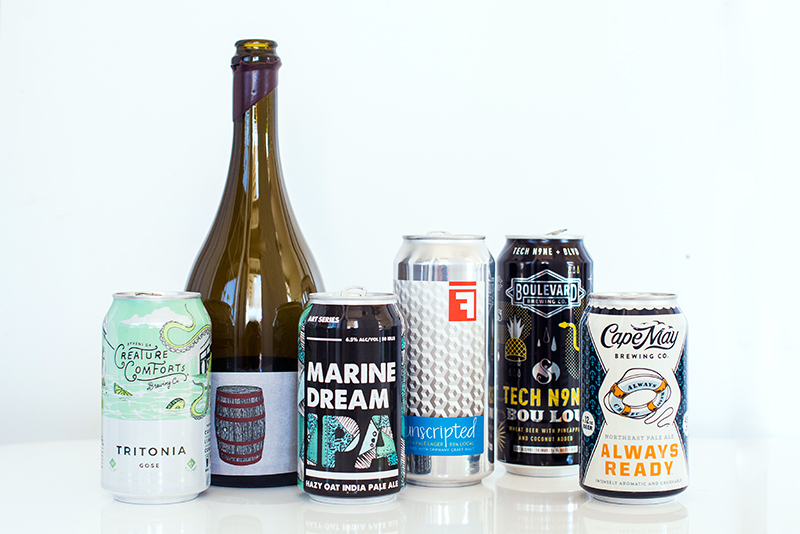
(Photo by Jill McNamara)
FULLSTEAM UNSCRIPTED
Fullsteam Brewery
Durham, North Carolina
5% | India Pale Lager
A collaboration with the new, mid-century-inspired Unscripted Durham, this beer is as retro and contemporary as its namesake. It’s a throwback in that it’s at its heart a lager, but made modern in its use of local malt (from Durham’s Epiphany Craft Malt) and trendy hops (Mosaic, Galaxy, Citra and Simcoe). Those hops give off a distinct lemon note in the aroma, which on the palate is joined by light grapefruit, pine and orange peel, with a crackery malt character. None of those flavors, though, are so bold that you lose sight of the crisp and clean lager base. There are a lot of poorly executed India pale lagers out there, beers so inundated with hops that you can’t distinguish whether it’s an ale or a lager. This isn’t one of them. It’s balanced and bright, everything you would want in an India pale lager.
BOULEVARD BOU LOU
Boulevard Brewing Co.
Kansas City, Missouri
5.5% | Wheat Ale w/ Pineapple & Coconut
Breweries partnering with bands and musicians is nothing new, but one genre often overlooked in these collaborations is hip-hop. That’s changing. Deltron3030 collaborated with Dogfish Head on Positive Contact, Nappy Roots recently brewed with Against the Grain Brewery and Monday Night Brewing, and now Tech N9ne has partnered with Boulevard Brewing Co. Bou Lou, named after Tech N9ne’s song “Caribou Lou,” is inspired by the cocktail from that same song. There’s no Malibu Rum, but the wheat beer is brewed with pineapple and coconut. Both of those ingredients are there but in perfect harmony; it achieves that tropical profile that so many IPAs are going for right now, but courtesy the fruit instead of hops. There’s a hint of vanilla, too, and the wheat beer base is refreshing and cleans up quickly.
CAPE MAY ALWAYS READY
Cape May Brewing Co.
Cape May, New Jersey
4.8% | Northeast Pale Ale
An homage to the Coast Guard and its base in Cape May, Always Ready isn’t, unfortunately, always available. It’s a seasonal that runs through this month, however if you’re lucky enough to see it around you should do yourself a favor and pick up some cans. Always Ready offers a big hop punch of pine and pithy citrus, with a satisfying bitterness. And it does it all in a well balanced, sub-5% package. If you miss Always Ready, keep an eye out for upcoming hoppy offerings from Cape May Brewing Co.
CORONADO MARINE DREAM
Coronado Brewing Co.
San Diego, California
6.5% | Hazy Oat India Pale Ale
The second in the brewery’s new Art Series, Marine Dream is brewed with oats, London III yeast and Citra, Vic Secret and Mosaic hops. Given these ingredients and the word “hazy” on the can, you might expect it to look as murky as many others on the market. Instead it pours bright orange and only slightly hazy, but it’s an attractive beer from the jump. The nose is more dank than tropical, with green onion standing out. On the palate, though, juicy notes of orange peel and pineapple come to the fore, along with a bit of juniper and watermelon rind. There’s a decent bitterness and the oats lend the beer a creamy body. While it doesn’t jump headfirst into the New England style, it’s a tasty IPA from a brewery that’s been making such beers for quite a while.
CREATURE COMFORTS TRITONIA – CUCUMBER & LIME
Creature Comforts Brewing Co.
Athens, Georgia
4.5% | Gose w/ Cucumber & Lime
You can smell the cucumber in this beer well before the glass reaches your lips. On the nose, it’s difficult to discern much more, but the cucumber is actually more subdued on the palate. Tritonia lacks the lactic, tart-bordering-on-sour quality that many American goses have, but this makes the beer all the more refreshing and allows the lime and salt to come through. Make no mistake: you’ll need to like cucumber to enjoy this beer, but it is certainly no novelty. The cucumber departs quickly in the finish, where a wheatiness lingers. With a clean, refreshing quality and light tartness, this beer would pair well with lighter fare (we’re thinking salad or sushi).
PURE PROJECT / CELLADOR SCYNDICATION
Pure Project Brewing & Cellador Ales
San Diego, California
8.1% | Flanders-Style Red Ale
Released back in March, Scyndication is a collaboration between Pure Project Brewing and Cellador Ales that spent time in brandy, bourbon and red wine barrels. It’s the latter that is most noticeable in the aroma, but the barrels become tougher to pick out individually on the palate — the mark of a blender who knows what they are doing. The beer’s sourness and acidity are well balanced by sweet and jammy flavors such as tart cherry, plum, concord grape and caramel, with a dry oakiness on the finish. It feels light in the mouth, and all the more drinkable for it.
The post Six to Seek: The Best Beers of the Week appeared first on All About Beer.
]]>The post Grimm Artisanal Ales Opens First Brewery and Taproom appeared first on All About Beer.
]]>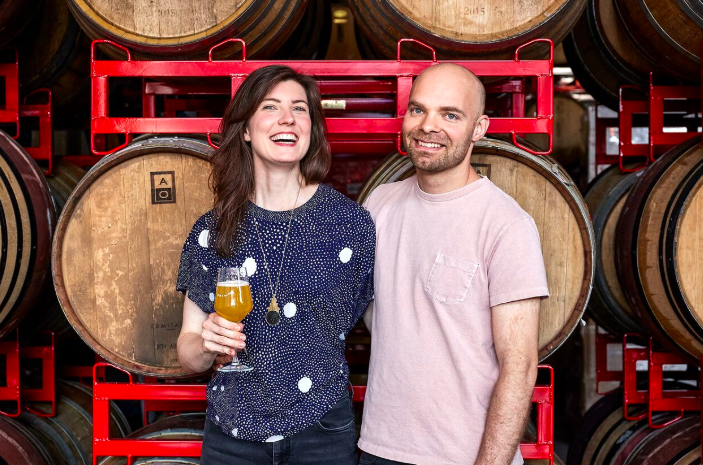
(Photo courtesy Grimm Artisanal Ales)
BROOKLYN, N.Y.—Acclaimed Brooklyn brewers Grimm Artisanal Ales open their highly anticipated first permanent brewery and taproom in East Williamsburg [990 Metropolitan Ave between Morgan Ave and Catherine St; www.grimmales.com]. Founded by artists Lauren and Joe Grimm in 2013, Grimm has been producing sought-after beers for the last five years on an itinerant basis out of other existing commercial breweries — a practice known as “gypsy brewing.” In that time, the business received numerous recognitions, including first place awards at The Great American Beer Festival, the country’s premier blind-tasting competition, and being named New York City’s Best Local Brewery by The Village Voice, among other accolades. Lauren and Joe Grimm were also just celebrated by the Small Business Administration with their “2018 Young Entrepreneurs of the Year” award.
NEW BREWERY OFFERINGS:
Grimm’s new brewery allows them to expand production, experiment, and debut new styles of beers. In a beer scene obsessed with freshness, the new facility will allow the public to drink Grimm IPA at the absolute peak of brewery-fresh flavor, having been canned the previous day. By dedicating one fourth of their brewery’s 7,500 square footage to the aging and conditioning of barrel-aged sour beers, Grimm will also expand their sour beer program to include these unique and elusive beers and will be the first New York City brewery to focus on longterm oak-aged sours as a regular menu offering, which is a style known for its difficult and involved process.
The taproom opens with 10+ draft beer lines, bottle-conditioned oak-aged sour beers, a selection of New York State wine and cider, as well as locally-made sodas.
Each Saturday at 10am, Grimm will release new beers. Beers debuting on opening day Saturday, June 30th are:
- Flow State — Lauren and Joe have been working on this beer since they founded Grimm five years ago. It’s a Golden Sour aged in oak for one year and saison aged in orange bitters barrels for three years. It is fermented with a mixed culture and dry hopped with Galaxy hops. (6% alc/vol). Only available in 750ml champagne-style bottles to-go and as pours in the taproom.
- Today’s Special — American Pale Ale featuring Mosaic, Citra, Simcoe, and Ekuanot hops (5.5% alc/vol). Available on draft in the taproom and in 16 oz cans to-go (four packs)
- Zero Anniversary — Double IPA featuring Mosaic, Galaxy, Bravo, Simcoe, and Sorachi Ace hops (8% alc/vol). Available on draft in the taproom and in 16 oz cans to-go (four packs)
- Future Days — Golden Sour Beer fermented with a mixed culture, blended from select oak barrels six to eighteen months in age, and dry hopped with Mosaic hops. Only available in 750ml champagne-style bottles to-go and as pours in the taproom.
- Lilt — Golden sour beer fermented with a mixed culture, blended from select oak barrels six to eighteen months in age, and refermented with four pounds per gallon of tart Montmorency cherries. (6% alc/vol). Only available as bottle pours in the taproom
- Tracery — Saison de Coupage, a traditional Belgian farmhouse style in which barrel-aged sour beer is blended with fresh saison. Grimm’s coupage is a blend of 70% young saison and 30% barrel-aged golden sour. (6% alc/vol). Only available as bottle pours in the taproom
MIDDLE EASTERN-INSPIRED FOOD BY SAMESA:
Grimm is partnering with Eli and Max Sussman of the Middle Eastern-inspired restaurant Samesa in Williamsburg to offer a menu that pairs well with Grimm beers. The menu features Samesa favorites such as Chicken Shawarma Melt (chicken, green zhug, shredded cheddar on a pita and grilled, served with purple slaw), the Samesa Board (pita chips, marinated feta, taramosalata, muhammara, olives, spicy salami), and Pumpernickel Pita and Dips, which will feature a rotating seasonal special dip made with Grimm beer.
MINIMALIST DESIGN:
Grimm partnered with inc_a — a new New York City-based firm founded by David Bench and Jonathan Chesley. Reflecting Grimm’s unique visual brand, inc_a designed the industrial space to have a playfully minimalist aesthetic. Bright white walls are softened with Lynchian red velvet curtains wrapping the 45-seat taproom. Tropical plants soak up the abundant natural light, and a blanket of warm incandescent bulbs hangs overhead. The taproom sits toward the front of the space, overlooking the stainless steel production equipment in the back area, which includes a 30bbl brewhouse, 60bbl and 90bbl fermenters, as well as over 160bbl’s worth of oak barrels dedicated to aging sour beer. Additional notable elements include a large bar topped with custom spalted maple and heart pine taproom tables fabricated by Tri-lox. Playful custom wallpaper created by artist Gretta Johnson (also also designed Grimm’s custom glassware) decorates the bathroom walls, and is reflected in infinity mirrors helping to reinforce the fun and playful identity of the brand.
ABOUT GRIMM:
Founded by partners Lauren and Joe Grimm in 2013, Grimm has captured the attention of craft beer fans with its limited-edition, award-winning beers and creative branding (all beer labels are also designed by Lauren, Joe and friends). Operating with no permanent address, Grimm has nevertheless been at the epicenter of beer’s current renaissance, achieving international renown as creative innovators of craft beer’s hottest new forms, such as dry-hopped sour ales and “juicy” Northeast-style IPA. The Grimms re-envisioned beer as an ongoing, ephemeral creative stream by brewing new, limited-edition recipes every month, accompanied by ever-changing label art by the Grimms and and their friends.
To support the opening of their first permanent brewery, Grimm received a $4.2M loan through the New York Business Development Corporation – an entity whose mission is to encourage economic development throughout the five boroughs while working to create and retain jobs for New Yorkers.
For more information visit grimmales.com and follow Grimm on Instagram: @grimmales and on Facebook: @grimmales
The post Grimm Artisanal Ales Opens First Brewery and Taproom appeared first on All About Beer.
]]>The post Flanders Red Chicken Pozole appeared first on All About Beer.
]]>
(Photo by Jackie Dodd)
Pozole is such a classic Mexican dish that nearly every family that grew up eating it, grew up with a different variation. Some like it with a red chili base, others prefer the verde version. Some recipes call for pork, chicken, fish or even goat. In its most classic form, pozole is hearty, filling, full of beautifully slow-cooked meat and filled with a nice helping of hominy. Don’t forget the toppings—they are an essential component to balancing the flavors of the dish. Pineapple beers, with their tropical flavors and bright pop of acidity, pair perfectly with the deep, rich, spicy flavors of a hearty bowl of pozole.
Ingredients
2½ pounds chicken (bone-in: thighs, wings and/or drumsticks)
1 teaspoon salt
1 white onion, quartered
1 large carrot, chopped
2 ribs celery, chopped
12 ounces Flanders red beer
3 pounds hominy from a can, rinsed and drained
4 cloves garlic
1 teaspoon dried cilantro
1 teaspoon dried oregano
1 teaspoon black pepper
½ teaspoon cumin
Garnishes
¼ whole green cabbage, thinly sliced
1 large tomato, chopped
1 large avocado, chopped
½ large red onion, chopped
½ cup cilantro, chopped
½ cup crumbled cotija
½ cup red radishes, thinly sliced
2 limes, cut into quarters
2 large jalapeños, chopped
Tortilla chips
Preparation
1. Place chicken pieces in a large pot, cover with about 2 ½ quarts of water, salt, onions, carrot, celery and half of the beer, stir to combine. Bring to a boil, reduce heat and simmer, uncovered, until the chicken is tender and cooked through, about 30 minutes.
2. Remove chicken from pot, allow to cool slightly. Using two forks, pull chicken meat away from the bones, shredding into pieces. Reserve the meat, return the bones to the stock pot. Continue to simmer the bones, uncovered, for 45 minutes.
3. In a blender or food processor, add half of the hominy, garlic cloves and 2 cups of the stock from the pot. Blend until smooth.
4. Strain the broth to remove and discard the bones, then add in the pureed hominy. Stir in the chicken meat, cilantro, oregano, cumin, pepper, remaining hominy and beer. Bring to a simmer and cook for an additional 10-15 minutes.
5. Serve the pozole alongside the garnishes, allowing guests to garnish as they choose.
The Chef’s Pairings: Pineapple Beers
Brewers continue to experiment with specialty ingredients, pushing the boundaries of flavor. Since a good beer deserves a good meal, All About Beer Magazine asked Jackie Dodd, founder of TheBeeroness.com, to taste a few beers brewed with pineapple and offer tasting notes and pairing suggestions. Get more pairing ideas and recipes at allaboutbeer.net/food.
The post Flanders Red Chicken Pozole appeared first on All About Beer.
]]>The post Keeping Cool: As Barrel-Aging Trends Up, Brewers Go Below appeared first on All About Beer.
]]>Founders Brewing Co. has undergone several expansions in Grand Rapids over the last two decades, both at its original brewery and taproom as well as at a new facility that specializes in barrel-aged beers. The brewery’s progress has been easy to see for locals and tourists visiting the city, but one of its biggest areas of expansion is hidden from public view.
About three miles away from the brewery, and far below the streets of Grand Rapids, 14,000 barrels of beer quietly age.
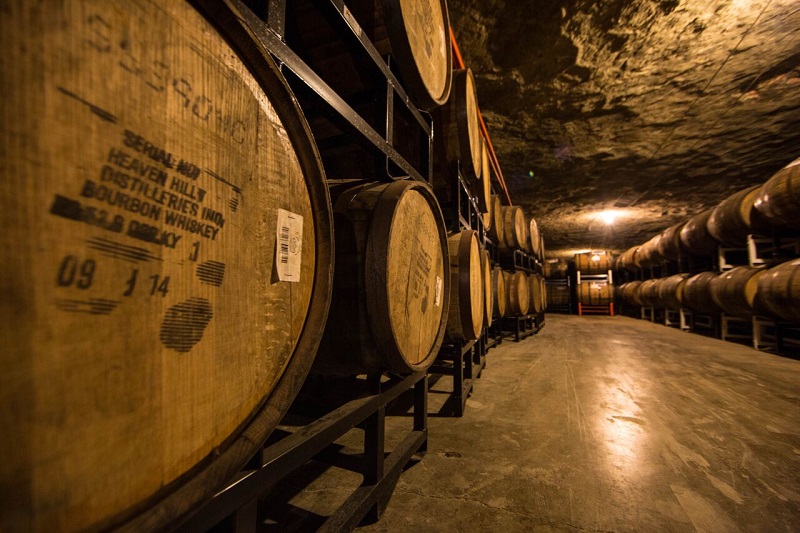
(Photo courtesy Founders Brewing Co.)
The barrels are located in former gypsum mines once owned by the Alabastine Mining Company, and now by Michigan Natural Storage. The mines maintain a steady temperature of 50 degrees Fahrenheit or lower, which makes them ideal for storing a number of products—especially beer.
“The level that we’re on, we’re 85 feet below the surface of the earth and it’s about 38 million years old,” says brewery co-founder Dave Engbers. “I asked if they found fossils or stuff like that, and they said where we were predates any living organisms. The ceiling is under an old lake bed.”
The brewery stored its first barrels in the mines around 2004 or 2005, estimates Engbers. Founders had started aging beers in barrels just a few years before, and soon after the barrels were taking up space at the brewery that needed to be used for additional fermentation capacity.

Many of Founders Brewing Co.’s best-known beers are aged in former gypsum mines. (Photo courtesy Founders Brewing Co.)
Engbers and co-founder Mike Stevens had a friend at Michigan Natural Storage who proposed aging barrels there, which made a lot of sense given the facility’s proximity to the Grand Rapids brewery. Now, some of the brewery’s most well-known beers—like KBS and Backwoods Bastard—spend time maturing in the mines.
The underground aging program at Founders may be novel, but aging beer underground is nothing new. Whether manmade or natural, more brewers are going underground with their barrel-aging programs.
A Return to Tradition
In the days before refrigeration, brewers—especially those specializing in lagers, which ferment at lower temperatures than ales—sought out underground spaces to age their beers. It was a common practice at breweries across Europe, and when German immigrants built breweries in the United States, many of them looked for underground cellars that could provide the cooler temperatures needed.
August Schell was one such brewer. Schell left Germany for the United States in 1848, and in 1860 built the Schell’s Brewery in New Ulm, Minnesota. Schell had cavernous cellars beneath the brewery dug out, creating a space to store barrels of the brewery’s lager.
Jace Marti remembers cleaning out the caves as a boy—and not fondly.
“I think that was one of those things that my dad did a little as punishment, but also as an initiation thing,” recalls Marti with a laugh. “There was no light down there, it was terrifying as a kid.”
Now, as a sixth-generation brewmaster at August Schell Brewing Co., he uses the caves to age his own beers. In 2015, the brewery reopened the caves, where currently 55-56 bourbon barrels reside.
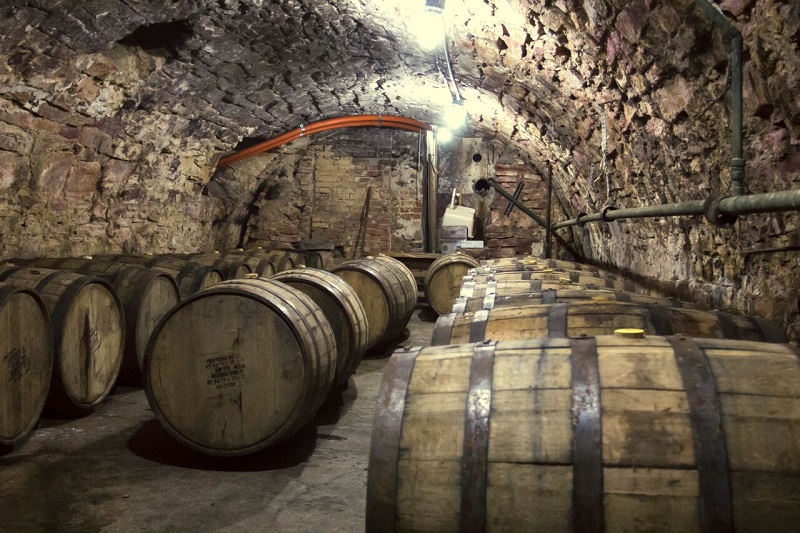
The caves at August Schell Brewing Co. (Photo courtesy August Schell Brewing Co.)
True to the brewery’s heritage, these barrels almost always contain lagers of some kind—though they are quite different from the styles August Schell brewed so many years before. The base beers, says Marti, sometimes don’t fit neatly into style guidelines, but usually they are a “big, malty lager in the 10 percent range.”
The caves typically stay in the upper 30 degrees in the winter, and can reach 50 degrees in the summer. Marti says that the differences in temperature between the seasons imparts differences in the character of the beers—namely, that in the summer months the warmer temperatures help extract more flavor from the barrels.
“I think what we’re trying to achieve is more than a standard lager beer,” says Marti. “Having some variations in temperature is good for what we’re doing. A lot of the yeast is pretty much gone, and now we’re just trying to pick up residual spirit character and barrel character. It’s very different than what we were trying to accomplish 100 years ago.”
The Challenges of Aging Underground
Having access to a subterranean space, while rare, is just the beginning for breweries wishing to age underground. The unpaved floors, jagged walls and inconsistent dimensions of these spaces often necessitate a more labor-intensive process than simply storing barrels in a warehouse.
Michigan Natural Storage renovated its gypsum mines with elevators and concrete floors, but getting barrels to the facility still requires a lot of work from Founders.
“The barrels are on racks so they get unloaded from our facility, then brought over to their facility,” says Engbers. “And then they’ve got two industrial elevators. All of that adds to the cost and the labor.”
But at least Engbers has forklifts, and racks on which to store the barrels. The caves at August Schell Brewing Co. aren’t as accommodating.
“It’s a monumental pain,” says Marti. “We have to use different sections of the cave. We take half of the barrels in from one entrance, and the other half through another.”
Laborious though that that process is, work was much harder for the generations of brewers that came before Marti. In the late 19th century, teams would cut ice blocks from the nearby Cottonwood River and pull them by horse up the hill and into the cellars, where the ice would help maintain the necessary temperatures to lager the beers through warmer months.
Marti’s brother tried to replicate the experience once, pulling the old ice tong’s right off the wall of the brewery’s museum. He went down to the river with a chainsaw and lugged a block into the cellars, only to see it melt in a matter of days.
“We won’t be doing that again,” says Marti.
And, of course, another challenge when it comes to aging underground is having the space in the first place. Not every brewery is located miles away from mines that go far below the Earth’s surface, or above cavernous cellars.
At Santa Fe Brewing Co., founder Brian Lock decided to make his own underground cellars, though “underground” here is used a little more loosely.
“They’re not very far underground, they’re inside a bermed hill that they’re put up against,” says Lock. “But they do get a lot of the thermal consistency from being underground. The temperatures are pretty stable, which is great for barrel aging beer.”
Lock had six shipping containers leftover after building his taproom in Albuquerque, and wanted to put them to good use at the Santa Fe location. So they dug out the hill and placed the containers on concrete footings, then sprayed insulation and backfilled around the containers.

(Photo courtesy Santa Fe Brewing Co.)
The brewery is located in the high desert, notes Lock, but with an elevation of 7,000 feet it’s cooler than many people realize. The six 40-feet-long containers stay at a pretty consistent 60-65 degrees Fahrenheit in the summer. In the winter, the brewery uses space heaters to ensure the containers don’t get too cold.
The underground portion is used to age the brewery’s sour beers, and there’s a small tasting room for sampling. In the future, says Lock, there will be a cave bar that the brewery will open up for special occasions.
The Future is Dark
Despite the challenges that come with aging beers underground, there are breweries eager to carry on the tradition. Earthbound Beer opened last year in St. Louis, Missouri, a city that is no stranger to underground cellars; Anheuser-Busch and Lemp Brewery both were built above the tunnels of a natural cave system. Earthbound inherited cellars of its own, as it now occupies the former Cherokee Brewery space. While the nascent brewery has but a few barrels stowed away at the moment, the owners do have plans to expand their cellars (with the possibility of bringing a foeder and coolship below as well).
Even breweries that don’t have natural caves running below the property are experimenting with underground aging. Brewery Ommegang of Cooperstown, New York, once stowed away Hennepin and other beers in Howe Caverns of upstate New York. Though the brewery no longer ages beer at the caverns, the partnership could serve to inspire other breweries.
Wabasha Brewing Co. is located less than half a mile from the Wabasha Street Caves in St. Paul, Minnesota, and actually produces a beer by the name of Cave Stout, with imperial and bourbon-barrel-aged variants. The plan has always been to age that beer in the nearby the caves, says co-founder and head brewer Brett Erickson. While he has received permission to do so from the caves, Erickson wants to wait until the brewery’s barrel-aging program has grown before moving any production.
And even though Founders has an astonishing 14,000 barrels of beer aging in the former gypsum mines, there may even be room there for a few more players.
“This was kind of our little secret after a while,” says Engbers. “Then the word got out and next thing you know there’s a couple other breweries that store stuff down here.”
For Engbers, it might be easy enough to store thousands of barrels beneath the streets of Grand Rapids. Hiding them is another thing altogether.
Daniel Hartis is the editor of All About Beer Magazine.
The post Keeping Cool: As Barrel-Aging Trends Up, Brewers Go Below appeared first on All About Beer.
]]>The post Hi-Wire Brewing Announces Plans for Taproom in Durham, N.C. appeared first on All About Beer.
]]>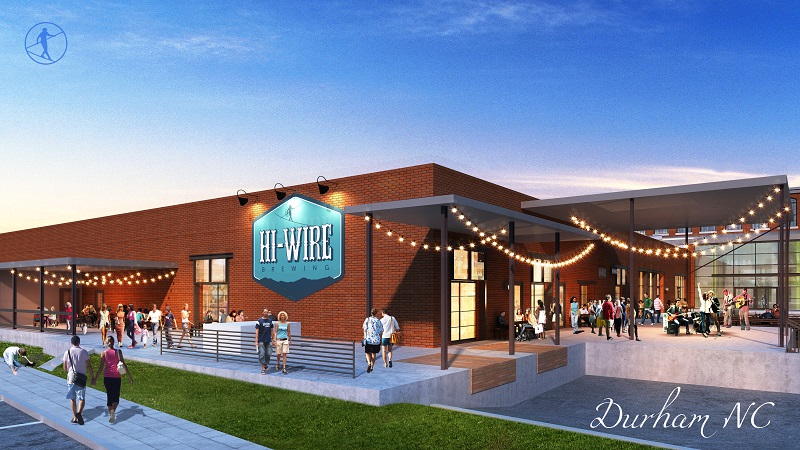
(Mockup courtesy Hi-Wire Brewing)
(Press Release)
DURHAM, N.C.—Durham, NC has always been a dream destination for Hi-Wire Brewing owners Chris Frosaker and Adam Charnack. Alive with an eccentric culture, a booming music and arts scene, endless boutique restaurants, and an active political community, Durham, NC has always seemed like a natural fit for the Asheville, NC-based brewery.
Yep, that’s right folks, Hi-Wire Brewing will be opening its third taproom, currently referred to as the “Durham Fun Zone,” in Downtown Durham in late 2018. The taproom will be located at 800 Taylor Street at the Golden Belt campus. Golden Belt is an historic 320,000 square foot mill that once housed textile and tobacco facilities, and is the only remaining 1900s-era conversion opportunity of its kind in the area.
Hi-Wire’s new taproom will consist of 8,844 square feet of interior space, as well as a 1,678 square foot outdoor covered patio and beer garden. Dubbed the “Durham Fun Zone,” the space will be game and activity heavy, featuring full-sized shuffleboard courts, soccer pool tables, table tennis, and more. The bar’s 24 taps will feature Hi-Wire’s full line-up of beers, including year-round, seasonal, specialty, sour, and one-offs, as well as wine, local cider, and guest taps from neighboring Durham breweries. Space will be dedicated to a potential pilot brewing system in the future.
Strategic growth has always been a part of the Hi-Wire vision. Co-owner, Adam Charnack reflects on where Hi-Wire Brewing started just five years ago and notes, “the Raleigh/Durham/Chapel Hill Triangle is Hi-Wire’s second-largest market behind Western North Carolina, and one of the first we ever distributed to. We’ve felt for some time like it’s a second home to us, and we’ve been looking for ways to root ourselves in the community. So while a taproom outside of our two primary breweries wasn’t necessarily part of our Day-One-Business-Plan, we’ve realized how important it is both for Hi-Wire and for our fans to have more ways to connect with the brewery. We’ve been looking for the right opportunity for some time now, and feel as though we’ve really nailed it with our new Durham spot. Hopefully our customers will appreciate and understand our commitment to the area, and either take their love of Hi-Wire to the next level, or, if they’re not really familiar with us just yet, get to know Hi-Wire for the first time – both in our new taproom but also at bars, restaurants, and retail outlets in the community.”
The goal is to open by end of October 2018, but as we all know, construction can have a mind of its own. With that in mind, Hi-Wire Brewing will be regularly updating their website and social media with formal announcements regarding construction, hiring, an opening date, etc. For the most up to date information, please visit hiwirerewing.com or follow them on social media at @hiwirebrewing.
About Hi-Wire Brewing
Located in Asheville, NC, Hi-Wire Brewing is known for producing approachable and balanced lagers and ales, most notably Hi-Wire Lager, Bed of Nails Brown, and Hi-Pitch Mosaic IPA. They have two locations in Asheville: the 27,000 square foot Big Top Production Facility & Taproom located half a mile from the Biltmore Estate and the South Slope Specialty Brewery & Taproom located in the South Slope area of Downtown, which has a focus on wild and sour ales. Hi-Wire was awarded the gold medal at the 2016 Great American Beer Festival® in the German-Style Maerzen category for their Zirkusfest Oktoberfest Lager. Most recently, they took home bronze in the Wood and Barrel Aged Beer category at the 2018 World Beer Cup® for their Dry Hopped Brett Pale Ale. Hi-Wire Brewing’s award-winning beers can be found on draft and in bottles across North Carolina, South Carolina, Tennessee, Georgia, Ohio, and Kentucky. To learn more about the company, visit hiwirebrewing.com.
The post Hi-Wire Brewing Announces Plans for Taproom in Durham, N.C. appeared first on All About Beer.
]]>The post Anchor Steam is now Available in 19.2-ounce Cans appeared first on All About Beer.
]]>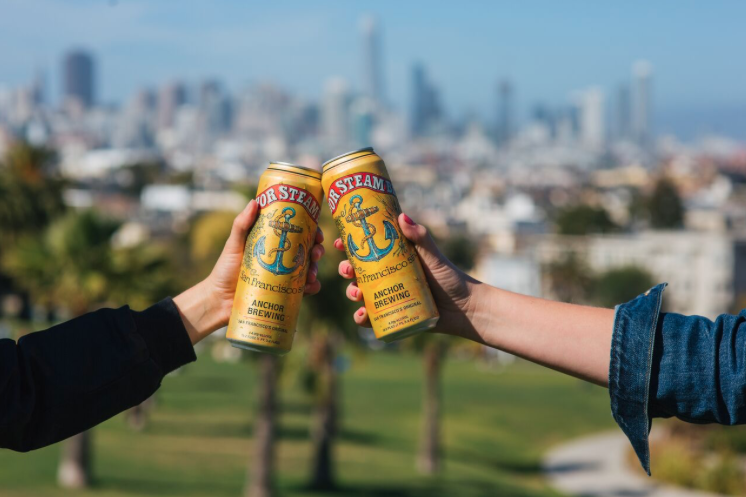
(Photo by Erin Conger)
(Press Release)
SAN FRANCISCO–Anchor Brewing Company announces a new spin on Anchor Steam® Beer, San Francisco’s original since 1896. Arriving just in time for summer adventures, Anchor’s flagship beer is now available in cans for the first time and this 19.2oz offering gives
In 1965, Fritz Maytag acquired and revived the struggling Anchor Brewery. Anchor Steam (4.9% ABV) was the first handcrafted beer to be revitalized in America after Prohibition starting a revolution in beer that originated today’s craft beer movement. In 1971, Fritz Mayt
“No matter how many new beers we create, we never stop celebrating our flagship brew,” said Anchor Brewmaster Scott Ungermann. “
Anchor Steam Beer derives its unusual name from the 19th century when “steam” was a nickname for beer brewed on the West Coast of America under primitive conditions and without ice. While the origin of the name remains shrouded in mystery, it likely relates to the original practice of fermenting the beer on San Francisco’s rooftops in a cool climate. In lieu of ice, the foggy night air naturally cooled the fermenting beer, creating steam off the warm open pans. Today, Anchor Brewing is the only American brewery that still employs open fermentation on a commercial scale. Although
Anchor Steam owes its bright copper color, frosty tan head, and rich, distinctive flavor to this unique, historic brewing process. It is a process that combines deep respect for brewing tradition with many decades of evolution to arrive at a unique approach: a blend of pale and caramel malts, fermentation with lager yeast at warmer ale temperatures in shallow open-air fermenters, and gentle carbonation in Anchor’s cellars through an all-natural process called kräusening.
With flavors of mild toasted malt and a touch of caramel, Anchor Steam is balanced by bright, piney hoppiness. It has aromas of toasted bread crust maltiness followed by bright evergreen Northern Brewer hops and floral esters. A smooth and velvety mouthfeel is accompanied by lively bubbles from the natural kräusening process and a crisp, bright hop finish. It pairs well with any seafood dish, steak with caramelized onions, and grilled portobello
Anchor Steam cans are available in a convenient single size or easy to grab 4-pack nationwide. Find a beer near you using the Anchor Beer Finder.
For more information on the history and craft of Anchor Steam Beer, please watch the following video: Anchor Steam Beer Video. Learn more about Anchor Brewing at www.anchorbrewing.com and follow @anchorbrewing on social media.
About Anchor Brewing Company
Anchor Brewing Company’s roots date back to the California Gold Rush making it one of America’s oldest breweries. Its Anchor Steam® Beer is San Francisco’s original since 1896. In 1965, Fritz Maytag acquired and revived the struggling brewery at a time when mass production of beer dominated and seemed unstoppable. Maytag started a revolution in beer that originated today’s craft beer movement. An undisputed icon, Anchor is America’s first craft brewery where beers are handmade in our traditional copper brewhouse from an all-malt mash. At Anchor, we practice the time-honored art of classical brewing, employing state-of-the-art methods to ensure that our beers are always pure and fresh. We know of no brewery in the world that matches our efforts to combine traditional, natural brewing with such carefully applied, modern methods of sanitation, finishing, packaging and transporting. To learn more visit www.anchorbrewing.com.
The post Anchor Steam is now Available in 19.2-ounce Cans appeared first on All About Beer.
]]>The post Six to Seek: The Best Beers of the Week appeared first on All About Beer.
]]>
PINTHOUSE PIZZA BAILING ROOM
Pinthouse Pizza
Austin, Texas
7.2% | India Pale Ale
Austin’s Pinthouse Pizza took home three awards at last month’s World Beer Cup in Nashville, including bronze for Bailing Room in the American-style India Pale Ale category. It’s easy to see why this one stood out in the most heavily entered category of the event. The beer pours with the brightness and clarity of a traditional West Coast IPA, but it offers an abundance of the sweet, tropical notes found in the more trendy New England style. In this case it is mostly pineapple and peach, complemented by a distinct dankness.
FINBACK SOCIAL FABRIC
Finback Brewery
Queens, New York City
8% | Double-Dry-Hopped Double India Pale Ale
Finback Brewery’s Stellar Wind was one of our Top 25 Beers of 2017, and the brewery continues to impress–especially with its hoppier offerings. Grapefruit and orange peel stand out on the nose, but the first sip yields super juicy, expressive notes of pineapple, tangerines and mandarin oranges. More dank, earthy notes come through as the beer warms, and behind the hops you can find a glimmer of wheatiness.
MIDDLE BROW HOW IT STARTS
Middle Brow Beer Co.
Chicago, Illinois
5.5% | American Wild Ale
How it starts is with a whiff of huge herbal notes from the glass, namely lavender and dill. The Brettanomyces makes its presence known, creating one of the most memorable noses we’ve had on a beer in some time. Those herbal notes and a very light funkiness come through on the palate as well, and if you let the beer warm you might even find the slightest hint of cinnamon. Motueka hops contribute notes of lemon and lime, bringing this one somewhere between a pale ale and an American wild ale. Whatever you call it, this beer is as refreshing as it is challenging and complex.
SINGIN’ RIVER CITRACABRA
Singin’ River Brewing Co.
Florence, Alabama
4.7% | Dry-Hopped Sour Ale
Given the beer’s name and loud label, we expected a super acidic kettle sour–the kind of profile that seems to characterize most quick sours these days. Instead, we found the exception to the rule. The beer exhibits a balance that belies the ‘80s-inspired artwork. The nose is all lemon and orange peel, a pleasant soft citrus. There’s a distinct tartness on the palate, but it’s nowhere near as brash as many of today’s kettle sours. The dry hopping contributes more Lemonhead candy and orange pulp, and the beer finishes with a nice balance between bitter and sour. Built for the heat and humidity of an Alabama summer, but refreshing no matter where you are.
ODELL ONOLICIOUS
Odell Brewing Co.
Fort Collins, Colorado
6.5% | American Wild Ale
The latest in Odell Brewing Co.’s Cellar Series, OnoLicious is billed as a “Tropical Fruit Sour.” And while there is indeed an assertive sourness, it passes quickly and invites another sip, where you’ll find papaya, mango, pinot grigio and a flourish of grapefruit on the finish that comes through like a dry-hop character. In OnoLicious, Odell nails the refreshing summer sour so many brewers are going for these days. While many in that segment are fruited goses or Berliner weisse, Odell here uses its substantial barrel program to create a cellar-aged beer bursting with the fresh flavors of summer.
EPIC OAK AND ORCHARD – STRAWBERRY RHUBARB
Epic Brewing Co.
Salt Lake City, Utah
6.9% | Oak-Aged Wild Ale w/ Strawberries & Rhubarb
After running through a gauntlet of berry beers, we expected this strawberry sour to pour some shade of red. Instead, this new offering in Epic Brewing’s Oak and Orchard series pours a cloudy gold, perhaps because the strawberries were added later in the process. The strawberry does come through subtly in the aroma and more noticeably on the palate, where it is joined by pineapple, white grape and green apple, and a sweetness that helps balance the beer’s mouthpuckering sourness.
The post Six to Seek: The Best Beers of the Week appeared first on All About Beer.
]]>The post Full Circle: Breweries and Distilleries Share Barrels appeared first on All About Beer.
]]>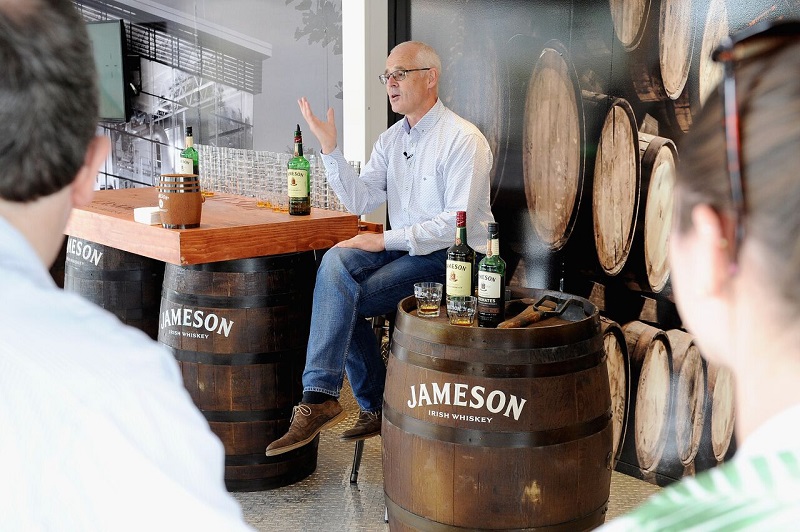
Dave Quinn speaks at Jameson Irish Whiskey’s Love Thy Neighbor event in Brooklyn last October. (Photo by Craig Barritt/Getty Images, courtesy Jameson Irish Whiskey)
Last October, at Jameson Irish Whiskey’s Love Thy Neighbor festival, a small collection of brewers coalesced in the Duggal Greenhouse located on Brooklyn’s waterfront. Outside, Dave Quinn, the head of whiskey science at Jameson, guided patrons through the production (and thematic pairings) of the event’s focus—stout-barrel-aged Jameson Caskmates whiskey. Inside, brewers showcased specialty Jameson barrel-aged beers alongside standard offerings, as drifting patrons snacked on pretzel necklaces, bánh mì-inspired fried chicken sliders and lettuce wraps to the tune of live music and falling jumbo Jenga stacks.
“You’re either going to make some memories or lose some,” says one festival-goer.
As a prominent and popular debut for Jameson’s new Caskmates whiskey, the event spoke to an increasingly intimate relationship between spirits and beer. Coming on the heels of programs from Rogue Ales and Spirits, New Holland Brewing, Anchor Brewing Co., Deschutes Brewery and many others, Jameson’s move to tie its brand to the craft beer industry isn’t novel. It is, however, notable due to the distillery’s status as an international player.
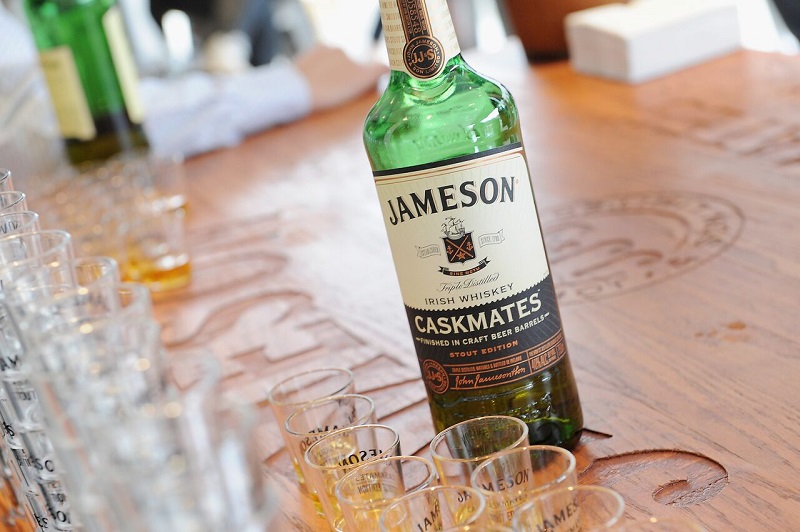
(Photo by Craig Barritt/Getty Images, courtesy Jameson Irish Whiskey)
What Jameson’s Caskmates represents, instead, is how much consumer awareness and interest has expanded relating to the coming together of beer and whiskey—an expansion that can be seen, too, in the recent rollout of Goose Island’s collaboration “Bierschnaps” (aged in former Bourbon County Barrels) with Rhine Hall Distillery in Chicago, as well as in the unveiling of Two Lanterns Whiskey, which is distilled from Samuel Adams Boston Lager by Berkshire Mountain Distillers.
“Every whiskey, at its core, is basically distilled beer,” says Alan Dietrich, the chief executive officer of Bendistillery, which partners with Deschutes Brewery to make Black Butte Whiskey from the mash of the brewery’s signature porter. “Just like brandy is distilled wine, and vodka and gin are distilled grains, whiskey is a distilled malt beverage.”
Highlighting the Connection Between Beer and Spirits
New Holland Brewing and Artisan Spirits anticipated consumer interest when it first released its Beer Barrel Bourbon in 2012. Inspired by the flavor variations and nuance of Scotch aged in barrels that formerly held sherry, New Holland president Brett VanderKamp decided to age the distillery’s whiskeys in barrels that once held the brewery’s Dragon’s Milk stout.
“The brand [Beer Barrel Bourbon] came out in 2012,” wrote Layne Keuning, marketing coordinator for New Holland.
“The first year we sold about 500 nine-liter cases [of the Bourbon] and this year we will be closer to 7,500 nine-liter cases.” Next year, she adds, New Holland anticipates sales closer to 10,000 cases.
New Holland’s Beer Barrel Bourbon is intimately related to its frothier brethren in multiple ways. The malt bill has an uncharacteristically high barley content, though it still meets the necessary grain requirements to be legally classified as a bourbon (which is to say corn constitutes at least 51 percent of the mash). And while not all Dragon’s Milk batches are aged in New Holland’s used whiskey barrels due to scale—there are five barrels in the Dragon’s Milk program for every one barrel in the Beer Barrel whiskey program—all Beer Barrel Bourbon is aged in barrels that housed Dragon’s Milk and then blended, like Dragon’s Milk, for consistency.
“It adds a layer of complexity, it adds more mouthfeel, and it kind of just smooths some of the rougher parts of the bourbon off,” explains VanderKamp. Joel Armato, retail beverage specialist at New Holland, adds that subtle notes of vanilla and cocoa and sweetness carry from the stout to the whiskey, too.
Dave Quinn, the head of whiskey science at Jameson, detailed similar effects of the beer barrel-aging process throughout his educational seminars at Love Thy Neighbor.
“The new whiskey combines the triple distilled smoothness of Jameson Original with the richness of stout beer, adding notes of coffee, cocoa and hops for a truly unique finish,” he wrote in an email following the event. Following last year’s stout-barrel-aged whiskey, Jameson also released a Caskmates whiskey aged in barrels that once held IPA.
To both capitalize upon and promote this heightened consumer engagement, New Holland offers and even encourages customers to try Dragon’s Milk and Beer Barrel whiskey side-by-side to discover the products’ singularities and similarities in its taprooms.

The distillery at New Holland Brewing and Artisan Spirits (Photo courtesy New Holland Brewing and Artisan Spirits)
At those taprooms, patrons can try the whiskey as samples or small pours alongside beers like Dragon’s Milk, or they can order the spirit on its own, as part of flights, and in cocktails such as The Dude, which combines the Beer Barrel Bourbon with a Dragon’s Milk reduction, chocolate bitters and cream, and the Beer Drinkers’ Old Fashioned, which substitutes that same beer reduction in place of simple syrup and uses chocolate bitters alongside more traditional orange ones.
“For us, it’s taken a minute to really find the ways to highlight the brands like Beer Barrel Bourbon and get them in front of people in a variety of ways that capture their attention,” says Armato. “We realized the value of a sample and how far a sample can go for someone.”
To many, the experience of beer and whiskey together—a shot and a beer, a boilermaker, or “hauf-an-hauf”—has long been associated with an efficient if perhaps lowbrow experience of alcohol delivery. But, similar to the theme of the Jameson event, New Holland’s idea of that experience is something slower, a moment of drawing connections in flavors and processes from one beverage to the next.
“There’s a little bit more thoughtfulness that comes with that order,” says Armato. “And that’s a big reason why it’s a bit of a slower, sip and enjoyment kind of thing, rather than crush a beer and throw the shot back.”
Following Armato’s instruction, I simulated the experience at home using a pour of Beer Barrel Bourbon and a six-ounce pour of Dragon’s Milk. Starting with the beer, then transitioning to sips of the whiskey, I could clearly follow notes of cocoa and vanilla from one beverage to the next, though the other flavors of nuts and dark fruit carried over in a more subtle presence, too, subdued beneath the boozy punch of the whiskey. Texturally, it felt like a layered coating of the tongue in a single palette of flavors that altered in volume and emphasis. And, perhaps dangerously, the alternation made my consumption of each far easier by creating balancing refuges of heat and sweet richness.
“Warming your palate up to all of the flavors that are in that beer are important, and finding all the nuances that are in that bourbon as well,” Armato adds.
The Rise of Beer-Barrel-Aged Whiskies
The economics of shared ingredients and processes fosters a natural relationship between beer and whiskey. It can make it easier to work with local breweries, as it has for Oliver Mulligan, founder of Great Wagon Road Distilling Co. in Charlotte, North Carolina. His neighbors at The Olde Mecklenburg Brewery handle his mash production, which saved him from purchasing the necessary equipment. Instead, he lets the brewery handle the mash, which is then trucked just a few hundred feet over to Great Wagon Road to be distilled.
“We do all the mashes for Great Wagon Road, and then we pass them off to them and they ferment everything,” says Jocelyn Ruark, marketing manager for The Olde Mecklenburg Brewery. “They put it into the barrels to age, and once that’s done aging, they give us the barrels back and we age our barrel-aged brews in those barrels.”
Mulligan’s Rua whiskey uses 100 percent malted barley—a principal ingredient in beer. Though it once used an identical mash bill to Olde Meck’s Fat Boy Baltic Porter, Mulligan has since adjusted his recipe to use only pilsner malt. Those early batches made with the Fat Boy mash, according to Ruark, were “deeper […] all the flavors times two.”
“When you taste the Rua you get to taste that beautiful char from the barrels, the caramel that comes out of the oak, that nice little barley note and a light chocolate finish,” Mulligan says. Darker specialty malts, he explains, overpowered those more subtle flavors.
Dietrich, of Bendistillery, sees that kind of evaluation as beside the point, however. When it comes to beer-barrel-aged whiskeys, he sees them rather as an entirely separate and new product, “a uniquely American malt whiskey” with its own characteristics distinct from standard ryes or bourbons.
“I’ll tell you, we did not have any preconceived notions about what we wanted the finished product to be, other than that we wanted it to taste great,” says Dietrich.
“We have numerous plans as the volumes grow to experiment with finishing the product in used barrels, letting the product age longer […] really it’s a making-it-up-as-we-go-situation,” he continues. “We are constantly tasting the product, and discussing with Deschutes what we want to do.”
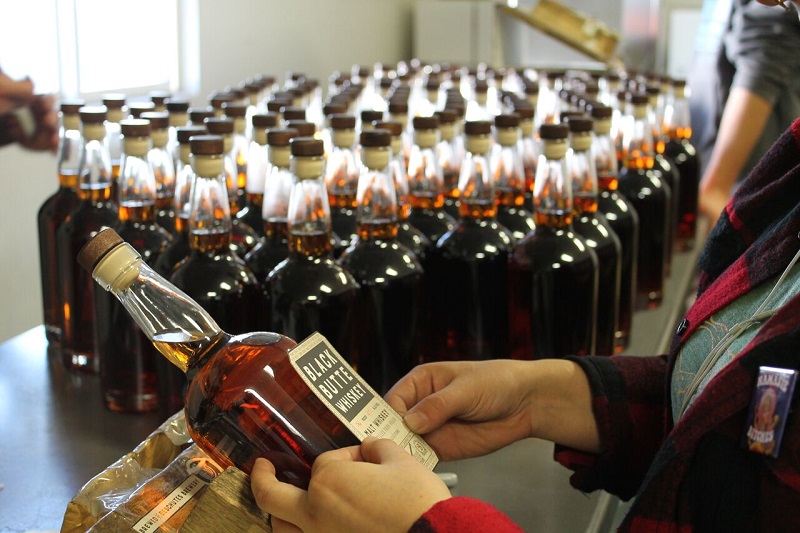
(Photo courtesy Deschutes Brewery)
New Holland recently rolled out a Beer Barrel Rye to expand from its Beer Barrel Bourbon, and Mulligan is currently aging Rua on barrels that previously held barrel-aged Fat Boy. Though the casks were originally going to be converted into furniture, Mulligan says the barrels “smelled so good there was no way I wasn’t putting whiskey in them.”
Bendistillery and Deschutes, in the meanwhile, are aging a collaboration Abyss whiskey, though on a timeline beer drinkers probably aren’t accustomed to.
“I can confidently tell you the Abyss will come out within the next 2-10 years,” says Dietrich with a laugh. “We’re making whiskey man, you don’t know when you’re going to get something until you get it.”
Bo McMillan is the former editorial assistant for All About Beer Magazine, and is currently pursuing his PhD in English and Comparative Literature at Columbia University.
The post Full Circle: Breweries and Distilleries Share Barrels appeared first on All About Beer.
]]>The post Six to Seek: The Best Beers of the Week appeared first on All About Beer.
]]>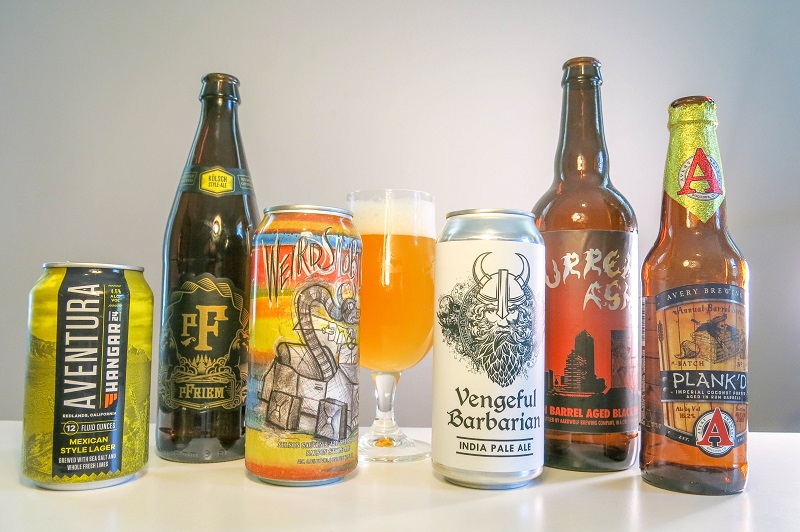
HANGAR 24 AVENTURA
Hangar 24 Craft Brewing
Redlands, California
4.6% | Mexican-Style Lager w/ Sea Salt & Limes
Used to be when you saw “Mexican lager” on a label, that meant the beer inside was likely fashioned after a Vienna lager, or a light lager brewed with corn. These days Mexican-style lagers are more popular than ever, though many brewers take liberty to include ingredients that also call to mind the culture or cuisine of Mexico. In the case of Hangar 24 Craft Brewing, that means salt from the Sea of Cortez and limes from San Diego. We’ve seen both salt and lime used in other examples of the style, and though they aren’t traditional (save for adding a lime to a bottle of Corona) they do seem to fit in with the feel of this admittedly broad and growing category of beers. Aventura is more in the pilsner vein, with a slightly sweet, biscuity malt character–no corn here. There is a light tartness on the palate from the limes and the salt comes through on the finish, but neither is so prominent that they take away from a very well-executed lager base.
PFRIEM KÖLSCH-STYLE ALE
pFriem Family Brewers
Hood River, Oregon
4.8% | Kölsch-Style Ale
pFriem goes out of its way to let you know this is not a Kölsch, but rather a Kölsch-style ale. Some may dismiss this as merely semantics, but it’s a sign of respect for the style and its birthplace of Cologne, Germany (many brewers are currently trying to find the appropriate words for their Lambic-like beers, too). While the brewery notes that it was not brewed in Cologne, you might think otherwise were you to sample this blind from a thin-walled stange. On the surface, it seems such a simplistic beer: sweet pilsner malt and noble hops that contribute notes of white grape, lemon and green apple peel, with an effervescent, light body. But this is one of those beers for which words fail. The beer has a fresh, balanced quality that few American attempts can match. If you have access to pFriem’s beers, you owe it to yourself to try it.
HOP BUTCHER WEIRDSMOBILE
Hop Butcher For The World w/ Cinderlands Beer Co.
Chicago, Illinois
6% | Saison-Style Ale w/ Southern Hemisphere Hops
This is a hazy saison dry-hopped with Nelson Sauvin and Vic Secret hops, and yet it’s not as strange as that description or the name itself might suggest. The yeast-driven notes you’d expect in a saison are masked by the hops, which contribute juicy lemon, lime and white wine notes. With the beer’s hazy appearance and minimal farmhouse flavors, this puts us more in the mind of a Southern Hemisphere approach to a New England IPA. While Citra, Mosaic, Amarillo and other hops are popular for good reason, this was a really interesting collaboration that has us hoping for more such beers, no matter how “weird.”
ALVARADO STREET VENGEFUL BARBARIAN
Alvarado Street Brewery
Monterey, California
7.2% | New England-Style IPA
We sampled several hazy IPAs from Alvarado Street Brewery this week, and Vengeful Barbarian came out on top. There are the fruity notes you expect of the style, namely grapefruit and tangerines, but where some New England-style IPAs veer too heavily into sweet and juicy, this one maintains a firm bitterness to keep things in balance. Subtle notes of melon rind and mint, along with an exceptionally refreshing finish, distinguish this one.
AARDWOLF SURRENDER ASH
Aardwolf Brewing Co.
Jacksonville, Florida
10% | Scotch-Barrel-Aged Black Barleywine
First, a disclaimer. If you don’t enjoy Scotch–and in particular the peated varieties of Islay–then turn around right now. But if the mention of Band-Aids and ash and smoke don’t deter you, then you’re in for a treat. The beer offers up the unmistakable sweet and earthy scent of peat-smoked malt. Upon taking the first sip, you’d be inclined to think the whisky has overwhelmed the black barleywine. But let it warm and linger in your mouth a bit, and you’ll find piney hops and a nuttiness from the malt. Peated Scotch isn’t for everyone–but if it’s for you, then this beer is, too.
AVERY PLANK’D
Avery Brewing Co.
Boulder, Colorado
16.2% | Rum-Barrel-Aged Imperial Coconut Porter
Forgive the pun, but it would have been easy for the brewery to go overboard here with the coconut and rum. But Avery, no stranger to big, barrel-aged beers, often finds its balance with ingredients like these simply by brewing an insurmountable monster of a beer. You get coconut on the aroma, but it’s behind a huge serving of rich fudge and pumpernickel. Coconut is on the palate as well, but not so much that it detracts from delectable notes of brownies, Tootsie Roll and, yes, rum. The barrel and the beer’s 16.2% ABV lend a touch of heat, as you’d expect, and Plank’d finishes creamy and viscous. Like other Avery beers, it’s remarkable how simultaneously bold and nuanced this beer is.
The post Six to Seek: The Best Beers of the Week appeared first on All About Beer.
]]>The post Putting an End to Insults and Infighting appeared first on All About Beer.
]]>
(Photo courtesy Shutterstock)
Words have consequences. Even if those words are as obtuse as “that’s not craft,” they can damage friendships, and that kind of thing is ripping up the American brewing industry. It’s time to consider the potential damage.
I remember a lot of nasty stuff being said about beer over my lifetime. In the early years of the 1980s, much of it centered on comparisons to some breed of animal piss and the inevitable question of, “How do you know what that tastes like?!”
Then small breweries started hitting the market, and mainstream beer drinkers taunted us for drinking “that microbrew shit” or “yuppie beer.” That was all just about being different from the herd, and the herd’s defensiveness. We were beer drinkers, but there was something not right about us.
But it was when the alternative beer market got big enough to divide against itself that things really got ugly. Contract brewing was the first big divide. If you weren’t making the beer yourself, it was no good. Brick-and-mortar brewers hung a lot out there, putting up the money and learning curve. But contract brewers jump-started the category, and they were helping to keep the older regional brewers open. I looked on that as an overall positive, but some folks loudly argued against them.
Closely related were the “fake beer companies.” That was originally leveled against the big brewers, who brewed beers “made” by new companies with different names. They were vilified as lying about their origins. The best-known survivor of that time: Blue Moon, a Coors product, but you’d never find “Coors” on the label at the time.
The practice trickled down to the newer brewers, and things got confused. In late 1994, Boston Beer developed a line called Oregon Ale & Beer, with a somewhat cloudy origin story, and the brewers of the Pacific Northwest were furious. This guy didn’t even have a brewery, and he was using their identity to sell his beer! The Oregon Brewers Guild and the Washington Small Brewers Association paid for an ad that proclaimed “Local Microbrewers Incensed at Imposter.” A lawsuit was brewing when more “pseudo-craft” beers released by Anheuser-Busch brought the small brewers to their senses. And no one seemed to recall that fanciful names like these had been a common practice in American brewing since before Prohibition.
When Blue Moon finally started selling big in the early 2000s, beer aficionados freaked out. They called it fake craft, “crafty” and worse. I just wanted them to try it in a blind tasting and see if they really hated it, or what it stood for. But argue the quality of the beer with a brewer, and it would inevitably come down to, “They’re taking the food out of my family’s mouths!” Really? More than other brewers, more than distillers?
Astonishingly, quality became divisive, notably at a 2014 speech delivered by Paul Gatza, director of the Brewers Association. “While the top end of quality continues to improve,” he said, “there are some cracks with new brewers.” That touched off an angry discussion of how sincere the BA was about supporting new, small brewers and whether this represented barrier-building on the part of established brewers.
Then there was the wave of buyouts in 2015-2017. Medium-sized, independent brewers across the country were bought by Anheuser-Busch InBev, by Constellation Brands, by Heineken. Consumers felt betrayed by formerly independent brewers and spurned the beers. Brewers boycotted events run by these brewers.
Was it related when the most ardent of consumers increasingly had no time for large, established alternative brewers? As I write this, Smuttynose is up for auction, Mendocino has closed its taproom, Speakeasy hangs on by a thread, and sales of Boston Beer are down, while there are lines at small breweries, where limited runs of beer sell out in a matter of hours. New breweries can do no wrong; old breweries are ignored.
I think it is related. People want to be different, just as we old-timers did when we stepped away from the Budweiser tap. People want new and fresh. But the market has become confusing. Breweries seem to open and close and change hands daily, ownership is nebulous, and the defense is hyperlocalism. When you walk in a small taproom tucked in the back of an industrial park, with rough furniture and a concrete floor, it’s a pretty sure thing you know who’s brewing the beer.
I’m not angry about that. I’m not actually angry about anything, for a change. I just want good beer, and honestly, I don’t care where it comes from. I like my small, local taproom. I like Sierra Nevada. I like beers from several of the “sellout” breweries.
What I don’t like is the nasty crap we’re slinging about brewers. Don’t like their beer? Then just say that and move on. Don’t insult them, and don’t insult me if we disagree. This is beer, not “death before dishonor”-level stuff. Have a couple, maybe try something old instead of something new. But leave the hate for politics.
Lew Bryson has been writing about beer for more than 25 years and is the author of Tasting Whiskey. On Twitter @LewBryson.
The post Putting an End to Insults and Infighting appeared first on All About Beer.
]]>The post Beer’s Place at the Table appeared first on All About Beer.
]]>Shortly after he arrived on the Hyde Park, New York, campus of the Culinary Institute of America in 2004, Jared Rouben noticed something. Aside from a half-day during the esteemed trade school’s wine curriculum—and any beer-related publication that might be found at the library—students received no instruction in beer or the role it played in the culinary world.
The dearth gave Rouben, then 22, an idea.
“If this was the top culinary school in the country,” recalls Rouben, “then we needed a resource to learn about beer.”
So he started the Culinary Institute of America Brew Club, an informal conclave that endures to this day. The group tasted beers and hosted presentations from representatives of breweries such as Magic Hat, Dogfish Head and Boston Beer. Perhaps most importantly, club members used beers from these and other breweries to cook and to bake.
“What started out as a club of about 25 quickly grew into like 150 or 200,” says Rouben, now the brewmaster at Chicago’s Moody Tongue Brewing Co. and a faculty member at the Siebel Institute. “It’s inquisitive minds—I think that with cooks and chefs, they want to learn how to create with their hands. Whether it’s a foie gras or a beef tenderloin or an IPA, you’re still building with your hands and creating something that satisfies the palate.”
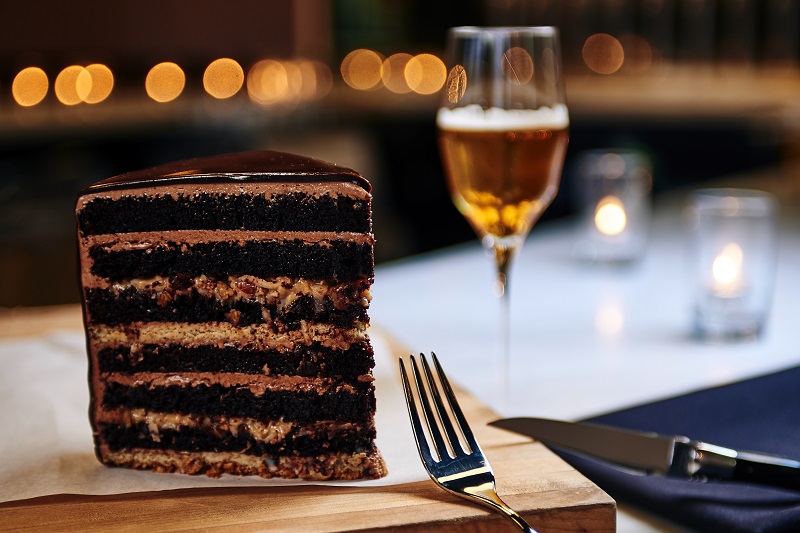
(Photo courtesy Moody Tongue Brewing Co.)
Rouben’s establishment of the Brew Club nearly 15 years ago would prove a prescient move. It was an early example of a gathering trend: The marriage of the culinary arts and fine dining with beer, including how to cook with it and to pair it with different dishes.
That trend can’t seem to shake a certain shadow, though, one that also looms from the culinary side: Some chefs and restaurateurs still see beer as an afterthought, meant more for the end of their shift than the front of the house.
“I would say that the angriest critiques I get from people about shows are when I’m drinking whatever convenient cold beer is available in a particular place, and not drinking the best beer out there,” Anthony Bourdain, the chef-turned-TV star, told an interviewer from the travel and entertainment newsletter Thrillist in 2016. “You know, I haven’t made the effort to walk down the street 10 blocks to the microbrewery where they’re making some fucking Mumford and Sons IPA.”
[Editor’s Note: Anthony Bourdain killed himself on June 8, 2018, while on location for his show in Strasbourg, France.]
Two years before, David Chang, best known for his Momofuku restaurants and award-winning but now defunct Lucky Peach magazine, wrote an essay for GQ in which he, like Bourdain, savaged not only beer beyond a certain species of light lager—Chang pronounced himself a Bud Light partisan—but fans of anything else.
“I have a tenuous relationship with the epicurean snob sets […] Beer snobs are the worst of the bunch.”
Such an animus is nothing new, but its persistence is surprising and maybe a little frustrating for the already converted.
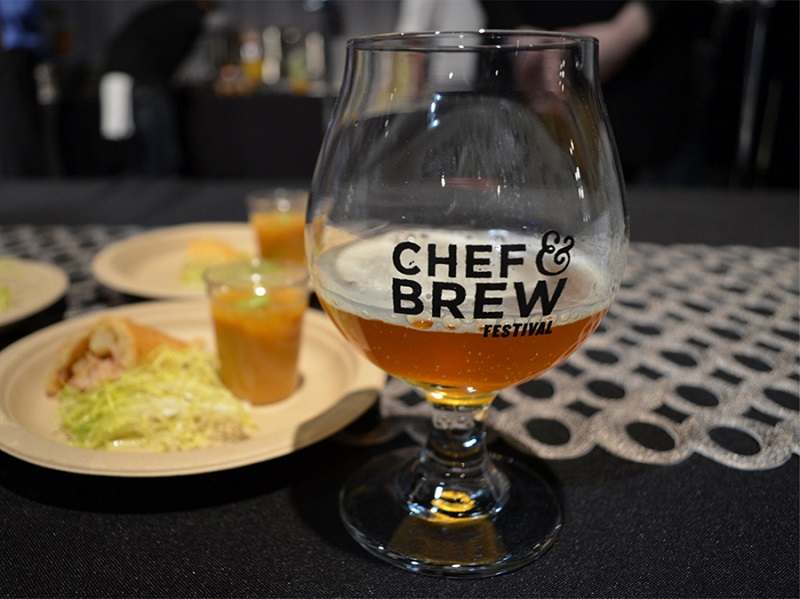
(Photo courtesy the Chef and Brew Festival)
Michael Long, a Culinary Institute of America-trained chef, sommelier and restaurateur, cofounded Chef & Brew festival in 2012 in Denver. The seventh annual one is scheduled for late August 2018, and will pair 23 brewers and 23 chefs to concoct dishes and pairings, and to compete for prizes. The fest grew from an epiphany in 2011.
“At that time,” Long says, “even though Denver was ground zero along with perhaps Portland for the craft beer movement, the perception at that time—and it still holds to a large extent outside of metropolitan areas—was that beer is for bar food. It goes with pizza and brats and soft pretzels and shepherd’s pie.”
Beer Culture and Cachet
On the week before Thanksgiving 35 years ago, the English critic Michael Jackson lamented “a snobbism” toward beer “which is particularly American.” Jackson didn’t mean that Americans looked down on beer. They didn’t look up to it, either—there were few commercial options then beyond Bud Light and similar ilk.
Instead, he meant that whatever vestiges of a beer culture that remained in the United States 50 years after Prohibition had largely petered out. In northern Europe, the Dutch, the English and others preferred beer because the climate was more conducive to grain production, Jackson wrote; in southern Europe, it was wine because of the grapes.
In the U.S., any such nuance had been lost—the Yanks drank uniformly thinner beers chilled to “American popsicle level” wherever they lived in the empire. Meanwhile, wine in the U.S. around the same time was flowering in ways unforeseen a generation before.
Seismic events such as the so-called Judgment of Paris, a 1976 blind tasting that saw California wines best ones from traditional leader France, and the opening of the nation’s initial wine bars (the first was in San Francisco in 1974) as well as the launch of publications such as Wine Spectator, Wine Advocate, Wine Enthusiast and Food & Wine throughout the late 1970s helped wine ascend to a level of perceived sophistication few consumer products had ever enjoyed.
That perception seeped into the culinary arts. Julia Child sipped wine on national television while prepping French dishes. Ronald Reagan retained the services of his Sacramento wine merchant from his days as California governor while entertaining in the White House. The old Four Seasons restaurant in Manhattan hosted a carefully catered dinner for the wine industry and its critics that would dictate many of the year’s trends.

Lucy Saunders
There was nothing like this for beer, no scrupulous pairings at famous restaurants—never mind the White House—no presence on television beside serious cuisine. Beer—bereft of culture and, some would say, taste a generation ago—didn’t stand a chance against this assault of oenophilia.
“I think there’s an undeniable cachet about wine and its packaging and its presentation at the table,” says Lucy Saunders, a writer who has been covering the intersection of beer and food since the late 1980s.
To satisfy demand for this cachet, culinary schools developed curricula covering the nuances of wine. Wine critics and other writers lectured on pairing for hospitality professionals and ordering for consumers—and some made serious money doing so. Robert Parker, a lawyer turned critic, would sell his Wine Advocate, developed on a shoestring out of his suburban Baltimore living room, for $10 million.
If beer was included in this training for chefs and other food professionals, as in the case of the Culinary Institute of America, it was usually included as an afterthought—at least early on. That would change as the number of U.S. breweries ballooned in the 1990s and 2000s, and the variety of styles, and iterations of styles, blossomed.
Coverage of beer and food increased, too, and training programs for the hospitality industry in general launched, including Siebel’s Doemens (in 2004) and Cicerone (in 2007). Also in 2007, the Brewers Association launched its annual SAVOR beer-and-food-pairing festival.
“It’s risen with the craft beer movement,” says Kevin Appleton, food and beverage program director at Wisconsin’s Madison College. “It’s been going on gradually for the last 20 years.”
The Tipping Point
The tipping point for beer and food, according to Saunders, seemed to arrive as the nation recovered from the Great Recession in the late 2000s. By the time consumers had more money to spend, the table had been set for beer and food, food with beer, etc., through a vast array of brewery and beer options and a flowering of expertise. The public was ready by around 2010, or at least readier than before.
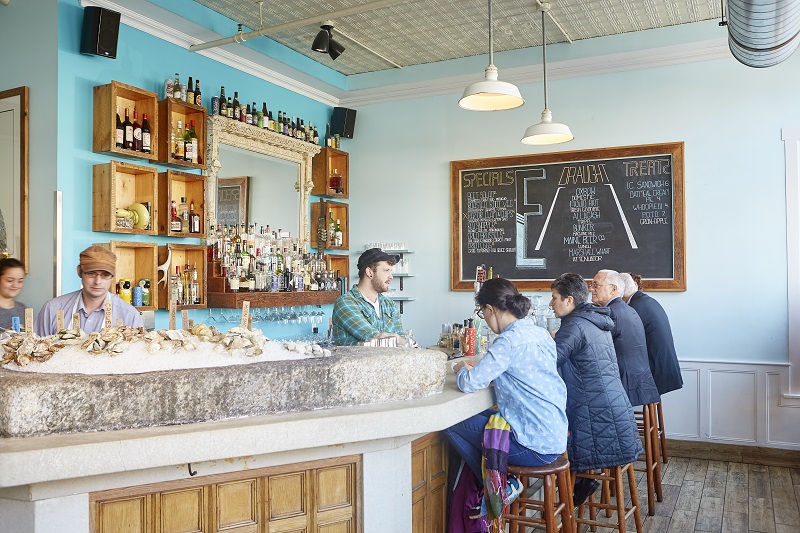
Eventide Oyster Co. in Portland, Maine. (Photo courtesy Big Tree Hospitality)
Arlin Smith is another early 2000s Culinary Institute of America graduate, who now co-owns Big Tree Hospitality, the company behind Portland, Maine, eateries such as Eventide Oyster Co. and Hugo’s. He has seen the changes firsthand in how the customers out front and the staff in back approach beer. It’s an afterthought no more.
“I feel like if someone’s going to spend $90 on a tasting menu,” says Smith, “they’re not going to feel that comfortable buying a $4 beer. They’re ready in that moment to experience something different that they didn’t just pick up at the gas station.”
And the holdouts, then? The Anthony Bourdains and the David Changs, who either don’t perceive the shift or do perceive it but don’t care?
“I don’t know, bad habits?” wonders Appleton.
That’s one theory: For some culinary maestros, beer might forever remain an icy-cold, only slightly bitter, invariably bland finish to a long shift in the kitchen.
Then there’s the generational theory. Beer in the U.S. was so long subject to what Michael Jackson described as that “snobbism which is particularly American” that those who grew up around that can’t see past it.
The key part of Chang’s 2014 GQ essay was probably when he wrote about “watching my grandfather mow the lawn on a 90-degree day in Virginia, and, as soon as he finished, he’d ask me to fetch him a can of ice-cold beer. He’d tell me, ‘One day, you’ll understand what it’s like to drink a really cold beer when you’ve earned it.’”
“You can’t undo those kinds of experiences,” says Saunders.
Finally, there is the infancy theory. If the tipping point was the end of the Great Recession a little under 10 years ago, then the prominence of beer in the culinary arts and in fine dining is still a relatively new phenomenon.
Various programs and places turned out sommeliers since at least the 1950s, well before the position gained new stature with the rise of American wine in the late 1970s. Smaller, more esoteric restaurants such as Alice Waters’ Chez Panisse in Berkeley, California, had paired wine and food for years before Food & Wine magazine launched in 1978.
These things take time. Haters aside, beer’s place at the table looks only to grow more conspicuous.
“I think brewers and chefs are more similar than ever,” Rouben says, “and what’s wonderful now that I didn’t see back in 2004 is the communication—brewers working with chefs, and vice versa. I think that now more than ever we’ve broken down the wall between the kitchen and the brewery and just really started to focus more on the flavor, taste and aromatics.”
Tom Acitelli is the author of The Audacity of Hops: The History of America’s Craft Beer Revolution and a longtime contributor to All About Beer Magazine. Reach him at [email protected].
The post Beer’s Place at the Table appeared first on All About Beer.
]]>The post Beyond Barley: Embracing Alternative Grains appeared first on All About Beer.
]]>Whenever the name of a widely distributed American adjunct lager lingers pejoratively on the tongue, a prevailing wisdom tends to lay the blame of any perceived “cheap” or “poor” tastes on adjuncts like corn and rice. The Brewers Association, a trade association that works to define and advocate for craft beer, once excluded brewers who used them from its coterie.
That changed in 2014.
“As time went on, from the definition being in place, I think there came a heightened sensitivity to the fact that things aren’t so black and white,” says Julia Herz, the craft beer program director at the Brewers Association.
To define adjuncts: In all cases, they are unmalted sources of fermentable sugars and can include grains, honey, fruits, agave nectar and more. So, yes, barley can be an adjunct, while rye usually isn’t (it’s most frequently used in the form of rye malt).
Some of the ideas about them are true: Adjuncts can make beer cheaper to produce, and even the early brewers who embraced them drew a flavor line. But adjuncts have been a distinct characteristic of American beer since the industrial age because they made beer better.
“I think there’s a lot of name and quality and emotion wrapped up in the use of adjuncts,” says Aaron MacLeod, who has studied brewing grains as director of the Hartwick College Center for Craft Food and Beverage in Oneonta, New York. “I think that the U.S. has a long and proud history of adjunct brewing, especially with corn and rice.”
It’s a statement with which Herz agrees, and part of the reason adjuncts now comply with the “traditional” totem of the Brewers Association’s definition.
“Adjuncts played a huge role in the history of beer styles in the United States,” she says.
The following sections explain how some of the most common adjunct grains emerged and provide a little information as to what they add to—rather than detract from—beer.
Corn
“In North American brewing, if we look at the history up to craft brewing, the major adjuncts were corn and rice,” says Paul Schwarz, a professor at North Dakota State University who studies malt and cereal grains. In the Americas, corn’s ubiquity and high starch content made it an easy choice for brewers looking to lighten up lagers made with high-protein (and limited) barley. Even some Colonial brewers turned to corn to make beer, according to Schwarz.

(File Photo)
Anton Schwarz, a Czech-born brewery consultant and manager (of no relation to the above-mentioned professor), began advocating for the use of corn in industrial brewing in the 1860s and was highly influential in its current relationship to brewing. In 1868 he immigrated to the United States, where he opened Schwarz Laboratories for research and training and edited The American Brewer.
Appropriately, it was Schwarz who recommended brewmaster J.F. Theurer to Pabst—Theurer was behind Pabst’s famous exposition-winning (and corn-including) beer in 1893.
“In theory, the starch in corn is similar to the starch in barley. So in theory you could make a beer with malt and corn that has a similar carbohydrate profile to a beer made with 100 percent malt,” says Schwarz, the North Dakota State professor.
Corn appears in classic American adjunct lagers such as Yuengling’s signature beer (now considered craft by the Brewers Association), as well as in newer-wave beers like Fullsteam Brewery’s El Toro cream ale and 3 Floyds Brewing Co.’s Corn King IPA. Corn lightens body and color while maintaining alcohol content and can be used in brewing in the form of grits, flakes or syrups.
Anthony Accardi, brewer at New York City’s Transmitter Brewing, uses corn for a cheeky twist on a farmhouse ale in his brewery’s F6.
“Basically [it’s] in some ways mimicking High Life as a reference point,” Accardi says. “We’re adding some Brettanomyces to it that would give it some funkiness or earthiness that would never be appropriate to an American light lager.”
Rice
As an adjunct, rice was used frequently among brewers in industrial America. Due to rice’s limited availability and its fussiness, however, corn overtook it in large measure toward the close of the 19th century.
Rice, like corn, is low in fats and protein and high in starch, making for beer that is lighter in color, flavor and body. But while most corn is fairly easily converted into fermentable product by the extra enzymatic activity of barley, rice needs a little something extra (higher cooking temperatures, extra bacterial enzymes) to be added into beer.
For one of the most classic beers made with rice, look no further than Anheuser-Busch InBev’s famed Budweiser. Like corn, rice’s utility is also being rediscovered among smaller producers. For instance, Melvin Brewing Co. and Monkey Paw Brewing Co. partnered for a double IPA called “This One Goes to 11,” brewed with sticky rice and Minute Rice, as a gibe at big beer.
At Transmitter, Accardi works with rice as part of a wider effort “to use all the colors on the palette” when it comes to brewing with grain. “To me there aren’t rules to what a beer should be or shouldn’t be,” he says.
Transmitter’s S8 saison uses rice to keep the beer’s body and color light and refreshing, with the rice providing a gentle canvas for the spicy saison strain and German aromatic hops in the ale.
“Some people feel like they taste a little bit of sake-ness to it. … I’m not sure that I ever perceived that,” says Accardi.
Stillwater Artisanal has also used rice to make its Extra Dry saison (though that brewery’s beer is meant to call to mind sake), and Bayou Teche Brewery uses rice to keep its snappy Ragin’ Cajuns Kölsch light and fluffy.
Wheat
Wheat’s high protein content—and also the soluble nitrogen found in wheat flour—has made it a go-to choice for brewers looking for greater head retention. Unmalted wheat helps constitute lambics and witbiers, and provides a more pronounced cloudiness and raw, grainy taste over malted wheat. That cloudiness is one reason flour has occasionally been used in making New England-style IPAs like Tired Hands Brewing Co.’s Milkshake., a collaboration with Omnipollo.
Wheat didn’t initially take off in American brewing, professor Schwarz says, because it was too valuable of a food crop to justify turning it into beer. Now, though, brewers are going beyond standard wheat to heirloom varieties like spelt to add a new level of rusticity and complexity to their beverages.
Let’s be clear: German hefeweizen and Berliner weisse beers predominantly use malted wheat, not adjuncts. But in the cases of beers like Blue Moon or Lindemans Cuveé René, unmalted wheat helps produce the fluffy head and bready taste.
Oats
Some papers suggest the use of oats in European brewing was fairly present until the Reinheitsgebot (the German beer purity law). It would make sense given the context of how other adjuncts emerged: Oats are a hardy crop that grow well in the cold and wet climes of countries like Finland, Germany and the United Kingdom.
The most common style of beer to which Schwarz has traced the use of oats would be the British oatmeal stout, where he has found references dating back to the 1800s. A distinctly smooth and creamy style, the beer has a distinguished mouthfeel that comes from oats’ high levels of a non-fermentable fiber called beta-glucan, Schwarz says. Beta-glucan not only produces viscosity in beer, it also happens to be the thing that Cheerios advertises as heart-healthy.
The oats in Terrapin Beer Co.’s Rise-n-Shine coffee oatmeal stout, which is aged in Tennessee whiskey barrels, serves as an example of how oats can give what might otherwise be a syrupy beer a lighter texture similar to aerated cream. Oats also serve as a base to the beer’s intense nose and flavor profile, laying down an oatmeal-like canvas to bind together notes of bittersweet chocolate, dark fruit and warming booze.
Recommended usage levels of oats are low in beer. One 1943 research paper argues that around 10 percent in the mash is adequate, and only with “good malt.” And Randy Mosher, a columnist for this magazine and author of books such as The Brewer’s Companion and Radical Brewing, has suggested in his writing oat usage of somewhere between 5 and 10 percent.
Accardi says he adds oats to beers like his G2 Belgian pale ale if “we want to give it a little extra something in terms of how it feels.”
“We try to consider all the aesthetic angles,” he continues. “We’re still using mostly barley, ’cause that’s what
beer is.”
 Buckwheat, The Pseudo-Grain
Buckwheat, The Pseudo-Grain
Though occasionally mentioned in the same breath as spelt, emmer and durum, one ingredient showing up in beer recently, buckwheat , isn’t actually a grain at all.
“It could be considered a pseudocereal,” said Prof. Paul Schwarz of North Dakota State University. Cereal grains come from grasses; buckwheat does not. However, buckwheat does call to mind a profile similar to rustic wheat in beer, and can be malted or used as an adjunct.
“Buckwheat is really beautiful […] with an earthiness and nuttiness that are not really found in the same way in much else,” said Brian Buckman, co-founder and head brewer of Illuminated Brew Works in Chicago, Illinois, whose 2016 Pareidolia Belgian Pale Ale incorporates unmalted buckwheat, Asian pears and amchur (dried mango powder).
Buckman described buckwheat as “a very big, bold flavor,” and bold it is indeed (it’s also the reason Buckman uses pears in Pareidolia as a balance). Close your eyes while drinking Pareidolia, and it’s easy to imagine a freshly cut hunk of whole-grain levain bread in place of your beer glass.
What About Rye?
Rye use dates roughly back to medieval times, appearing in German roggenbiers and assorted Scandinavian fermented beverages. But given that most rye used in beer is malted, rye is not usually an adjunct.
The usage of rye in Europe fell out of favor around the start of the 20th century, said Paul Schwarz, because rye is notoriously difficult to work with. It has a similar high protein content to wheat, which increases the difficulty of sparging, and also contains high levels of pentosan, a complex carbohydrate that makes rye wort “thick and sticky.”
U.S. brewers are re-embracing the grain for its distinct spiciness, adding it to beers from stouts to saisons and IPAs for balance and complexity.
Anthony Accardi, of New York’s Transmitter Brewing, adds rye to his NY1 Danko Rye saison for “a little edge.”
“In terms of layering the spice from the grain and the yeast choice, and then maybe picking a hop that has a peppery finish to it […] you’re blending distinct but various layers of a certain flavor,” he says.
Bo McMillan is the former editorial assistant for All About Beer Magazine, and is currently pursuing his PhD in English and Comparative Literature at Columbia University.
Beers Brewed With Rice
The post Beyond Barley: Embracing Alternative Grains appeared first on All About Beer.
]]>The post Trending: A Bevy of Berry Beers appeared first on All About Beer.
]]>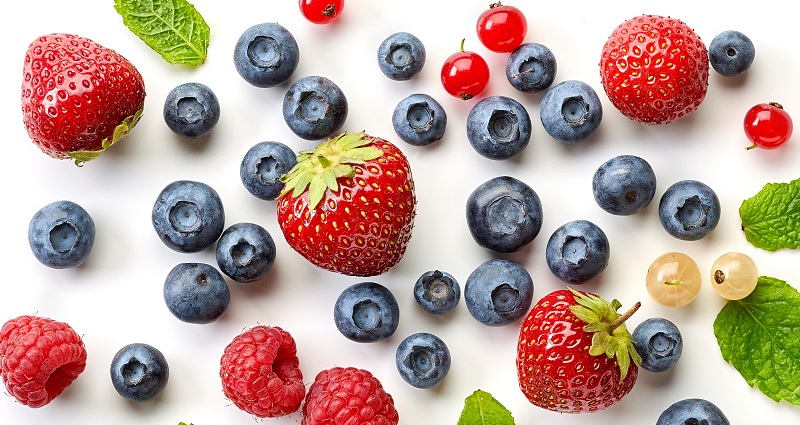
(File Photo)
While nothing we’ve covered in this Trending column to date can quite match the degree to which hazy IPA has taken off, we are quickly approaching peak berry beer.
The larger recent rosé trends in the beverage industry—rosé cider, rosé vodka, rosé gin, rosé hard seltzer, rosé pretty much everything—are ramping up to a fever pitch. Nielsen reported a 53% year-to-year increase in U.S. rosé sales near mid-2017, while a January 2018 trend report included the section “Rosé All Day,” noting: “While consumers purchase this varietal throughout the year, sales in U.S. off-premise channels highly skew to summer months and peaked during the week of Independence Day in 2017.”
This summer’s going to be super pink.
BEER OF THE MOMENT: OMMEGANG SAISON ROSÉ
The rosé trend, of course, accounts only for an unknowable portion of these new berry-beer launches, and the overall rise in kettle-souring techniques for making sour beer more quickly certainly figures in as well (berry additions being a good way of tempering the lactic tartness). But, should you happen to see a rosé reference on that new berry beer, don’t be surprised.
A few of these examples seemed to go very purposefully for a rosé-like profile, offering that refreshing combo of berries and subtle tannins, while others tended to go one of two hugely divergent directions: toward basic reassuring fruity sweetness or enamel-ending lactic acidity. I’m iffy on sweet beers, but these days I’ll take them over door #2. The mixed-fermentation examples tend to offer a more immersive experience, as do the examples that employ whole fruit. Expect price points to go up for both. Maybe sample them with a rosé-flavored rosé?
More Noteworthy Choices: Dogfish Head’s recent berried releases include their survivalist-minded It’s The End of the Wort As We Know It (adding blueberries, acai and goji berries) along with their Flaming Lips collab Dragons & YumYums (featuring yumberries). Creature Comforts Brewing Co. re-released Athena Paradiso with raspberries and cranberries. Magic Hat Brewing Co. brought back Elder Betty, a wheat ale with elderberries plus Apollo hops, which will be available through August. And Pelican Brewing Co. announced Berried at Sea – Tsunami Stout, with currants and blackberries: its first release in a new line of fruit beers.
Highly Recommended
ALMANAC FOUDRE PUNCH
Almanac Beer Co.
San Jose, California
7.2% | Oak-Foudre-Aged Sour Blonde Ale w/ Raspberries, Blueberries & Cherries
For rosé replacements, this new release from Almanac nails the core profile, with its sour elements adding on a bright lemony edge. Light oak tannins with mixed berries. A vibrant core effervescence. While there’s a bit of extra heft in the mouthfeel from the 7.2% ABV, this stays nimble, refreshing. ‘Punch’-wise, this seems primed for a larger-format package.
CELLADOR VERMILLION
Cellador Ales
Los Angeles, California
7.4% | Blended Wild Ale w/ Raspberries
Cellador opened in southern California a few years ago, focused on fermenting in oak. This release of Vermillion is a blend of saisons aged on whole raspberries, and its complex berry profile pushes this beer into superlative turf. A fruit intensity like New Glarus’ best, but with nuanced, serious acidity and lambic-like tendencies courtesy of those well-aged saisons.
Recommended
CROOKED STAVE SOUR ROSÉ
Crooked Stave Artisan Beer Project
Denver, Colorado
4.5% | Oak-Foeder-Aged Sour Ale w/ Second-Use Raspberries & Blueberries
Crooked Stave’s fermentation characteristics, particularly the Brett aspects, tend to be a bit funky for me, and there’s definitely some sulfur and a hint of pencil rubber here. But those are tertiary notes in an otherwise engaging, complex tart-rosé take. Like the Almanac, there are welcome tannins adding to the wine feel.
UPLAND RASPBERRY
Upland Brewing Co.
Bloomington, Indiana
6% | Oak-Barrel-Aged Sour Ale w/ Whole Raspberries
The Upland sours I’ve tried recently tend to be generous in their fruit character and special additions, if a bit overly puckering. Here, a particularly immaculate show of raspberry builds beside vibrant tart lemons impatient to take over. Great ruby color.
UPLAND TRIO
Upland Brewing Co.
Bloomington, Indiana
6.7% | Barrel-Aged Sour Ale w/ Strawberries, Blackberries & Honey
Where Upland’s Raspberry was berry-centric without a doubt, Trio emphasizes its lambic-style base (a beer called Basis), while its combo of special ingredients seem like tart guava. The strawberry addition is well presented, the honey landing on the floral side.
WEYERBACHER BERRY MONKS
Weyerbacher Brewing Co.
Easton, Pennsylvania
9.3% | Belgian-Style Tripel w/ Cranberries, Orange Peel & Ginger
I like this twist on Weyerbacher’s core Merry Monks more than I recall enjoying the original, though I’d be curious to try them side by side. The cranberry addition is quiet and integrated well, contributing a bit of lift, and the serious tripel components never get overshadowed.
Also Tasted
TWO BROTHERS IN THE DARK
Two Brothers Brewing Co.
Warrenville, Illinois
4.2% | Dark Sour Ale w/ Blackberries
Nicely rendered roast and milk chocolate, but it’s hard to get past the sharp sourness here.
RHINEGEIST PRESS TART
Rhinegeist Brewery
Cincinnati, Ohio
4.4% | Berliner-Style Weisse w/ Marionberries & Blueberries
A lot of nuanced berry character. As with Two Brothers, hard to dig in without puckering.
INDEED STRAWBERRY FIELDS
Indeed Brewing Co.
Minneapolis, Minnesota
5.7% | Sour Ale w/ Strawberry Concentrate
Heavy on the strawberry-jam side of the spectrum, with some lactic tartness around the edges. Lacking structure but generous with the berries.
BOULEVARD JAM BAND
Boulevard Brewing Co.
Cold Spring, Minnesota
5.9% | Ale w/ Blueberry, Raspberry & Cherry
True to its name and similar to Indeed on the jam. There’s a berry tartness here that lands as cranberry first, steering a sweet-tart cocktail that feels overly candied.
PYRAMID OUTBURST BERRY TART IPA
Pyramid Brewing Co.
Seattle, Washington & Portland, Oregon
6.5% | IPA w/ Hibiscus, Cranberry & Black Currant
Not much berry. Not much tart. Not much IPA. More engaging than the super-tart options.
SOUTHERN TIER BLUEBERRY TART
Southern Tier Brewing Co.
Lakewood, New York
8.5% | Imperial Sour Wheat Ale w/ Blueberry Purée & Natural Blueberry Flavor
Along the lines of the Pyramid: not overly assertive; not particularly tart. Blueberry syrup and fruit cocktail. The ABV’s surprisingly tucked away.
More Recommended Berry Beers
From our All About Beer review archives.
Highly Recommended
Lindemans Strawberry Lambic
4.2% | Lambic w/ Strawberries
Jester King Spon – Raspberry and Cherry
5.6% | Spontaneously Fermented Ale w/ Raspberry & Cherry
Odell Friek
6.9% | Blend of Raspberry & Cherry Sour Ales
Side Project Jammy
8% | Oak-Barrel-Aged Farmhouse Ale w/ Blackberries
Recommended
DESTIHL Blueberry Gose
5.2% | Leipzig-Style Gose w/ Blueberries
Odell Ten Paces Huckleberry Wild Ale
6.5% | American Wild Ale w/ Huckleberries
The post Trending: A Bevy of Berry Beers appeared first on All About Beer.
]]>The post How to Pair Beer and Cheese appeared first on All About Beer.
]]>
(File Photo)
Learning about beer and food can be a ton of fun. Any beer pairing dinner will feature lively interactions carefully put together to show off the best in the beer, and if you’re paying attention, you may pick up on a few general principles and a few hints and tips.
But what if you want to make a serious study of it? Most dishes have several ingredients working together in particular ways. It’s a little overwhelming trying to untangle it all in the context of a beer and derive some general principles from it. That’s why I suggest you start with cheese.
Cheese is profoundly complex, but when it’s in front of you, it’s just one thing. It’s much less bewildering than a main dish, or appetizer. Cheese shows clearly how beer and food can interact, and it’s easy because every beer and cheese has a multitude of perfect pairing partners.
So what are the goals for a great beer and food pair? First, I guess you’d say, “Do no harm,” which means both partners should play nicely and not stomp all over the other one. This is usually stated as trying to match intensities, or at least avoid a collision of one big, bold partner with a much more delicate one. It’s pretty basic. You just have to consider everything in the beer from the alcohol and the bubbles to potentially intense elements like bitter hops and roasted malt. The same summation needs to be made of the food elements. In cheese, we’re talking about things like fattiness, salt and pungency.
The real goal is to achieve what the Brazilians call harmonizacão, or harmonization, meaning a real relationship where each partner changes in interesting ways and often creates a third set of sensations springing synergistically from the food and the beer. Aroma sets the stage. Similar aromas, when they can be found, tie the pair together. Beer often has caramelly notes. Cheese, especially aged varieties (think 18-month gouda), also can be a bit caramelly, so there’s a link. Hops have herbaceous aromas that can resonate with the herbal notes in blue cheese. And of course we can look to cuisine for things that are harmonious without being similar: roast and meat; bread and butter; fruit and cream; and so on. Once you start paying attention to these, you’ll find plenty to work with.
Finally, there are the tastes on the tongue as well as mouthfeel. There are fewer tastes than aromas, but they need to be balanced carefully. Cheese has some acidity and umami, varying degrees of saltiness and usually plenty of fat. We’re fortunate to be working with beer, as it has qualities that are ideal for dealing with those rich, palate-clinging tastes. First, carbonation physically scrubs all that stuff out of your mouth, leaving you ready for more. Bitterness cuts through fat, so it can be helpful with rich cheeses, especially when they’re robust enough to tolerate the intensity of hops. Alcohol is a pretty good fat solvent, and so a high-alcohol beer can work great with a high-fat cheese like triple-crème. Beer is acidic, sometimes intensely so, and that can also help cut through fat. The rich proteiny taste of umami is something people just want to linger on and savor. It turns out that amber and brown beers, if they’re not too roasty, enhance the experience of umami, which is one reason brown beers are generally pretty good food beers. Salt can be a wild card. It’s very friendly to toasty and roasty and can minimize bitterness, but sometimes can be one flavor too many, especially when sweetness and bitterness are already in the pairing.
Usually if you find one combination that works, you can scale it up and down and find that the core concept holds together. If blue cheese and IPA works, then stilton (a very strong aged blue) and barley wine will also, and on the other end of the scale, so should blue brie with a hoppy pils.
People always ask: “Should I eat the cheese first or drink the beer?” After the first taste, it obviously doesn’t matter. I’m a beer guy, so I say taste the beer, but I probably would feel differently if I were a cheese maker.
Cheese varies widely in its character and depth of flavor, and actually parallels craft beer in terms of its artfulness. A regular grocery might have little in the way of artisan cheese, so you are better off shopping at a specialty shop or gourmet market that has people behind the cheese counter. In my experience these folks really enjoy beer and have great suggestions and insights. I rely on them frequently.
It’s also helpful to learn your way around the cheese landscape. Cows, sheep and goats each make very different milks, and each impacts the cheese in different ways. In production, cultures, natural or otherwise, may ferment the milk, changing and adding flavor. The middle of the process is all about water removal, which obviously affects the texture, but also how hard the cheese will be, how long it will age and how intense its flavors are. Different aging techniques affect the final cheese, as do secondary treatments like the injection of penicillium fungus that adds its delicious moldiness to blue cheese.
Putting together a small-scale cheese and beer tasting is among the simplest gourmet adventures you can have. Pick half a dozen cheeses, trying to mix things up: get at least one goat and one sheep; try to have some soft and some hard, one blue, one washed rind (the stinky type that comes in many degrees of stinkiness), one aged. Now that you have cheese in your basket, try to visualize the flavors and imagine which beers might pair well with them. Medium-intensity beers are usually good bets with cheese. As I mentioned, don’t be afraid to ask for help from the folks at the cheese counter. And just below, I’ll detail a few pairings I think generally work.
Harder cheeses are best pre-cut. I like to cut each cheese differently to make them easy to tell apart. Harder cheeses need smaller pieces as they’re more intense, but I like these to have a lot of surface area, so very thin tapered slices or irregular matchsticks; some softer cheeses can be just served with a knife or spreader as they glue themselves back together after cutting. For just a little taste, 1/4 ounce (7 grams) is adequate; half ounce per cheese is fine. If people are really eating, a little more. Bread is optional. For educational purposes I find it gets in the way, but for more casual tastings, it makes the whole thing feel more like food.
So here are a few pairings I always have a great time with:
1. Hefeweizen with fresh mozzarella. It seems strange until it’s in your mouth, where the milky creaminess of the cheese encounters the fruity, almost peachy aromatics imparted by the yeast, plus a twist of spice on top. Really makes you think of peach ice cream.
2. Amber to brown ale or lager with a washed-rind cheese. Recognizable by their orangish rind and gooey interior, these cheeses also offer varying degrees of cheesy funk. Despite their aromatic intensity, the inside of the cheese (experts call it “paste”) is very mild, so the beer can’t be too bitter or roasty. Done right, you get a “liquid-grilled-cheese-sandwich-in-your-mouth” effect. If you’re frightened by funk, ask your cheese merchant for a milder one.
3. Blue cheese and IPA. We normally don’t think about the mold of blue cheese having an herby quality, but when you put it with hops, it just explodes. Also, the cheese is pretty fatty, and the bitterness just blasts it away, while at the same time the cheese reduces the perception of bitterness.
4. Triple-crème bloomy-rind with doppelbock or Scotch ale. Played against this rich, salty-buttery cheese, the dark malts and beer’s sweetness creates a sort of chocolatey/caramelly cheesecake effect. If you want an alternative for a very different kind of pairing, a Belgian strong golden or tripel works great.
5. Three-year gouda with imperial stout. This super-aged cheese is caramel in color as well as flavor, with a lot of meaty and buttery notes. Pair it with a big, dark beer and you put meaty, roasty, caramelly and salty together. If you think about a cheeseburger, it’s all there but the pickles.
Getting to know beer and cheese is an ongoing process, but a very fun, rewarding and social one. In addition, it will help you grasp the basics so you can move on to more complex dishes. I urge you to get out there and explore this fascinating combination, slice by slice.
Randy Mosher is the author of Tasting Beer and is a senior instructor at the Siebel Institute.
The post How to Pair Beer and Cheese appeared first on All About Beer.
]]>The post Exploring Ohio’s Beer and Doughnut Trail appeared first on All About Beer.
]]>While I’ll travel something fierce to experience the best or most beautiful, most remote or most weird breweries, it’s less reported that I’m also a sucker for doughnuts. I profiled a veteran doughnut baker before I ever interviewed a brewer. I just produced the fourth Baker’s Dozen Festival in Portland, Oregon, which juxtaposed coffee-infused beers from 13 breweries with gluttonous bites from 13 of the area’s best doughnut shops.
So when I found out that Ohio is home to a bona fide Donut Trail (I only use that truncated spelling when it’s in a proper name)—and not in one its metropolises like Cleveland, Columbus, or Toledo, but sandwiched in Butler County between Cincinnati and Dayton—I had to tackle it.
Drinking on Ohio’s Butler County Donut Trail
Conceived of by the Butler County Visitors Bureau as a tourism draw to an area road-trippers might otherwise circumvent via I-75, said bureau sponsored my conquering of the 11-shop Donut Trail from my nightly pillows to pillowy balls of dough.
I allotted two mornings to inhale all those frosted, filled and fried morsels, then two afternoons all aglazed visiting Butler County breweries.
The symbiotic relationship between beer and doughnuts is found throughout Ohio. At Municipal Brew Works (20 High St.) in Hamilton—conveniently located across the street from my accommodations at the Courtyard Hamilton Hotel—The Dapper Doughnut is just one of many food trucks often parked outside. Because the brewery’s home is a 1935 municipal building that previously housed the fire and police stations (replete with a county jail that’d make for a unique tasting bar), vending fresh, hot mini doughnuts is a natural. While True West Coffee Porter is the natural complementary beer, I found that mixing it with the Orange Agave Blonde Ale nicely mimics the flavors of a café Borgia (think mocha with orange zest).

(Photo by Brian Yaeger)
Not all of the breweries correlate to doughnuts. At FigLeaf Brewing Co. (3387 Cincinnati Dayton Road) in Middletown, the four-vessel brewery with a taproom off the interstate between Dayton and Cincy offers light-bodied quaffables such as Basmati Cream Ale with a pleasant floral aroma and dual 7.2% IPAs (ISO-Trope and ISO-Hazy) for those who prefer their IPAs new-school cloudy or old-school clear.
Four miles away, Rivertown Brewery and Barrel House (6550 Hamilton Lebanon Road) is a larger production brewery distributing to seven states—but the on-premise brewpub is a destination for serious drinkers and fun-loving families with arcade games strewn about. The food menu is heavy on smoked meats (even the deviled eggs are brilliantly topped with Russian imperial stout-infused burnt ends) while the beer list ranges from plenty of lighter options (3984 Lager and Divergent Berliner Weisse) to West Coast and New England IPAs to some culinary experiments like a black gose brewed with black sea salt, black malts, and blackberries. Meanwhile, a 15-minute drive south into West Chester, DogBerry Brewing (9964 Crescent Park Drive) brews on a one-barrel system to keep the tap list long and diverse. The English-inspired Hook’ed Leg ESB is not cask conditioned but is served on nitro for a tasty and smooth pint, the Czech Pilsner is exceptionally clean, and there’s a place for smoked malts, hibiscus flowers and more among the 19 taps.
Meanwhile, last year in Cleveland a spot called Brewnuts (6501 Detroit Ave.) opened up. The whole concept here is chowing down on doughnuts—all made in house using local craft beer—and sipping locavore beers. The maple bacon doughnut with North High Brewing’s Tree Tapper maple brown ale from Columbus is a natural. Incidentally, Cleveland’s also home to one of three markets to host a new annual event called DonutFest (and I love that one of the participating Ohio bakeries is called Holey Toledough).
Eating on Ohio’s Butler County Donut Trail
Inevitably, once you’ve successfully had your Donut Trail passport completely stamped, someone asks, “What’s your favorite?” Forced to pick, it’s Holtman’s Donuts (9558 Civic Centre Blvd., West Chester). The shop is now run by founder Charles Holtman’s grandson Dan, and has three other locations in Southwest Ohio. I didn’t get to try the “beer doughnut” they collaborated on with Cincy’s Fifty West Brewing Co. but among their 30 daily varieties (sometimes twice as many on weekends), the maple bacon rounds are better than your prior favorite of this sort. Yet the Buckeye, three inches tall and chocolate glazed with a decadent peanut butter mousse center, is the way to go.

Holtman’s Donuts (Photo by Brian Yaeger)
Stan the Donut Man (7967 Cincinnati Dayton Road) is the West Chester strip-mall based bakery offering a long display case of glazed treats. Some are colorful, some are chocolaty—but all are priced around a buck each. I opted for the cinnamon bowtie with a thin ribbon of sugary spice inside the fluffy yeast doughnut. At The Donut House (8268 Princeton Glendale Road), a new shop tauntingly located across the road from a Dunkin Donuts, the stars here are the ones you “fill” yourself: choose classic glazed or chocolate- or maple-glazed long johns and select from several fruit or cream fillings. I went crazy and got blueberry and vanilla cream for the win. At the 40-year-old Donut Spot (5148 Pleasant Ave. in Fairfield), where doughnut-themed art hangs on the walls, the Homer Simpson-style pink, sprinkled doughnuts are a customer fave. My final stop on the first day was Jupiter Coffee & Donuts (5353 Dixie Hwy # 5, Fairfield) which nails the arty coffee house vibe. The “Red Storm” is a strawberry glaze swirled cinnamon roll, itself a big leap from the strawberry shortcake doughnut with a pompadour of strawberry fluff.
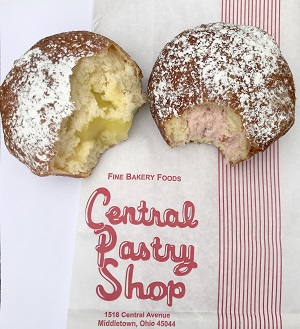
(Photo by Brian Yaeger)
Early the next morning, I walked into Mimi’s Donuts & Bakery (2267 Millville Ave., Hamilton) and sunk my teeth into the Reese’s, which, mercifully, is available as a mini since the peanut butter custard filling goes a long way. At Kelly’s Bakery (1335 Main St., Hamilton), the Kellybread—it and the bakery named after the founder’s daughter—is designed like a pull-apart in bar form. The cinnamon drizzle seals the deal. There’s no Ross at Ross Bakery (4421 Hamilton Cleves Road, Hamilton), so named because it was originally located in the town of Ross 10 miles south as the cronut flies. The old world klunker could be an antecedent to a buttermilk bar in its more amorphous embodiment. Nor is there a Martin at Martin’s Donuts (4 W. State St.), but the new owner kept the name and most of the offerings. There’s a banana-cream-filled doughnut with crushed vanilla wafers, but you have to get there earlier than I did because it was sold out. The cream-filled and crushed-Oreo-topped one floated my boat, er, sprinkled my doughnut. Central Pastry (1518 Central Ave., Middletown) is a full-service bakery. I fortuitously arrived at the end of pączki season (which is to say Lent). These Polish pockets (pronounced like poonch-key) are more or less jelly doughnuts. Before leaving Middletown, I closed out the trail at Milton’s Donuts, an institution that has used the same recipe and equipment since opening in 1960.
With my final passport punch, I felt a joyous sense of completion and camaraderie with my fellow doughnut travelers. I did not do this for the T-shirt that finishers can collect with a fully-stamped passport. I did it for the glory.
Additional Beer and Doughnut Destinations
Chicago
The Second City is also the second market to host DonutFest, proving it’s serious about doughnuts. With more than 70 breweries in city limits, it’s also a serious beer town. Thanks to its Polish heritage, when Timeout Chicago listed hot spots to find the best pączki (basically Polish jelly doughnuts) on Fat Tuesday, they came up with a full baker’s dozen. Among them is the South Side institution Bridgeport Bakery (2907 S. Archer Ave.) whose stuffed delicacies total 19 flavors. But it’s the chocolate pudding one that inspired the Pączki Stout from Marz Community Brewing Co. (3630 S. Iron St.), thereby one-upping quotidian pastry stouts. The double milk stout is brewed with Peruvian cocoa nibs, and at 7% a pint and a pączki is probably enough to get anyone through Lent.
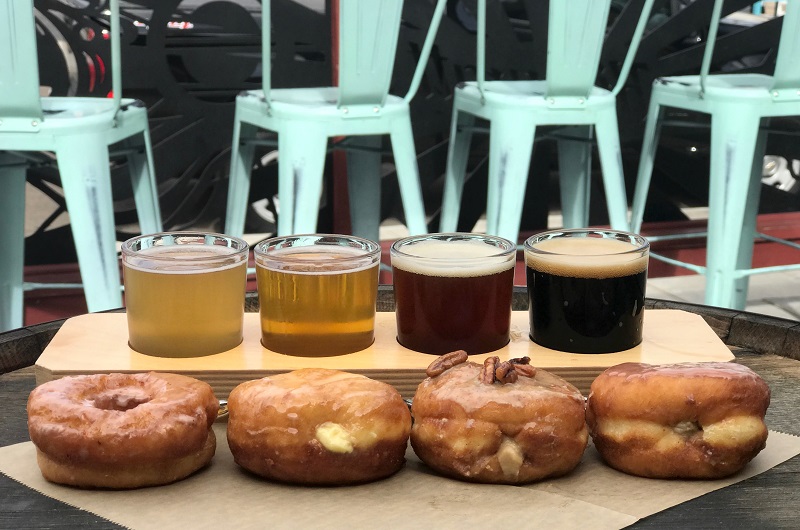
Nomad Donuts in San Diego. (Photo by Amanda Hickethier)
San Diego
This SoCal bastion of beer culture supports 70 breweries (the 150-plus count that gets used is for the entire county). Nomad Donuts (3102 University Ave.) has collaborated with about 25 of those breweries, including several in its North Park neighborhood such as Fall Brewing Co. (4542 30th St.), Eppig Brewing (3052 El Cajon Blvd Suite C), and North Park Beer Co. (3038 University Ave.). So popular are these Nomad collabs that Kristianna Zabala, the shop’s executive pastry chef, undertakes at least one monthly (and daily during San Diego Beer Week). One brewery that partners with Zabala beyond sugary doughnuts is Council Brewing (7705 Convoy Ct.), with its Magic Factory sour sideshow. One dinner course featured a Scotch quail egg savory doughnut glazed with chamomile and paired with Council’s Separate Haze IPA.
Denver
Do you sense a pattern emerging? Beer meccas are becoming doughnut paradises. Denver’s River North neighborhood supports a baker’s dozen breweries. One such brewer, Ratio Beerworks (2920 Larimer St.), organizes the Cool Beans event featuring its own beers infused with coffee, including Domestica blonde ale and an Irish-coffee-flavored version of Nobody’s Darlin’ strong ale. Logically, Denver doughnut legends Glazed and Confuzed (2501 Dallas St., Aurora) were on hand doling out doughnut holes. Over in the Highland neighborhood, Habit Doughnut Dispensary (1553 Platte St.) takes the Mile High’s affinity for hip doughnuteries and prescribes the cure—like the “Blazed” (brûléed) glazed. A block away at Denver Beer Co. (1695 Platte St.), you can enjoy Princess Yum Yum Raspberry Kolsch with the tart strawberry lemonade doughnut. Some of Habit’s creations are even served with a shot tucked inside, giving the boilermaker its much-needed 21st century makeover.
North Carolina
Asheville’s downtown boasts a cluster of breweries, several of which—including Twin Leaf Brewery (144 Coxe Ave.), Wicked Weed’s Funkatorium (147 Coxe Ave.), Green Man Brewery (27 Buxton Ave.) or Burial Beer Co. (40 Collier Ave.)—are walkable from Vortex Doughnuts (32 Banks Ave.). Vortex capitalizes on the city’s many beer tourists, and caters to both vegans and bacon-lovers alike. For Burial’s part, its winter seasonal Skillet Donut Stout (an oatmeal stout made with molasses and coffee, no doughnuts) offers everything doughnut lovers love except the chew. In Boone, the Appalachian Mountain Brewery (163 Boone Creek Drive) also makes a doughnut beer, made with the spudnuts (potato doughnuts) from its neighbors at Local Lion (791 Blowing Rock Road), a gourmet coffee and from-scratch doughnut shop. Wu-Tang fans will appreciate the brewery’s C.R.E.A.M. (Cappuccino Rules Everything Around Me).
Brian Yaeger is the author of Red, White and Brew: An American Beer Odyssey and Oregon Breweries.
The post Exploring Ohio’s Beer and Doughnut Trail appeared first on All About Beer.
]]>The post Beer of the Moment: Ommegang Saison Rosé appeared first on All About Beer.
]]>The post Beer Weekend: 48 Hours in Atlanta appeared first on All About Beer.
]]>Even though I am a globe-trotting beer writer, one of the things I love most is boasting about my hometown’s craft beer scene. Since moving to Atlanta in ’94, I knew it would be a matter of time before the entire state of Georgia embraced the craft beer movement. Though I was initially welcomed by laws severely limiting ale and lager varieties, a decade of prayer and politicking has brought change.
The most recent advancement was Georgia Gov. Nathan Deal signing Senate Bill 85 into law, permitting breweries and distilleries to sell directly to their consumers—including growlers and up to a case of product. As a result, another wave of breweries and brewpubs have surfaced in anticipation of this law’s economic impact.
To narrow down where to eat, imbibe and shop for the weekend, the following roundup focuses inside the I-285 perimeter of Atlanta, popularly termed the “ITP.” With more than 20 breweries inside the perimeter alone, ATL has officially become a “beer city.”
Friday
If you had to choose one area of Atlanta to get your craft brew sipping on, Decatur would be it. Starting from the most eastern location leading into its neighborly downtown, My Parents’ Basement (22 N. Avondale Road) in the Avondale Estates sector combines the best worlds of geekdom—comic books, gaming and a steadily rotating 32 taps. Grab a bite from the extensive, vegetarian-friendly menu, too, before hitting the numerous stops to follow. Wild Heaven (135B Maple St.) is the second stop. Co-founders Nick Purdy and Eric Johnson blessed ATL’s beer scene with their Ode To Mercy coffee brown ale and Invocation Belgian-style golden ale via contract brewing in 2010. Since then, this duo opened their own festive brewery in 2013 that now boasts a large patio, barrel aging, limited-released sours, IPAs and European-inspired beer served by one of the most hospitable staffs in the state. (They have a second, 21,000-square-foot brewery in the works alongside BeltLine’s Westside Trail, under construction, too.)
Just over a half-mile down East College Avenue is Three Taverns (121 New St.) where owner Brian Purcell has been pouring his outstanding renditions of Belgian ales, Russian imperial stouts, IPAs and sours from the taps of “The Parlour” inside his rustic-meets-chic brewery since 2013. Request anything from the Imaginarium, Hop Leaf and Sour Asylum Projects. Getting back on College Avenue, stop by Ale Yeah! (906 W. College Ave.) and browse through an expert-curated selection of craft cans, bottles, bombers and small bites like cheeses, pretzels and cured meats. And yep, there are growlers and a “build-your-own six-pack” option as well. There is also The Beer Growler (38A N. Avondale Road) in the Avondale Estates specializing in filling 32-and 64-ounce growlers to go from 42 taps.
Now to turn it up a notch and head a mile east toward downtown Decatur. Twain’s Brewpub & Billiards (211 E. Trinity Place) has award-winning homebrewer-turned-brewmaster Mike Castagno providing at least eight rotating in-house beers and chef Ryan Burke making sure no one’s hungry with numerous edibles (including vegan and vegetarian). Add shuffleboard, darts, a full pool hall and TVs throughout, and boredom is virtually impossible. Crossing the street, the historic Decatur Square awaits with one of the most esteemed institutions in the craft beer industry, Brick Store Pub (125 E. Court Square). For two decades, beer aficionados worldwide have flocked here to choose from the 29 taps and beer engine downstairs, eight brews on rotation at the Belgian Bar upstairs, and a gawk-worthy cellar array of more than 900 vintages available from the menu of biblical proportions. There are no TVs, all breweries have to fall under the Brewers Association’s strict craft beer specifications, and food is prepared with the freshest ingredients. Its gastropub sibling just around the corner, Leon’s Full Service (131 E. Ponce de Leon Ave.), is celebrated for its inventive cocktail program, but still offers an impressive list of hard-to-find craft beers. That’s Decatur, and what I consider an awesome Friday.
Saturday
Trusting a good sleep followed your unforgettable Decatur hop, a rebooting “hair of the dog” brunch menu awaits at The Porter Beer Bar (1156 Euclid Ave. NE) in the historic Old Fourth Ward just east of downtown Atlanta. Based in the bohemian-flavored shopping district called Little Five Points where ATL’s weird, hip, health-conscious and artistic types assemble, the Porter is one of Atlanta’s prime destinations for beer lovers. Husband-and-wife team Nick Rutherford and Molly Gunn—along with their knowledgeable staff—are in their ninth year serving more than 430 beers, top-shelf spirits and plates of award-winning fare sourced from local farms (including their own).
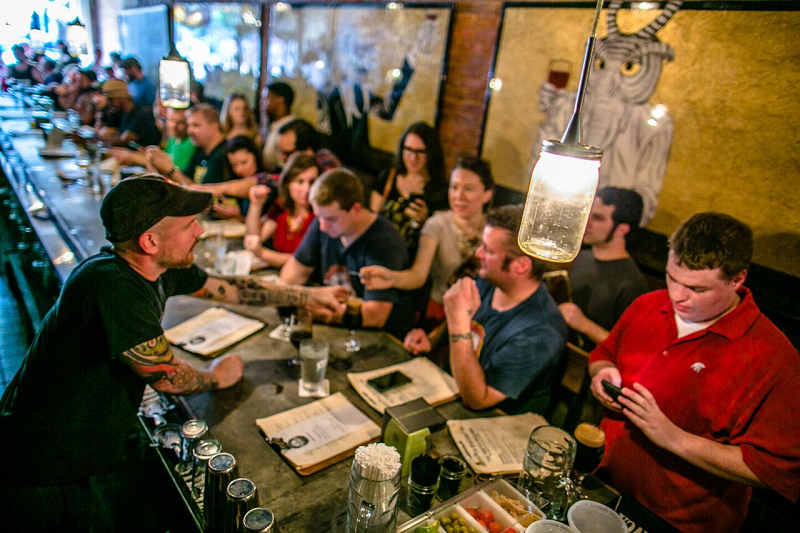
(Photo courtesy The Porter Beer Bar)
Stopping by here is a must, as is nearby Wrecking Bar Brewpub (292 Moreland Ave. NE), located in the basement of a Victorian home known as the Victor H. Kriegshaber House. Garnering a steady flow of awards for its balance of Chef Terry Koval’s delectable farm-to-table fare, managing partner Stevenson Rosslow’s mixology and extraordinary beers brewed by owner Bob Sandage and brewmaster Neal Engleman, this brewpub has been catching wreck since 2011. (Note: If any Siberius Maximus imperial stout variations are available, get one. They consistently win Georgia’s Annual Strong Beer Fest, which they also host.)

(Photo courtesy The Midway Pub)
Continuing 1.5 miles south, East Atlanta Village has two gems worth visiting. The airy, three-level Argosy (470 Flat Shoals Ave. SE) boasts an eye-popping interior that includes mural art, wood fixtures, a wood-fired pizza oven and a secluded Brigantine Beer Parlor and Recreation Hall in the back with a giant wooden squid suspended from its ceiling. Although the latter is usually open at night, take a gander; you can always come back for a late-night visit. (Note: Wrecking Bar and Argosy’s brunches are both lip-smackin’ good.) Stroll a block down to Midway Pub (552 Flat Shoals Ave. SE), an energetic neighborhood hangout ideal for watching sports (especially soccer and football) on numerous HD-TVs and projector screens, playing board games, chilling at the patio and Tiki bar, enjoying solid pub grub; and yes, consuming beer. Thirty-two rotating taps.
And now it’s the Westside’s turn.
Take an Uber or Lyft for 10 minutes and arrive at the new brewing location that rocked ATL’s beer scene in 2017. Monday Night Brewing (670 Trabert Ave. N.W.) hit the ground running with the introduction of its Eye Patch IPA and Drafty Kilt Scotch Ale in 2011; now, a second location specializing in barrel-aged brews and sours called The Garage (933 Lee St. SW) is the place to be. It’s a 20,000-square-foot fun factory along the Southwest Trail of the steadily aforementioned Atlanta BeltLine.
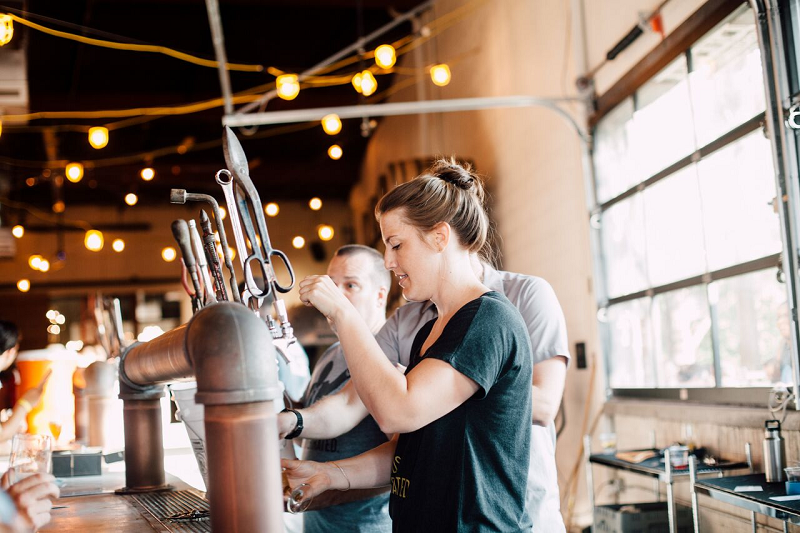
The Garage at Monday Night Brewing (Photo courtesy Monday Night Brewing)
As night sets in, hit up Ormsby’s (1170 Howell Mill Road). Everyone from Georgia Tech students and hipsters to businesspeople yearning to loosen their shirt buttons wine and dine on the first level’s restaurant. Downstairs is Atlanta’s most festive basement, with shuffleboard, billiards, darts, Skee-Ball, two bocce ball courts, board games and that rope, ring and hook thingy. An impressive draft list and delectable, upscale pub menu close this evening with an exclamation point.
Sunday
Take advantage of Atlanta traffic’s least-congested day of the week to bounce around a bit throughout the city.
Reflect on your weekend so far by taking a walk along the eastside BeltLine starting at the Historic Fourth Ward Skatepark (830 Willoughby Way NE), appreciate the mural art on the way heading south, listen for cyclists trying to break the sound barrier. Then set up a tent (figuratively) at the camping ground-inspired Ladybird Grove and Mess Hall (684 John Wesley Dobbs Ave. NE) to sip a Creature Comforts Tropicália IPA (one of the few venues that have Georgia’s most popular IPA on draft virtually all the time) and Ladybird’s hearty brunch. Just make sure you set your taste buds to 12:30 p.m. for alcohol orders; it’s the state law on Sundays (I know, I know).
From there, get back on the BeltLine and pass the skatepark until you get to the all-new New Realm Brewing Co. (550 Somerset Terrace NE) just before the Ponce de Leon Avenue bridge. It’s arguably Atlanta’s most anticipated brewery to open in years—plus the largest to ever open in Georgia—and the hype is justified. Stone Brewing Co.’s former brewmaster, Mitch Steele, brought his talents to Old Fourth Ward thanks to Realm’s 40,000 square feet brandishing a rooftop bar with a stunning skyline view, a lively beer garden to entice pedestrians and a 20,000-barrel capacity to make more than just phenomenal IPAs. Executive Chef Julio Delgado ensures you’re good if an appetite surfaces.

(Photo courtesy SweetWater Brewing Co.)
Next, it’s time to take a ride to Midtown and pay homage to the Southeast’s largest craft brewery, and by last count, 15th-largest in the U.S.— SweetWater Brewing Co. (195 Ottley Drive NE). Known for its edgy marketing, being one of the first to introduce West Coast styles to Atlanta, clean water initiatives, its one-and-done “Dank Tank” beer series and annual kickass 420 Fest, SweetWater is also the most enterprising since 1997. The brewery’s latest additions include the stunning barrel-aging facility called The Woodlands and a pilot system where longtime head brewer Nick Nock and his team have been diversifying the portfolio and crafting experimental beers exclusive to brewery visitors.
Hungry? Hit up one of the more extraordinary beer andfood concepts on the East Coast called Hopstix (3404 Pierce Drive) in mushrooming Chamblee. It’s a brewpub serving solid house-crafted ales and lagers alongside local brewery selections, but what brings it over the top is the stellar Asian fusion-themed menu overseen by passionate executive chef Dony Raymond and prepared in an open kitchen. How many brewpubs have robata grilling, Alaskan king crab fried rice and a whole bluefin tuna being cut for tartare under the same roof as a brewhouse? Hopstix’s founder and brewer, Andy Tan, has wowed every guest since opening in early March of 2017.
To conclude the evening, take a ride to The Chapter Room (5600 Roswell Road) in Sandy Springs on the northwest side to sip some of the most hard-to-find ales and lagers in the city. Based underneath one of Taco Mac’s tri-state restaurant franchise locations is its rendition of a speakeasy, complete with a buzzer and peephole. Once the metal door swings open, the interior is designed to mimic the inside of a barrel with posh leather seating, carpet, intimate lighting and an array of spirits setting the tone for the perfect toast-off to a spectacular beer weekend in ATL.
Don’t Sleep:
It’s all about the amount of time you have in ATL, but the westside’s Scofflaw Brewing Co. (1738 MacArthur Blvd. NW) has become one of the fastest-growing breweries in the South due in part to its phenomenal IPAs and embracing of the now infectious “We-don’t-give-a-f#*k” mentality. Renowned brewmaster Travis Herman (formerly of Russian River) makes sure all of Georgia blissfully sips its array of delicious, mostly potent selections with an attitude.

(Photo courtesy Red Brick Brewing Co.)
The oldest existing craft brewery in Georgia, Red Brick Brewing Co. (2323 Defoor Hills Rd. N.W.), has also been impressive over the past few months after having Gavin McKenna take over the direction of operations. Its latest Journey Without Maps imperial IPA indicates good times are ahead.
Dennis Malcolm Byron, a.k.a. Ale Sharpton, is a world-renowned beer authority, award-winning journalist, blogger (AleSharpton.com), photographer, event host and gourmand. Globetrot with him on Twitter and Instagram.
The post Beer Weekend: 48 Hours in Atlanta appeared first on All About Beer.
]]>The post Beer in the Shadow of War appeared first on All About Beer.
]]>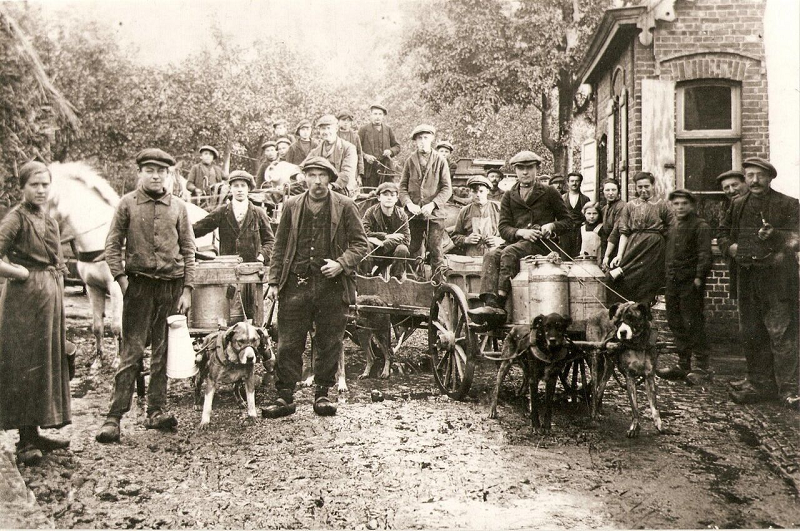
Dog carts transporting milk in 1917. (Archived photo courtesy Stadsarchief Eeklo)
Two bullets. That’s all it took to push the world over the edge.
Two bullets fired into the side of a sedan in Sarajevo killed Archduke Franz Ferdinand and his wife, Sophie, pushing an already tense Europe irretrievably into war. What became known as The Great War affected millions, touching the lives of nearly every man, woman and child in Europe. It also had profound effects on a number of industries, including brewing.
Before the war, there were more than 6,000 breweries spread across Belgium and France, with the majority of the French breweries located along the northern border with Belgium and Germany. World War I profoundly changed the face of brewing in Western Europe. Germany-backed Austria-Hungary’s desire to punish the Serbs for the assassination drew Russia and France into the war to defend the Serbs. Germany’s strategy involved a lightning-quick strike through neutral Belgium into northern France to capture Paris. Unfortunately for the Germans, the French and English halted their advance and created a brutal four-year stalemate that encamped millions of soldiers from both sides directly through the heart of Belgian and French brewing country.
War destroyed breweries and tore families apart. Brewers had their personnel drafted, their equipment confiscated and their futures imperiled or destroyed. Those breweries located away from the front endured rationing of ingredients and government-mandated controls designed to support the war efforts. Breweries near the front brewed beers to satisfy the tastes of the troops and give them some semblance of normality and a respite from life in the trenches. From Trappist monks to centuries-old family brewers to soldiers in the trenches, the war irrevocably affected everyone and everything it touched—including beer.
Invasion: Destruction and Survival
The Germans declared war on Aug. 3, 1914. A day later, five armies marched across neutral Belgium’s border. The Germans obliterated the Belgian fortress at Namur using their high-powered artillery and marched the rest of the way into Belgium before swinging south into northern France. Eventually, the Entente forces of France and Britain pushed them back before the Germans could capture Paris. For the next four years, that line—which stretched 650 kilometers from the Belgian coast in West Flanders through northern France to the border of Switzerland—would be known as the Western Front. That line remained virtually unchanged until the summer of 1918. Over the intervening four years, the Western Front brutally ended the lives of millions of French, English, Belgians, Germans and other allied troops. Some died from disease, rifles, machine guns or poisoned gas, but most would die from heavy artillery fire. It’s estimated that the Germans alone fired 222 million artillery rounds over the course of World War I. Production of all those rounds required a lot of raw materials, including copper and steel.
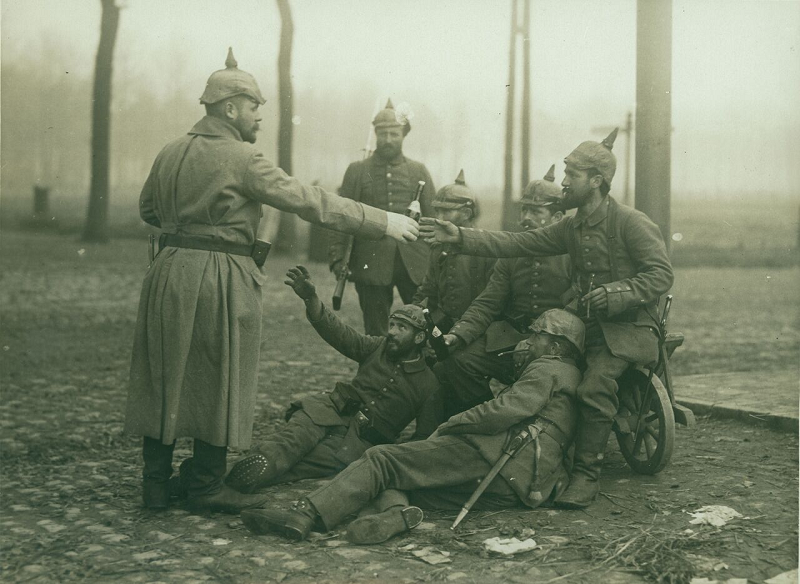
German soldiers distributing beer in 1914. (Archived photo courtesy Flanders Fields Museum)
According to Pierre-André Dubois, the French retired brewer, beer historian and one-time travel companion to beer writer Michael Jackson, the Germans had a plan to help with resources.
“During the occupation of our region by the German army, an industrial spy agency was created in Munich by the ‘Grand Quartier Général,’ ” says Dubois, reading through his own work. “The report published in 1916 concerning the breweries of Nord/Pas-de-Calais in the occupied zone … lists 680 sites.”

Pierre-André Dubois looks over his map. (Photo by Christopher Barnes)
The Germans also designated which breweries (the most modern) were allowed to continue production to supply their troops. “Due to the wells and water heating equipment, the Germans converted other breweries into cavalry quarters, baths, laundries, dewatering stations and slaughterhouses.” The rest were pillaged for materials that were shipped to German arms production plants.
The story was the same for breweries in occupied Belgium. Many brewers had their equipment ransacked by the occupiers, especially those who heeded the call from the Belgian government not to brew for the Germans. Paul Verhaeghe, then owner of Brouwerij Verhaeghe, maker of Duchesse de Bourgogne, was one of those brewers. In response, the Germans dismantled his brewery.
Other Belgian breweries were destroyed during the fighting. Karel Leroy of Leroy Breweries, whose family brewing history includes both Brouwerij Van Eecke, maker of Poperings Hommelbier, and Brouwerij Het Sas, maker of Sas Pils, recounted the fortune of each brewery.
“Brouwerij Sas was destroyed by retreating French and Belgian troops,” says Leroy. “It was on the wrong side of the canal so it was burned down before the German troops could arrive.”
The other side of the family, however, had much better fortune. Van Eecke was located in Watou, which was several kilometers west of Ypres and the front lines. Most of the brewery’s beer was sold in Poperinge, which was a popular place for British troops to rest and relax in between stints at the front.
Van Eecke’s neighbor, the Trappist abbey of St. Sixtus (Westvleteren), was forced to lay aside its quiet contemplations when its proximity to the front made it an ideal way station, first for French troops then later for British troops. From the fall of 1914 through the end of the war in 1918, thousands of troops were stationed at the abbey.
One of the monks, Brother Victor Van Staten, wrote in his journal of the cramped quarters at the abbey among the French troops in 1914.
“Powder cars, rifles in piles or standing against the wall, officers here, captains or sergeants there; buildings, attics, barns, cowshed, everything is full of soldiers,” wrote Van Staten. “The brothers are almost unable to milk the cows; even the space between the cows is full.”
Once the French moved out in the spring of 1915, the British forces took over the area surrounding the abbey. With the British, rules were strict, but there were far fewer soldiers billeted inside the abbey walls. Officers and their support staff were stationed inside, while the majority of troops were camped in the surrounding fields and woods. The monks did take advantage of the British love of beer.
“The beer in the cellar of the guest house is sold to the soldiers,” wrote Van Staten in his journal. “We were doing good business, but the word came from the General that too much noise was being made and caused a disturbance in the big office which was above the cellar. So, they had to see where to move the canteen to now.”
The monks of Westvleteren, the only Belgian abbey that wasn’t occupied by the Germans, were the only Trappists able to brew throughout the war. The abbey and its monks, however, didn’t make it out completely unscathed.
In 1917, six monks from St. Sixtus were conscripted into service as stretcher bearers and nurses. Brother Stanislas would never return, dying in September of 1918 from an unnamed disease. Likewise, 12 monks from Chimay, including the Abbot Anselme le Bail, were mobilized as chaplains and stretcher bearers. When the monks of Chimay returned home in the spring of 1919, only 10 had survived. Fathers Herbelin and Carlier were both killed in action.
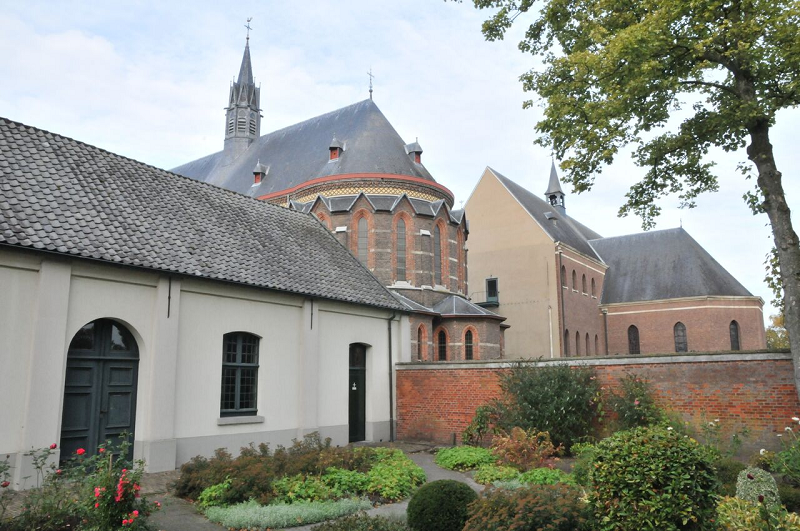
Achel Brewery in Hamont-Achel, Belgium. (Photo by Christopher Barnes)
The other abbeys didn’t get through the war completely intact. The monks of Westmalle and Achel were forced to flee to The Netherlands. The Belgians, in their defense of Antwerp, destroyed a tower at Westmalle to prevent it being used as an observation post by the approaching Germans. Achel was occupied by the Belgians and shelled by the Germans until they were able to solidify their hold on Belgium. To keep citizens from going back and forth over the border with The Netherlands, the Germans erected an electrified fence along the border. Since Achel straddles the border of The Netherlands and Belgium, the fence bisected the abbey’s lands. When the call went out from the German War Department, the monks of Achel were able to sadly watch as their brewery was dismantled. No beer was brewed at Achel until 2001. The Germans also confiscated copper from Chimay, Westmalle and Rochefort.
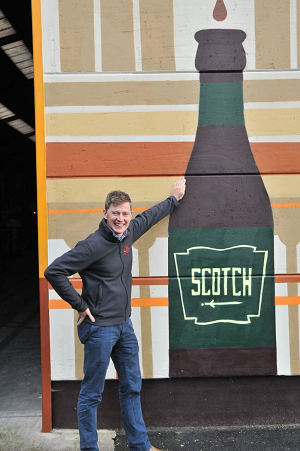
Lionel van der Haegen of Brasserie de Silly. (Photo by Christopher Barnes)
This was the biggest damage the Germans inflicted on the breweries of occupied Belgium and northern France. Every brewery that wasn’t of use to the Germans was stripped of its valuable brewing equipment.
A few wily brewers, though, were able to fool the Germans. Lionel Van der Haegen, who owns Brasserie de Silly with his cousin Bertrand, describes how his great-grandfather, Adelin Mynsbrughen, saved the brewery’s copper equipment.
“They came here to take all the copper,” he says. “Here, in our brewery, my great-grandfather painted most of what was copper, his kettles and his tanks, he painted black so it looked like cast iron. He still had some few things in copper they took. Also, our brewhouse, we have two copper tanks; they were behind walls. So you could see a little bit of copper on top of it, but behind the walls you couldn’t see it.”
Similarly, Timmermans protected its giant copper coolship by painting it red and claiming it was cast iron and undesirable.
Even if a brewery managed to keep its equipment, times were extremely difficult. Food was scarce and ingredients were often confiscated by the occupiers or their own governments to feed the war efforts. Those breweries that were allowed grain supplies, particularly in occupied France, were required to send the beer to rail stations where it could be distributed to the German soldiers near the front. Beer was hard to come by for civilians. People brewed, mostly illicitly, a kombuchalike drink made from water, yeast, ash leaves and the pulp of processed sugar beets. Another version was brewed with molasses and dandelion leaves, according to Pierre-André Dubois.
Even in unoccupied areas, breweries suffered through war rationing and a lack of basic ingredients. Some breweries situated near British troops, however, managed to do reasonably well.
“The English were especially big beer drinkers,” says Dubois. “Their presence created a strong demand that the brewers had trouble satisfying. They were subject to the war economy. Men and horses were at the front. Because of a lack of fertilizer, agricultural yields were down sharply. Wheat production for bread and oat production for livestock and horses is prioritized, while the main barley and hop growing region was […] in the occupied territory.”
Reconstruction: New Breweries and New Beers

Rémy Victor Ricour escaped the Germans in 1918 and later purchased Brasserie St. Sylvestre. (Photo by Christopher Barnes)
As the tide of war began to turn (thanks in part to the United States joining the war against the Germans), Allied troops liberated the occupied lands of France and Belgium throughout mid- to late 1918. In the unoccupied territories near the front and the newly liberated areas, the interaction with beer-loving British troops introduced new styles into the brewing lexicon of northern France and Belgium. Stouts, bitters and Scotch ales sprang up to satisfy the needs of the allied troops. In some cases, the troops went quite far to get a taste of home. Brasserie de Silly is most famed for its Scotch de Silly, which was created at the end of WWI to satisfy the thirst of a Scottish regiment stationed in the area.
“At the end of the war, they came by asking for a Scotch beer like they had back home,” recalls Lionel van der Haegen. “Here, this style is unknown. They asked my great-grandfather, Adelin, to make a Scottish ale. He said, ‘I don’t know how to make this style of beer, and I don’t have enough raw materials to even make my own beers. And I don’t have the raw materials to make this type of beer. No, not possible.’ They insisted, and he finally said yes because the soldiers brought some malts and hops from England and gave it to my great-grandfather. One of the Scottish soldiers was a brewer before the war. He started working at the brewery. Jack Peyne [the Scottish brewer] ended up staying, marrying and living in the area. He worked at the brewery until he retired. His descendants still live here.”
With the war’s end, Jack wasn’t the only soldier to leave the army for brewing. Rémy Victor Ricour served France during the war, was captured by the Germans in 1917, and escaped in 1918 before the end of the war. He used his soldier’s and prisoner’s pensions, along with loans from his family, to purchase Brasserie Saint-Sylvestre from his great-uncle. Located well behind the front, the brewery had been spared the ravages of war. Today, his great-grandson Pierre Marchica owns the brewery, which produces the famed 3 Monts Flanders Golden Ale.
Many produced beers to honor victory and liberation. The Moortgat family’s renowned Duvel started its life as “Victory Ale” and is brewed with a yeast strain that traces its history to Scotland. Omer Vander Ghinste named his new post-war creation “Biere des Jacobins,” now known as Cuvée des Jacobins, after Rue des Jacobins in Paris where he lived after he’d fled the German invasion.

The Dhaussy family and Pierre-André Dubois. (Photo by Christopher Barnes)
Brewers continue to dedicate beers to The Great War. The Dhaussy family have been brewing in the French countryside near Cambrai for generations. After a hiatus in the ’50s and ’60s, Alfonse Dhaussy purchased Bourgeois-Lecerf Brewery in 1977. Today, it is known as Brasserie La Choulette and is run by his son Alain and his grandson Moïse Dhaussy. On a system installed with war reparation money, they’ve brewed a blond ale called “Battle of Cambrai” dedicated to the British troops and the famed battle that saw the first large-scale use of the newest weapon of war: the tank.
Similarly, Van Honsebrouck of Izegem, Belgium, brewer of the Kasteel and St. Louis brands, created a beer dedicated to one of the major local battles in West Flanders. Passchendaele was created by the brewery in cooperation with Eric Deprez, a tour guide at Van Honsebrouck and a retired special forces member of the Belgian army. Deprez is also an amateur historian who leads tours of World War I sites, including the battlefield at Passchendaele. Part of the proceeds from the blond ale of the same name support local organizations commemorating the battle and its history.
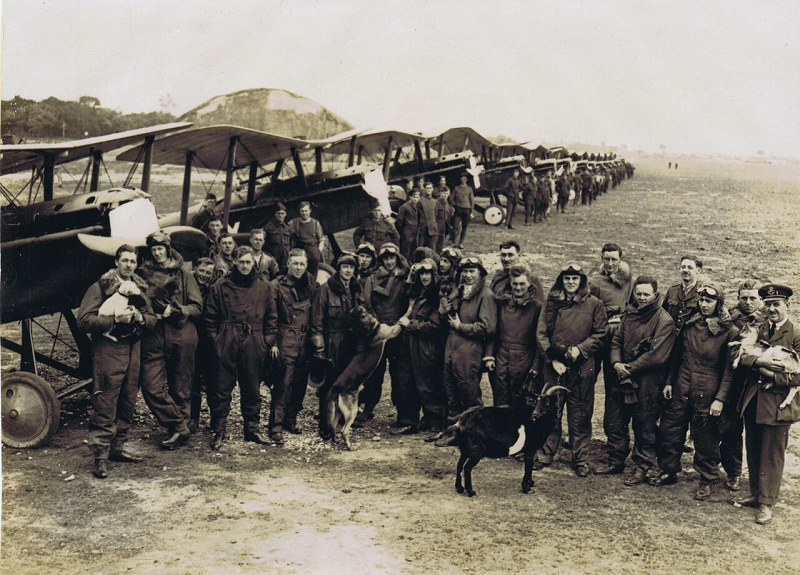
British soldiers, date unknown. (Archived photo by Philippe Oosterlinck)
Germany surrendered and signed the armistice ending The Great War on Nov. 11, 1918. Rebuilding began and reparations were paid, though many breweries in both Belgium and France never reopened for a wide variety of reasons. In some cases, the brewers died fighting. In other instances, particularly with the rural breweries, families chose to take their reparation money and focus on farming. Some brewers chose to pool their reparations with others to build larger and more modern breweries. And in some cases, families rebuilt cheaply, brewed a few batches to claim their reparations, and then sold off the equipment and kept the remaining money.
World War I devastated the brewing industry in Belgium and France. Of the 2,419 breweries in northern France before the war, only 1,371 remained in business by the mid-1920s, according to an article by Dubois. In Belgium, 2,109 of the pre-war 3,214 breweries were still open, as noted in Jef Van den Steen’s book, Trappist: The Seven Magnificent Beers.
In the shadow of 40 million casualties, beer seems a small and trivial thing. Yet for those in occupied areas or on the front lines, it was a welcome luxury and a reminder of better times.
Christopher Barnes is a 17-year veteran of the craft beer/cider business, and contributes regularly to Belgian Beer & Food, The Full Pint and his own site, ithinkaboutbeer.com.
The post Beer in the Shadow of War appeared first on All About Beer.
]]>The post Fulton Barrel Aged Mixed Pack appeared first on All About Beer.
]]>(Photo courtesy Fulton Beer)
The post Fulton Barrel Aged Mixed Pack appeared first on All About Beer.
]]>The post Silva Brewing Brings Back Silva Stout appeared first on All About Beer.
]]>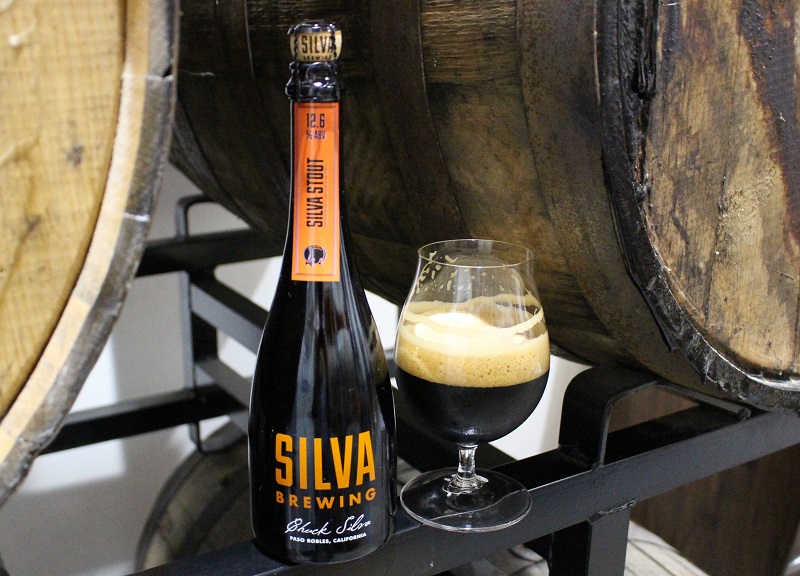
(Photo courtesy Silva Brewing)
(Press Release)
PASO ROBLES, Calif.–With trademark in-hand, Silva Brewing owners, Chuck and MJ Silva, set out to write the next chapter in the highly acclaimed saga of the award-winning barrel-aged imperial stout, Silva Stout . Chuck originally brewed and bottled the beer in 2010 while brewmaster at San Diego’s Green Flash Brewing. The beer was a Top-Rated beer after its initial bottle release in 2010 and remained on numerous top 100 lists for years while also earning a prestigious silver medal in the Wood- and Barrel-aged Strong Beer category at the 2012 edition of the Great American Beer Festival.
. Chuck originally brewed and bottled the beer in 2010 while brewmaster at San Diego’s Green Flash Brewing. The beer was a Top-Rated beer after its initial bottle release in 2010 and remained on numerous top 100 lists for years while also earning a prestigious silver medal in the Wood- and Barrel-aged Strong Beer category at the 2012 edition of the Great American Beer Festival.
“When MJ and I left San Diego to start our own brewery, we felt we had a duty to keep Silva Stout alive and, in doing so, replicate the glory of those original, award-winning batches,” says co-founder and brewmaster Chuck Silva, who tips his hat to Green Flash for handing him the trademark when he set off for Paso Robles. “I’m giving Silva Stout
alive and, in doing so, replicate the glory of those original, award-winning batches,” says co-founder and brewmaster Chuck Silva, who tips his hat to Green Flash for handing him the trademark when he set off for Paso Robles. “I’m giving Silva Stout a rebirth with a new imperial-stout base recipe that adds depth and fullness to the beer’s body and overall character. A variety of different spirit barrels are being used to age the stout for extended periods to get the full flavor each barrel has to offer and allow for unique small-batch releases.”
a rebirth with a new imperial-stout base recipe that adds depth and fullness to the beer’s body and overall character. A variety of different spirit barrels are being used to age the stout for extended periods to get the full flavor each barrel has to offer and allow for unique small-batch releases.”
The new imperial stout siphoned into those barrels goes by the name Ouroboros (the Greek symbol of rebirth). The first release will consist of stout aged for 14 months in rye whiskey barrels. Maturation in rye barrels lends boozy notes along with nuances of molasses and oak that mesh with the base-stout’s inherent dark chocolate and roasted cacao flavors. Additional notes of plum, dates and prunes come courtesy of the barrel-aging process while a hint of cola nudges its way in care of exotic sugars added to the boil kettle. The contents of two rye whiskey barrels were blended together for this release, with a touch of fresh stout added back to tame the booziness and finesse the concentrated beer.
“The anticipation has been building over the past year for all of us as we’ve watched the stout ooze out of the cracks in the barrels, creating what looks like strands of stout candy,” says co-founder and head of operations MJ. “I’m happy to say the time has come for us to stop talking about how Silva Stout is going to turn out. Now that we’ve gone through the expert blending and bottling, it’s finally ready to share with everyone!”
is going to turn out. Now that we’ve gone through the expert blending and bottling, it’s finally ready to share with everyone!”
Cork-finished 510-milliliter Italian-sourced Tosca bottles of Silva Stout will be available for purchase at the Silva Brewing tasting room, located at 525 Pine St, Suite B, Paso Robles, starting Friday, June 1, 2018, with samples available on-draft while supplies of this highly-anticipated and limited release last. Future releases of Silva Stout
will be available for purchase at the Silva Brewing tasting room, located at 525 Pine St, Suite B, Paso Robles, starting Friday, June 1, 2018, with samples available on-draft while supplies of this highly-anticipated and limited release last. Future releases of Silva Stout will explore the beer aged in different types of barrels and remain small-batch in nature.
will explore the beer aged in different types of barrels and remain small-batch in nature.
ABOUT SILVA BREWING: In 2015, husband-and-wife team, Chuck and Mary Jo Silva moved to Paso Robles, California, to open their passion project, Silva Brewing. It was a homecoming for Chuck, who was born and raised on the Central Coast before relocating to San Diego and subsequently making a name as one of the region’s—and the country’s—foremost brewing innovators. After amassing numerous awards on a regional, national and global scale as the Brewmaster for one of the nation’s top 50 craft breweries located in San Diego, he decided to downsize for the purpose of chasing his muse on a personal, much smaller scale back home. Silva Brewing is equipped with a 10-barrel direct-fire brewhouse manufactured by Premier Stainless Systems, 100-barrels’ worth of cellar capacity, and a tasting room outfitted with 11 taps serving beer for consumption on-site and to-go, Wednesday through Sunday. The company’s annual production capacity is 1,200 barrels, and its beers are distributed to distinguished hospitality venues throughout the Central Coast and South all the way to San Diego. For more information on Silva Brewing, consult the company’s website—silvabrewing.com—or follow Chuck and MJ on Facebook, Twitter or Instagram (@SilvaBrewing).
The post Silva Brewing Brings Back Silva Stout appeared first on All About Beer.
]]>The post Why Beer Writing? appeared first on All About Beer.
]]>
(Photo by Daniel Hartis)
Every worthwhile human endeavor has a genre of written criticism attached to it: music, theater and film, sports, painting and sculpture, dance, certainly food, and writing itself. Why do we want to write about these things, and why do people eagerly read about them? Why do we write about beer? Why do you read about it?
The cynic might respond, “You write about beer because they pay you to,” but it’s a rare beer writer of any merit who doesn’t also write for free, whether blogging, writing comments on Facebook or Twitter, or dropping remarks on other beer websites. (Now doesn’t that bring up a timely thing: If you’ve been doing free beer reviewing for RateBeer.com, who owns that writing? You, or RateBeer, or Anheuser-Busch InBev?)
There are reasons as varied as people, of course, but generally it’s to put the work in context. A good critic has dug deep into the history and setting of the field and can identify ground that’s been plowed before and know if this is a new riff or simply a restating of the old. She can point to earlier or contemporaneous examples, identify roots and influences that may be of interest as well, and explain why it is that this particular bit of craft represents a wholly new departure. He can compare it with beers from much older breweries, explaining why it stands up well or falls short of glory.
The critic can also burnish the art with details, giving the reader more information that has been carefully, accurately gathered and arranged. What kind of paint was used and how was it applied? What college did the player attend, who coached him, and what promise did he show? What part does the Burton Union fermentation play in the actual character of the beer on the palate?
The critic can connect the reader to the artist and make that part of the process meaningful, important. Where did the choreographer learn to dance, and what identifies his style? Did the musician study under a famous teacher, or is she self-taught? Where did the brewer work before; do the signature beers from those places inform his brewing today, or has he made a clean break to do something else he’d always wanted to do?
Sometimes, of course, we write about beer just to fill in the blanks. Why are wheat beers made with wheat, what does it add? How does the mash work, what’s going on? And yes, how does a centrifuge make for hoppier flavor concentration?
But a writer needs an audience, however small, so why the hell do you read it? Why are there magazines like this one, devoted to beer, with regular readers who just have to know this stuff?
The answer’s pretty simple: You’re fans. You care. Maybe to an outsider you care too much, but that’s the way of the enthusiast’s world.
It reminds me of a Twitter discussion I had recently, related to the very divisive issue of bought-out brewers. It was in the wake of Wicked Weed Brewing’s sale to AB InBev, when everyone was making sure everyone else knew they would never be drinking Wicked Weed again. I suggested that the quality of the beer should be considered (as apparently a lot of people are doing with Bourbon County Brand Stout) and was told this: “It boils down to this: you either care, or you don’t. I sense you don’t, and that’s OK.”
I responded that I cared about who made the beer, but I cared more about the beer. (That, by the way, is another reason I write about beer: because I like thinking about this stuff, and I like stirring up discussion about it.)
The response I got popped my eyes: “That’s like saying, ‘I don’t care about the slave labor used, I just care about the diamonds.’ It either matters or it doesn’t.”
The analogy is over the top–beer ain’t diamonds, and there’s no slaving going on!–but the passion is spit-talking clear. This guy reads about beer, and writes about beer, and cares about beer. People like that are one of the main reasons I write.
Because beer may not be diamonds, but it is beer. Just to put that in perspective: Beer was around for thousands of years before cut diamonds, and world beer production in 2016 was worth almost 50 times world diamond production. Put a ring on that, baby.
We care about it. I care enough that I abandoned a steady job to spend hours a week writing about it. You’ll read that, and more, and talk about it, and hunt it down.
That’s about all the answer I need for that question. As the late publican and American beer hero Don Younger used to say: “It’s not about the beer. It’s about the beer!”
Lew Bryson has been writing about beer for more than 25 years and is the author of Tasting Whiskey. On Twitter @LewBryson.
The post Why Beer Writing? appeared first on All About Beer.
]]>The post Founders to Release Barrel Runner, a Rum-Barrel-Aged Ale appeared first on All About Beer.
]]>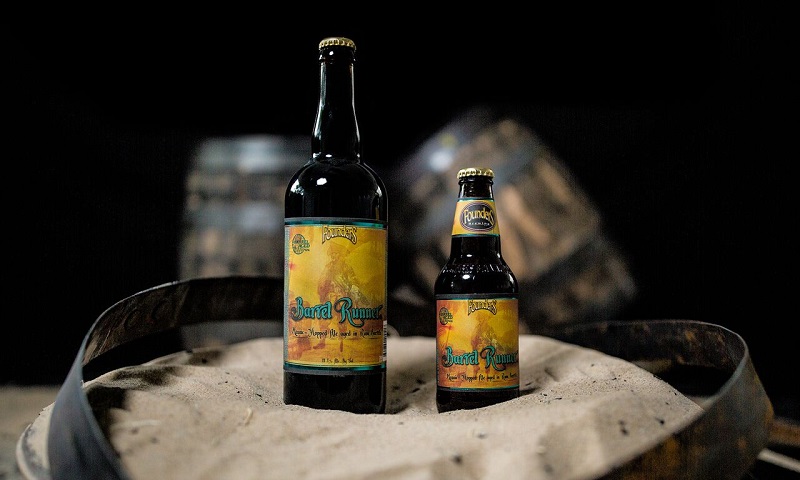
(Photo courtesy Founders Brewing Co.)
(Press Release)
GRAND RAPIDS, Mich.–Founders Brewing Co. announced today that they will release Barrel Runner as the fourth installment in the 2018 Barrel-Aged Series. Barrel Runner, a mosaic-hopped ale aged in rum barrel-aged is preceded by Dankwood, Backwoods Bastard and KBS in the series. This is the first time the brewery has released a rum barrel-aged beer in package.
“I drink tiki cocktails probably more than I should and looked to them for inspiration when creating Barrel Runer,” said Brewmaster Jeremy Kosmicki. “You get a lot of bright, tropical character from the abundance of Mosaic hops plus a nice kick of oak and rum from the barrels. Add a tiny umbrella and you got yourself a beer perfect for enjoying poolside.”
Inspiration for barrel-aged beers can come from the most unexpected places and Barrel Runner is proof of that. Sweet and hoppy, rich and bright – this rum barrel-aged imperial IPA brewed with Mosaic hops will make you believe you’re in the tropics. 11.1% ABV, Barrel Runner will be available in 4-packs of 12 oz bottles and 750mL bottles beginning in June through August. It will have an SRP of $14.99/4-pack and $11.99/750mL bottle. Fans will be able to find Barrel Runner in both Grand Rapids and Detroit taproom locations beginning on June 22, 2018.
About Founders Brewing Co.
Established in 1997 by two craft beer enthusiasts—Dave Engbers and Mike Stevens—with day jobs and a dream, Founders Brewing Co. brews complex, in-your-face ales, with huge aromatics and tons of flavor. Founders ranks among the top 10 largest craft breweries in the U.S. and is one of the fastest growing. The brewery has received numerous awards from the World Beer Cup and the Great American Beer Festival and RateBeer and BeerAdvocate users often rate its beers among the best in the world. Located in downtown Grand Rapids, Michigan, Founders is a proud member of the Michigan Brewers Guild. For more information, visit foundersbrewing.com or follow Founders on Twitter, Facebook,Instagram and YouTube.
About the Barrel-Aged Series
Crafting legendary barrel-aged beers is an exercise in patience. We start by brewing complex, world-class beer worthy of time in a barrel. Then, our experience and years spent mastering our craft means we know exactly when it’s been aged to perfection. After one sip, you’ll know – it was worth the wait.
The post Founders to Release Barrel Runner, a Rum-Barrel-Aged Ale appeared first on All About Beer.
]]>